



Featured image: A Tool To Deceive And Slaughter” (2009) Caleb Larsen
Accelerationism came to prominence in 2013 with Nick Srnicek and Alex Williams’s hashtag-titled manifesto. A cloud computing-era spin on the old Marxist argument that we first need to perfect capitalism in order to transcend it, its lineage is fleshed out in a new book from Urbanomic. Urbanomic claim (among others) Nick Land’s skynet midwifery, J.G. Ballard’s science fictionalization of culture, and Marx himself as precursors to Accelerationism, establishing it as a serious anti-humanistic response to the challenges that humanity faces if it is to avoid extinction. Similar to Christine Harold’s strategy of “intensification“, Accelerationism calls for us to appropriate the value of capital’s developments and transform them materially into something else rather than attempt to resist them head-on or refuse them in our hearts.
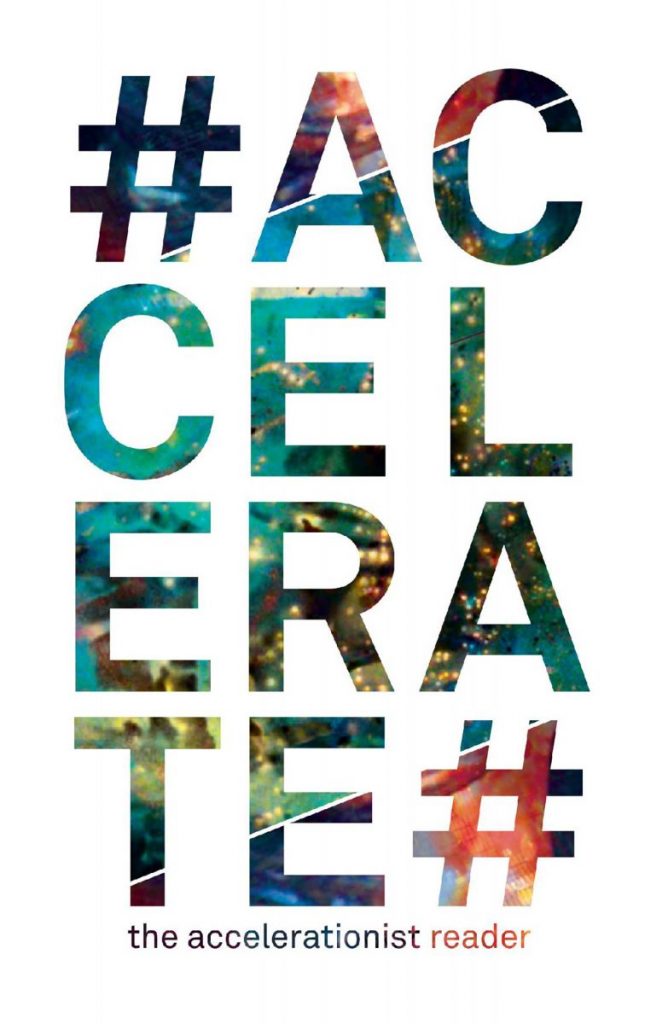
Bitcoin is an example of an accelerationist technology. It uses Internet-scale computing resources to rebuild social bonds by destroying the requirement for them in monetary exchange. You don’t have to know me or trust me or any third parties to receive money from me in the form of Bitcoins. You just have to trust the algorithms that very publicly operate the Bitcoin network. The new Ethereum project takes the blockchain technology behind Bitcoin and generalizes to contracts for purposes other than just the transfer of money, although of course those contracts can involve payments. Ethereum contracts exist as a distributed database of small programs and their state that resembles nothing so much as an economic LambdaMOO. There’s a good guide to their promise and potential pitfalls in the talk “Ethereum: Freenet or Skynet ?” by Berkman Center Fellow Primavera Di Filippi.
Smart contracts and smart property, which uses smart contracts to identify and control ownership of physical resources, were first described by Nick Szabo in the 1990s. Smart contracts are “smart” because they are implemented as computer code rather than as legal documents. Real world examples include vending machines, in which a contract to purchase goods is encoded into the simple software that dispenses carbonated drinks when you insert the correct money, Boris Bikes, RFID card payments for photocopies, and car hire schemes that unlock vehicles and track their use with QR codes. Would-be rentiers who try to launder their ambitions with the warm fuzziness of “sharing” are salivating at the prospect, as are the incorrigible snake oil merchants of DRM, but that is not what concerns us here.
Smart contracts and smart property for art already exist. The artwork “A Tool To Deceive And Slaughter” constantly re-sells itself on eBay. The GIF ownership service “Monegraph” uses the NameCoin system to track notional ownership of instances of infinitely reproducible digital art. These are extensions of pre-digital art contracts such as certificates of authenticity or ownership for conceptual and immaterial artworks. They show a way for art to continue producing a useful critique of property and social relations under technoculture, and for new technology to feed art’s ongoing critique of its own production and nature. I wrote about this in “Artworld Ethereum – Identity, Ownership and Authenticity“, which provides code examples demonstrating how simple it is to implement some of these examples with technology dedicated to smart contracts.
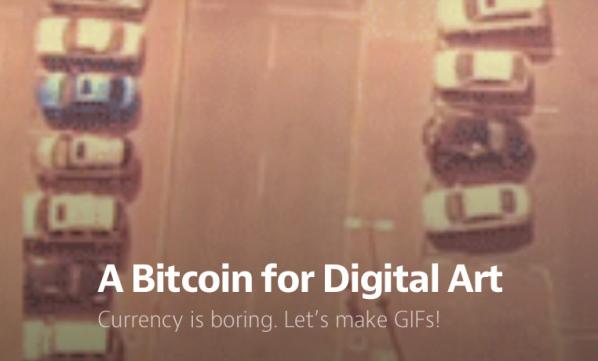
Like Bitcoin, smart contracts and smart property do not require social trust to build social value, just running code. They have very limited functionality, being unable to check RSS feeds on the Internet for information for example as that information might be tampered with. This raises the question of how individuals can be encouraged to provide valid real-world information to smart contracts rather than just entering the values that will immediately profit them the most. Capitalist economics answers this with the concept of incentives. Value, and values, can be determined by the behaviour of individuals in markets in response to economic incentives. And smart contracts are intended to make markets more efficient.
I would like to apply this agoric approach to truth to the crisis of art criticism in the face of aggregation that I identified in “The Proletarianization Of Art Criticism“. Individuals can be motivated to publish defensible aesthetic and art critical opinion in novel ways via smart contracts. I am not proposing an automated or purely algorithmic art criticism here: human activity is the core of this approach. Nor am I proposing an Amazon Mechanical Turk-style exploitation of affective labour. Rather I am proposing an Accelerationist approach, using the technology of digital capitalism to rebuild the social flows that it has destroyed.
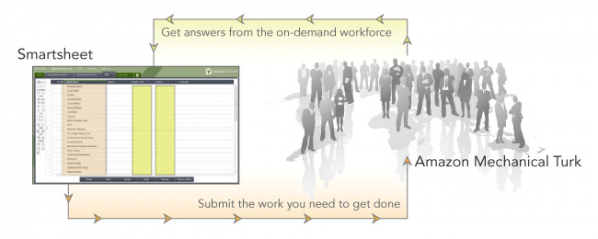
Art is no stranger to the idea of markets, the artworld consists of one of the least regulated and therefore in theory one of the purest markets. But even ignoring the opacity and corruption of the art market, there is a problem with taking a direct approach to the art market as an arbiter of artistic value. As David Galenson‘s 2008 study of aesthetic value and market price showed there is a problem in using pure market mechanisms to establish the value of art: many “great works” have either never been auctioned or have not been to market in decades or even centuries.
I therefore propose three different approaches to art criticism via smart contracts. For work exposed to the market, the mechanisms used to price shares and other financial assets can be used. For work with less exposure, SchellingCoins and prediction markets can work alongside these mechanisms via proxies.
The prices of financial assets, stocks and shares or contracts for commodities for example, are set using a system of derivatives. Financial derivatives gained a bad reputation following their role in the global financial crash of 2008. By 2011 the notional value of the derivatives being traded was almost ten times the total GDP of planet Earth. And their automation by algorithmic high frequency trading is being increasingly scrutinized by regulators.
There are many different kinds of derivatives: short and long options, futures and exotics for example. But in theory at least their function is simple and beneficial. They enable individuals to profit by expressing whether they think a financial asset is over- or under-priced. This incentivizes them to act on this information. The resulting sharing of information and correction of prices benefits society.
Non-physical ownership, sponsorship, crowdfunding, dedications and more exotic value relationships to physical works and, crucially, to works that have not or will not be sold and to unownable digital art can be represented by smart contracts. These can then be treated as the underlying assets of derivatives, also represented as smart contracts, in whole or again crucially in fractional parts or shares. Buying and selling derivatives of shares in digital artworks, and particularly going short or long on them, represents a critical position on their worth. Where the underlying asset does not represent actual ownership of the artwork, we are closer to a prediction market than a financial market. But if the assets themselves attract prestige or value regardless of their proxy status they may become art objects in themselves.
Art criticism in such a market is a matter of financial investment and returns. Critics express their opinion of art, artists and artistic trends by buying and selling different kinds of derivatives at different times. If they are shown to be correct over time, the market will reward them. Derivatives are a prime candidate for implementation as smart contracts, there is already a project to create a standard language of (non-aesthetic) derivative smart contracts.
Since Ethereum contracts have no direct access to the outside world (or the Web), contracts that require information about the outside world must access it through intermediaries. This means that contracts must trust those intermediaries, and if it is more profitable for them to lie to the contracts that creates a problem. To remove this requirement of trust we can use a system that rewards people for independently supplying information that accurately reflects the true (or most likely) state of the world.
A SchellingCoin is an Ethereum contract that allows people to send it messages registering their opinion about (for example) the current temperature in Berlin or exchange rate between dollars and yen. Those that set the majority view are rewarded for doing so, similarly to the operation of a prediction market. But how do they know which value to choose? The game theory concept of a focal point, or Schelling point, is an answer to a question that people who cannot communicate will give independently because it seems natural, appropriate or special. SchellingCoins reward people who give the consensus answer to a question, and people can determine the right answer by converging on a Schelling point. For real world phenomena, such as temperature or exchange rates, the Schelling point is likely to be the correct answer. SchellingCoins can be implemented as smart contracts, removing the need for a trusted entity to run them.
Schellingcoins are designed to address external, quantitative phenomena. Opinions regarding cultural works are personal and qualitative, and spontaneous reactions to cultural works are even more so. This is different from the commonly expressed quantitative values that the SchellingCoin proposal requires. To adapt SchellingCoins to cultural criticism we must adopt the methods of collective intelligence and the digital humanities and use some tricks to turn personal opinion into cultural appraisal.
Collective intelligence algorithms work well with star rating systems and tags. These are popular methods for rating books, films and music on ecommerce and review sites. They can be represeented, aggregated and extrapolated from easily by software, which makes them ideal for representing opinion in SchellingCoins. There are risks in using such systems, as the low rating of the film “Gunday” on IMDB shows, but they are easy and accessible to use.
Digital Humanities approaches often involve counting the frequency of words in texts or other unstructured phenomena. The results of binary checks or of counts can be applied to Schelling coins. For example, whether an artwork appears on CAD or Rhizome or not, or whether the words “blue” or “postbinary” appear the most in reviews about it on major review sites can be reported via further SchellingCoins or via trusted feeds or oracles.
To turn these approaches into a SchellingCoin, we do not ask what people think of an artwork. We ask them what they think the average reviewer will think of the artwork (or to protect against gaming, we ask them to predict the curve for all the star ratings for the work). Given the theory of focal points, the most likely answer is the one that people suspect will be true.
Cultural SchellingCoins can therefore function as aggregators of opinion-about-opinion-about artworks, producing qualitative but consensual evaluations and critiques of works of art that contain more information than purely price-based mechanisms. Using SchellingCoins to aggregate opinion about other schellingcoins, Meta-SchellingCoings, can provide more general cultural critique.
To turn reviews into art criticism with a longer or broader perspective we can ask people not what the current state of reviews of the artwork but about what they will be in a year’s time, five years’ time, etc. How highly starred will they be and what tags/words will be used to describe them? Will the work (or the artist) be used as a point of comparison in reviews and articles? Will it (or they) still be being exhibited or purchased, and in what kind of galleries? How much will the work sell for, or in the absence of sales how many people will visit it at exhibitions? Will the artist still be working in that style, or how will their work have changed?
Each prediction can be represented as a security in a prediction market, and the current price of that security can be interpreted as the probability of that prediction. For example, a prediction market security might reward a hundred Satoshis or ten points if a particular artist has a headline show at Tate Modern. If you think there’s an 80% chance of that happening, you can pay up to 80 Satoshis or 8 points for the security representing that prediction. If you’re right you gain in return for improving the market, if you’re wrong you lose instead. There is evidence that prediction markets are successful, although they have been banned as a form of gambling in the US and the Pentagon’s 2003 attempt at a political prediction market was quickly labelled a “terrorism futures market” by the press and taken offline.
There is already a successful cultural predicton market, Hollywood Stock Exchange, where the price of “shares” in actors, directors and movies function as a prediction of their performance at the box office. The art market itself can be considered a kind of hybrid prediction market, but separating out that predictive function into a pure prediction market concentrating on critical evaluation can remove distortions that result from manipulation of the secondary market and solve the problem of representing critically valuable artworks that aren’t part of the art market.
It’s also possible, as with Hollywood Stock Exchange’s use of directors and actors as well as movies, to have prediction markets for other artworld entities. Not just artists and galleries, but movements, styles, genres, subject matter, even formal and aesthetic properties such as colours can be represented as securities in a prediction market. Buying and selling them can help set a shared understanding of their potential and impact.
Prediction markets can be represented as Distributed Autonomous Organizations (DAOs) on Ethereum’s blockchain, free from central control. DAOs present an opportunity to re-think and re-implement organizations on the blockchain. As well as markets they can be used to manage events, publications, co-operatives and educational or artworld institutions on various organizational models in a public and transparent way.
Cultural SchellingCoins, Artistic Prediction Markets and Aesthetic Derivatives are Accelerationist technologies for art criticism. Not necessarily for art criticism of the kind that survives online after being exiled from print media. Rather a functional equivalent to it that recaptures its lost authority in the form of a relationship between individuals and artistic production that exerts a guiding hand on its reception and direction. As they represent an emergent ontology of art and aesthetics manipulating these technologies, whether through technical or social means, is itself art and art criticism.
The text of this essay is licenced under the Creative Commons BY-SA 4.0 Licence.
Featured image: Image from the movie ‘Frankenstein Conquers the World’ directed by Ishirō Honda, a 1965 Kaiju film.
“Nature builds no machines, no locomotives, railways, electric telegraphs, self-acting mules etc. … They are organs of the human brain, created by human hand; the power of knowledge, objectified.” [1] Marx (1857-8)
This writing roots out a few ideas concerning science and technological determinism and humanity’s bond with digital media and social networks. The themes are covered in terms loosely as to what they may symbolize. It looks at our fears relating to technology, human-machine relations, cyborgs, theories in cyber-culture, classical and SF literature and contemporary art practices across the fields of media art, hacktivism, activism, feminism and cyberpunk.
Mary Shelley’s Frankenstein is the focus for this text but it also brings into the mix, Greek mythology and Prometheus – the Titan, and what the myth symbolizes, asking, in what form does he exist in the world today? It is a playful assemblage of unresolved contemplations that have been sitting around asking for light in the back of my mind. This is a stripped down version of the original study about mythology, technology, fear and revolution.
Humans have always exploited the raw materials this planet has to offer, and has the power to change the nature of things, whether it is physical or virtual. With constant re-edits and enhancements we transform everything we touch and this is all part of our evolutionary mutation. [2] The word ‘technology’ originally comes from the Greek word tekhne, meaning art and craft, the making of useful or good things. The ‘ology’ part means to discuss something or a branch of knowledge and common form. In Greek Mythology Prometheus was a demigod and a Titan worshiped by craftsmen. “In Greece the Titans were ultimately honoured as the ancestors of men. To them was attributed the invention of the arts and magic.” [3] (Graves 1964)
First, we begin with an apocalyptic vision of what could be and what it looks like when something strange occurs in the oceans. In July 2011, an article in the International Business Times featured a phenomenon we’d normally expect in a science fiction novel or movie. The headline read “Millions of Jellyfish Invade Nuclear Reactors in Japan, Israel” [4] Then the Reuters news web site mentions another jellyfish invasion at a Scottish nuclear power plant, in Torness. “An invasion of jellyfish into a cooling water pool at a Scottish nuclear power plant kept its nuclear reactors offline on Wednesday, a phenomenon which may grow more common in future, scientists said.” [5]
On whether this occurrence is significant and poses future threats, the International Business Times said, “The several [power plant] incidents that happened recently aren’t enough to indicate a global pattern. They certainly could be coincidental, Monty Graham, a jellyfish biologist and senior marine scientist at the Dauphin Island Sea Lab off the Gulf Coast of Alabama stating, told LiveScience.” [7] However, some say jellyfish may be the only species worth fishing in European waters if trends in overfishing are allowed to continue. In an article in the Telegraph in 2008, it said, “scientists have said that unless the system is completely overhauled fish stocks will continue to deplete to the point of extinction by 2048, leaving consumers little option but to eat jellyfish or the small bony species left behind at the bottom of the ocean.” [8]
In September 2013 another mass of jellyfish forced one of the world’s largest nuclear reactors to shut down. The Operators of the Oskarshamn nuclear plant in Sweden had to scramble one of their three reactors after tons of jellyfish clogged the pipes that bring in cool water to the plant’s turbines. “By Tuesday, the pipes had been cleaned of the jellyfish and engineers were preparing to restart the reactor, which at 1,400 megawatts of output is the largest boiling-water reactor in the world.” [9]
“New research, published in the Proceedings of the National Academy of Sciences, shows that the rise in jellyfish populations may not only be aided by climate change, but is also contributing to it by making oceans more acidic, thereby disrupting their function as carbon sinks.” [10] (Land 2011)
Since the Chernobyl disaster in 1986 trust of a state’s handling of dangerous technology has taken a dive. We need only to look at Japan’s recent experience of technological disaster with their nuclear power stations. This brings us to the notion of risk and what this means. In the 19th Century risk was no longer about nature, it changed, it extended to us humans and our conduct. “This extension was due in part to the singular appearance of the accident, a kind of mix between nature and will.” [11] (Ewald 1993) […] Thus “no progress without associated damages.” [12]
Gareth Edwards, director of the 2014 Godzilla movie, starts with a 10 minute recap of “nuclear bomb tests from Bikini Atoll featuring voluminous apocalyptic mushroom clouds and a full-blown Fukushima-like nuclear power meltdown.” [13]

Since the 19th century fears about technology and the notion that scientists are meddling with creation itself has been in the public’s consciousness. Many view Mary Shelley’s Frankenstein as triggering these long-term concerns. Of course, these fears are subjective, but also include people’s concerns about not having control over how technological decisions are reshaping society. After all, many lives have been lost due to brilliant uses of technological advancement made specifically for the act of killing many, as with the development of nuclear and biological weapons.
“Two international treaties outlawed biological weapons in 1925 and 1972, but they have largely failed to stop countries from conducting offensive weapons research and large-scale production of biological weapons.” [14] (Frischknecht 2003)
Using biological and chemical weapons was condemned by international declarations and treaties, notably by the 1907 Hague Convention respecting the laws and customs of war on land. Efforts to strengthen this prohibition resulted in the conclusion, in 1925, of the Geneva Protocol, which banned the use of asphyxiating, poisonous or other gases, usually referred to as chemical weapons, as well as the use of bacteriological methods of warfare. [15]
“Let us now consider what happens when you make the epistemological error of choosing the wrong unit: you end up with the species versus the other species around it or versus the environment in which it operates.” [16] (Bateson 1972)

Mary Shelley’s Frankenstein has given us much to chew on, ranging across gender politics and history, including symbolic, political, psychological and social themes. Shelley was the daughter of writers Mary Wollstonecraft and William Godwin. Godwin is one of the forefathers of the anarchist movement and most famous for two books published within one year: An Enquiry Concerning Political Justice, an attack on political institutions, and Things as They Are; or, The Adventures of Caleb Williams, a novel that attacks aristocratic privilege, but also is the first mystery novel. Based on the success of these publications, Godwin was a prominent figure in the radical circles of London in the 1790s. [17]
Mary Wollstonecraft was a writer, philosopher, and advocate of women’s rights. During her brief career, she wrote novels, treatises, a travel narrative, a history of the French Revolution, a conduct book, and a children’s book. Wollstonecraft is best known for A Vindication of the Rights of Woman (1792), in which she argues that women are not naturally inferior to men, but appear to be only because they lack education. She suggests that both men and women should be treated as rational beings and imagines a social order founded on reason. Wollstonecraft died at the age of thirty-eight, ten days after giving birth to her second daughter, leaving behind several unfinished manuscripts. [18]
Mary Shelley’s publication, Frankenstein or The Modern Prometheus published in 1818, was perhaps the earliest representation of science fiction but it was also a gothic novel. Shelley appropriated the various influences and sources available to her at the time. Her novel is an assemblage of discoveries in science and technology, societal change and political upheavals, mixed with personal interests. In the 19th Century the Romantic poets, artists and writers Lord Byron, Percy Shelley and William Wordsworth explored ideas grounded in their shared rejection of Christianity. Percy Shelley in 1811, declared his rejection of a greater all-powerful being in The Necessity of Atheism saying, “It is easier to suppose that the Universe has existed from all eternity, than to conceive a being capable of creating it.” [19]
In 1817, Mary married Percy Shelley who became her second husband. They enjoyed debating many ideas together and had a passionate relationship. In the summer of 1816, a year before their marriage, Mary and Percy visited Claire Clairmont (Mary’s stepsister) in Switzerland, and also met Claire’s new lover Lord Byron and he was accompanied by a physician called John Polidori. During their stay at a nearby mansion Byron was renting next to the shore of Lake Geneva, they became good friends. Together, they all read volumes of German ghost stories, usually when the weather was too stormy for leisurely walks. Inspired by these ghost stories, Lord Byron issued a challenge for each of them to write their own tales of horror. All immediately began writing them out, however Mary struggled for inspiration taking Byron’s provocation seriously and listened to the various conversations the others had on the subject. Then, her ideas began to evolve once she had discussed at length the radical works of Dr. Erasmus Darwin with Byron. Darwin had experimented with electrical stimulation on dead matter, preserving a piece of vermicelli in a glass case “and by some extraordinary means it began to move…” [20] Hindle (2003)
Both of the Shelley’s were fascinated by Sir Humphry Davy’s publications Elements of Chemical Philosophy written in 1812 and A Discourse, Introductory to a Course of Lectures on Chemistry, 1802. Undoubtedly “the most celebrated and iconic figure of this entire Chemical Age was Sir Humphry Davy (1778–1829), who used his chemical discoveries, his wildly popular lecture series, and his general writings on science, to turn the ‘Chemical Philosopher’ (the term scientist not being coined until 1834) into a figure of social and cultural importance in a quite new way.” (Holmes 2012) more about Davy here link.
Percy Shelley in his youth “bought and experimented with chemical apparatus and materials and read treatises on magic and witchcraft, as well as more modern scriptures detailing the miracles of electricity and galvanism. [21] Mary Shelley was fascinated with the idea of things being brought back to life via electricity, and also studied the works of the Italian physiologist Luigi Galvini. [22]
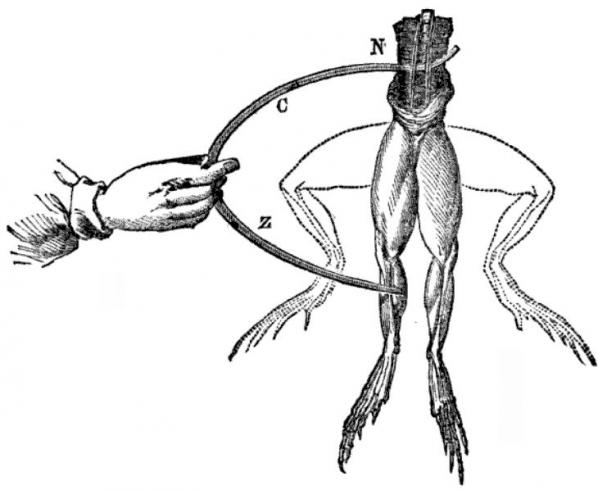
Galvini’s experiments convinced him that ‘animal electricity’ resided inside animal creatures. He observed that when using a circuit consisting of a piece of metal attached to the legs of a frog, convulsions would occur. He assumed the spasmodic jolts were an electrical fluid from within the nerves and muscles of the creature. This led to his announcement that he had brought the limbs of the animal back to life. An Italian physicist Alessandro Volta, who in 1800 made the Voltaic Cell, very soon disproved this. The SI unit of voltage is named after him. [23]
Even if creating life out of dead body parts is an unlawful and immoral proposition. Dr. Frankenstein has the whole of history and an extremely well heeled patriarchal system on his side. However, Shelley’s attack is not against all men but a particular type of man. “The first type is the Promethean scientist who uses nature to gain power and abusively alter it, and the second type is the ‘good’ scientist, who respects and celebrates nature and resists the temptation to fundamentally change the way it operates.” [24] (Munteanu 2001) Passages in Frankenstein reveal “Percy Shelley as the initial model for its ultra-ambitious hero, quite apart from the fact that Victory, Frankenstein’s first name Shelley took for himself a number of times in boyhood and later.” [25] (Hindle 2001)
The psychology expressed through the protagonist Dr. Victor Frankenstein is as a man who manages to transform his extreme, radicalized and revolutionary ideals into the form of a monster. This is a personal characterization informed by Shelley’s own experience with Percy Shelley and her father William Godwin. And, even though her love for them is evident, she also had deep concerns about their shared, revolutionary radicalism. Mary Shelley was well versed in the writings of her father Godwin and her mother Mary Wollstonecraft, as was Percy. They both systematically studied the works of Thomas Paine, and this included even conservative thinkers such as Edmond Burke, Abbe Barruel, John Adolphus. [26] (Sturrenburg 1982) Yet, Shelley’s “world view is less political than Godwin’s and Burke’s; it is also far more labyrinthine and involuted when it comes to telling us why things fall apart.” [27] (Ibid)
Prometheus 2.0.
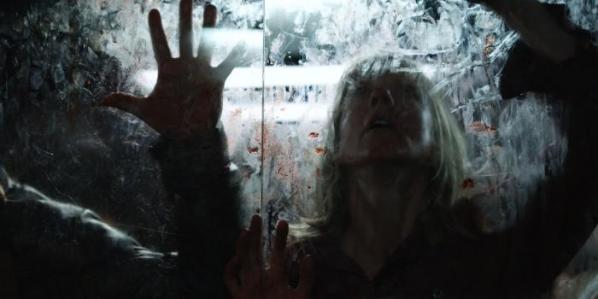
Mary Shelley challenged the cliché narrative of the hero and his belief in the absolute. Her portrayal of Dr. Frankenstein as an egocentric obsessive who will stop at nothing until he completes his mission in bringing his creature to life; represents man’s blind quest in pushing on until the precarious end, at whatever cost. For Shelley, this indicates evident tensions between men and women and their scripted, dualistic roles. This may be an obvious feminist critique now, but in Shelley’s time it was a very different story. Wait a minute! Who am I kidding? The recent interview by Furtherfield’s Ruth Catlow on the New Criticals web site, with the multiple identity female artist(s) Karen Blissett tells us that we are still stuck in this arcane world of male domination. For Karen Blissett, her modern day Frankenstein’s exist in the everyday boardroom in managerial positions as they ‘move forward’ in pushing the top-down, and visionless austerity packages into all aspects of our everyday lives.
“Karen Blissett categorises her most recent artwork Senior Management, An Inspirational Guide, as art for offices […] they demand the impossible. Not in a good way, and not for the enrichment of human futures, but sucking up to power and policy makers – ministers, regulators, corporate leaders – negating their own experiences, demonstrating their loyalty through the implementation of trivial bureaucratic obligations.” [28]
This condition of biopolitics where society is being run by little men affirming their potency through the misleading, heroic trope of managing the life of others can be seen in different areas such as in the military, war, slavery, in education, the media, the economy, religion, technology and science, sex trafficking; on the whole, it is his business to inherit all these power systems from birth. Foucault first mentioned biopolitics on 17 March 1976, during his “Society Must Be Defended” lectures. He described it as a new technology of power and that it exists at a different level, on a different scale, and that it has a different bearing area, and makes use of very different instruments. Foucault’s biopolitics acts as a control apparatus exerted over a population as a whole or, as Foucault stated, “a global mass.” [29]
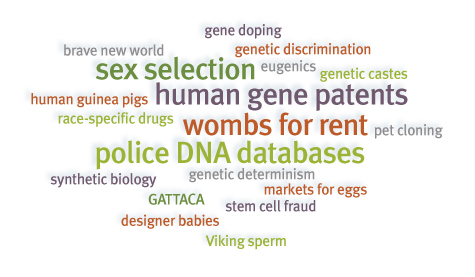
Karen’s monster is neoliberalism, a monster administered by millions of Frankensteins, feeding a globalized monster consisting of networks, machines, weaponry, surveillance, financial control, and elite groups. Keith Fisher in an article called ‘Frankenstein’s Bankers’ on The Global Dispatches web site said “Just as Dr. Frankenstein was responsible for creating a tragic human monster, so are we collectively ultimately responsible for our severely dysfunctional financial system and the activities of its bankers.” [30]
If we take a look at Facebook we can observe that it is an open and free (to use) platform for all, on the Internet. However, the relationship between users and the platforms of Facebook and Twitter are exploitative. In that they treat social media users as consumers of technological services and producers of data, commodities, value and profit. As Simon Penny points out in his essay ‘Consumer Culture and the Technological Imperative’, “One of the classic techno-utopian myths of computers is that access to information will be a liberation, and the results will be, by definition, democratizing.” [31] (Penny 1995) His critique on networked technology and the dreams it once promised us, can now be clearly seen as in dire trouble. Everyday there is a new story about how NSA and Prism are spying on Internet users on mass, Julian Assange sees this as the militarization of cyberspace. [32] (Assange 2012)
SF can pull us into imaginary settings, in the past, present and future, while relating to scientific or technological advances. Some SF looks at major social and environmental changes or portrays space and time travel, and life on other planets. SF has been a generous gift to the world via the minds of original thinkers, showing us a playful side in dealing with the social contexts of technological determinism. It is a third space or outer region where our imaginations can open up different ways to try and understand scientific and technological impacts on society. It is a place where anything goes whether it relates to reality or not. In contrast to the heroic male warrior who is swashbuckling against a mass of aliens to save the world from total extinction or a large-scale catastrophe. Women’s SF has mainly expressed its cultural identity by using “the figure of the alien to describe systems of difference and domination,” [33] (Flanagan & Booth 2002) and Women’s SF and cyberfiction combines exploring the creation of an alien, as the ‘other’. Representing ‘her’ own collective states of alienation in a world consisting of structures maintaining patriarchal dominance, with the female as a techno-product for men to control for their own sexual, financial, administered and power related needs.
Women’s cyberfiction deals with inclusion of the female in societal frameworks where traditionally the male’s tools for engineering, building and use of machinery typically reflect their own practical needs and an industrial and techno-culture designed for them selves. “This dominant class, which is exclusively white and male, operates on a logic of profit and maintaining their control over society, […] it is also shared by white working-class and minority men who are not so well served by it…” [34] (Benston 1992) While many women have jumped into the SF and cyberfiction field they have somehow bypassed the spectacle of techno-utopian rhetoric.
Alongside the growth of technology we are experiencing similar anomalies as with the jellyfish invasions. It is a period where fantasy and reality and the boundaries which once separated them, are breaking up. It’s as if the natural world has now caught up with it’s own version of a post-modern realization. Reflecting back at us a psychosis into material form, the dysfunctional and nihilistic relationship we’ve had with it since our emergence as a race on this planet. Monsters have always demarcated the limits of human folly, telling us when we have pushed things too far. Whether in the form of Godzilla, a nuclear explosion, mutant jellyfish, a war, mining the earth’s resources, and drone technology, spying networks or Frankenstein; they are poignant symbols screaming back at us a painful message. As all the disasters humanity has created pile up, if nature could talk to us in another way and not in the form of our own making – the language of disaster. What would it say and would we even listen?
However, some are recognizing the cultural value of neoliberal monsters. In an interview with Tatiana Bazzichelli on Furtherfield, we discussed her publication Networked Disruption: Rethinking Oppositions in Art, Hacktivism and the Business of Social Networking. Bazzichelli puts forward the notion of disruptive business and that it “becomes a means for describing immanent practices of hackers, artists, networkers and entrepreneurs”, and sheds “light on two different but related critical scenes: that of Californian tech culture and that of European net culture – with a specific focus on their multiple approaches towards business and political antagonism.” [35]
“Monsters have always defined the limits of community in Western imaginations. The Centaurs and Amazons of ancient Greece established the limits of the centred polis of the Greek male human by their disruption of marriage and boundary pollutions of the warrior with animality and woman. Unseparated twins and hermaphrodites were the confused human material in early modern France who grounded discourse on the natural and supernatural, medical and legal, portents and diseases — all crucial to establishing modern identity. The evolutionary and behavioural sciences of monkeys and apes have marked the multiple boundaries of late twentieth century industrial identities. Cyborg monsters in feminist science fiction define quite different political possibilities and limits from those proposed by the mundane fiction of Man and Woman.” [36] (Haraway 1991)
Patchwork Girl was a hypertext fiction created Shelley Jackson in 1995. It is a retelling of the story of Frankenstein. The emphasis is about appropriation and transformation and the female monster is completed, or rather assembled by Mary Shelley herself. “The conflict highlights the monster’s nature as a collection of disparate parts. Each part has its story, and each story constructs a different subjectivity. What is true for the monster is also true for us, Jackson suggests in her article “Stitch Bitch: the Patchwork Girl.” “The body is a patchwork,” Jackson remarks, “though the stitches might not show. It’s run by committee, a loose aggregate of entities we can’t really call human, but which have what look like lives of a sort… [These parts] are certainly not what we think of as objects, nor are they simple appendages, directly responsible to the brain” [37] (Hayles 2000)
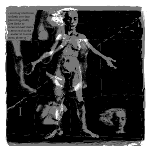
Karen Blissett and Patchwork Girl both express more than one part or selves. Haraway proposes that, “The proper state for a Western person is to have ownership of the self, to have and hold a core identity as if it were a possession.” [38] (Haraway 1991) And that “Not to have property in the self is not to be a subject, and so not to have agency.” [39] (Ibid) Blissett is a living collective of female activists expressing themselves as part of a multitude critiquing male dominance and neoliberalism directly.
So, can we re-mutate ourselves in order to loosen the stranglehold of these neoliberal defaults and forge new or alternative states of agency and psychic freedom? Bazzichelli, says “we should stop looking for the enemy, because who is the enemy today when disruption and its opposition are feeding the same machine?” [40] I do not see it as us feeding the same machine in the absolute sense. Sometimes breaking the loop can be more inline to finding meaning and values with others, and yes this can be difficult. But it does not mean that it’s the wrong thing to do.
For me, Bazzichelli’s proposition is an ideal situation if you are not suffering from pressing societal upheavals. As Blissett points out, there are urgent social situations that need attention. Of course, there are those who’ve fallen so deeply into the void of no return, they will happily serve or become a Prometheus monster without a glimmer of soulful insight. Yet, there is always hope for humanity and the artists and thinkers we’ve explored here have proven this. If this article is about anything it is about how the imagination can forge out new ways in becoming something different than the script we’ve been given. The spirit of the Shelleys, Bazzichelli, the Karen’s, Haraway and Jackson, show us that alternatives are out there available for exploration while at the same time we can still maintain our dignity.
References:
[1] Karl Marx. Grundrisse: Foundations of the Critique of Political Economy. Penguin Classics; New Ed edition (29 April 1993). Martin Nicolaus (Translator). Page 706.
Note: Written during the winter of 1857-8, the Grundrisse was considered by Marx to be the first scientific elaboration of communist theory. A collection of seven notebooks on capital and money, it both develops the arguments outlined in the Communist Manifesto (1848) and explores the themes and theses that were to dominate his great later work Capital. Here, for the first time, Marx set out his own version of Hegel’s dialectics and developed his mature views on labour, surplus value and profit, offering many fresh insights into alienation, automation and the dangers of capitalist society. Yet while the theories in Grundrisse make it a vital precursor to Capital, it also provides invaluable descriptions of Marx’s wider-ranging philosophy, making it a unique insight into his beliefs and hopes for the foundation of a communist state.
[2] Note: The words ‘evolutionary mutation’ refer to ‘technology’ as a default changing process. This includes the constant appropriation and reinvention of human cultures; altering our psychology, perceptions, traits, anatomy, physiology, our DNA, individual and collective behaviour, relations with: objects, machines, work environments, leisure, tools, tribalism, domestic habits and changing attitudes.
[3] Robert Graves. Larousse Encyclopedia of Mythology. Paul Hamlyn, London. 5th Edition, 1964. P.92.
[4] Article. Millions of Jellyfish Invade Nuclear Reactors in Japan, Israel. IBTimes. Jul 09, 2011.
http://www.ibtimes.com/articles/177027/20110709/millions-jellyfish-invade-nuclear-reactors-japan-israel-2011-power-plant-shut-down-unusual-growth-tr.htm
[5] Jellyfish keep UK nuclear plant shut. Jun 29, 2011.
http://www.reuters.com/article/2011/06/29/us-britain-nuclear-jellyfish-i…
[6] Millions of Jellyfish Invade Nuclear Reactors in Japan, Israel (PHOTOS). 9 July 2011.
http://www.ibtimes.com/millions-jellyfish-invade-nuclear-reactors-japan-israel-photos-707770
[7] Ibid.
[8] Jellyfish on the menu as edible fish stocks become extinct. The Telegraph. Louise Gray, Environment Correspondent. 15 Dec 2008.
http://www.telegraph.co.uk/earth/3776788/Jellyfish-on-the-menu-as-edible-fish-stocks-become-extinct.html
[9] Jellyfish Cluster Shuts Down Nuclear Reactor. Sky News, 1 October 2013
http://news.sky.com/story/1148872/jellyfish-cluster-shuts-down-nuclear-reactor
[10] Are we entering ‘The Age of the Jellyfish’? Graham Land. Jun 13th, 2011. Greenfudge.
http://bit.ly/1jOMXrw
[11] Francios Ewald. Two Affinities of Risk. The Politics of Everyday fear. Brian Massumi, editor. University of Minnesota Press. 1993. P.226.
[12] Gareth Edwards, director of the 2014 Godzilla – find link
[13] Ibid P.226.
[14] Friedrich Frischknecht. Human experimentation, modern nightmares and lone madmen in the twentieth century. EMBO Rep. Jun 2003; 4(Suppl 1): S47–S52. Science and Society. http://www.ncbi.nlm.nih.gov/pmc/articles/PMC1326439/
[15] Efforts to ban biological weapons.
The latter are now understood to include not only bacteria, but also other biological agents, such as viruses or rickettsiae which were unknown at the time the Geneva Protocol was signed. However, the Geneva Protocol did not prohibit the development, production and stockpiling of chemical and biological weapons. Attempts to achieve a complete ban were made in the 1930s in the framework of the League of Nations, but with no success.
[16] Gregory Bateson. Steps to an Ecology of Mind. Anthropology, Cybernetics. Publisher: University of Chicago Press. 1972. P491-2.
[17] Bertrand Russell. A HISTORY OF WESTERN PHILOSOPHY And Its Connection with Political and Social Circumstances from the Earliest Times to the Present Day. Chapter VI. The Rise of Science. Page 512. Allen & U.; New impression edition (Dec 1961).
[18] Percy Bysshe Shelley. The Necessity of Atheism. C. and W. Phillips in Worthing. 1811.
[19] Note: Erasmus Darwin (12 December 1731 – 18 April 1802) was an English physician who turned down George III’s invitation to be a physician to the King. One of the key thinkers of the Midlands Enlightenment, he was also a natural philosopher, physiologist, slave trade abolitionist, inventor and poet. His poems included much natural history, including a statement of evolution and the relatedness of all forms of life. He was a member of the Darwin–Wedgwood family, which includes his grandsons Charles Darwin and Francis Galton. Darwin was also a founding member of the Lunar Society of Birmingham, a discussion group of pioneering industrialists and natural philosophers. http://en.wikipedia.org/wiki/Erasmus_Darwin
[20] Maurice Hindle (Editor). Frankenstein or The Modern Prometheus. Mary Wollstonecraft (Godwin) Shelley. Publisher: Penguin Classics (May 6, 2003). Revised edition, Maurice Hindle (Editor) Author’s Inroduction. P. 8.
[21] Ibid P.8.
[22] Note: Luigi Galvani. During the 1790s, Italian physician Luigi Galvani demonstrated what we now understand to be the electrical basis of nerve impulses when he made frog muscles twitch by jolting them with a spark from an electrostatic machine.
[23] Alessandro Volta. Oxford Dictionary of Science. Sixth Edition. Oxford University Press, 2010.
[24] Anca Munteanu. Shelly’s Frankenstein. Commentary by Anca Munteanu Ph.D. Edited by Dr. Stephen C. Behrendt. CliffsComplete published by Hungry Minds 2001. Chapter 3. P.53.
[25] Maurice Hindle. Frankenstein or The Modern Prometheus. Mary Wollstonecraft (Godwin) Shelley. Publisher: Penguin Classics (May 6, 2003). Revised edition. P.XXIV (24).
[26] Lee Sturrenburg. Mary Shelly’s Monster: Politics and Psyche in Frankenstein. The Endurance of Frankenstein. Edited by George Levine and U.C. Knoepflmacher. University of Californian Press. 1982. P.153.
[27] Ibid P.157.
[28] Karen Blissett is Revolting. Interview by Ruth Catlow. New Criticals May 24, 2014. http://www.newcriticals.com/karen-blissett-is-revolting/print
[29] Biopolitics. http://en.wikipedia.org/wiki/Biopolitics
[30] Frankenstein’s Bankers By Keith Fisher. The Global Dispatches. November 26, 2013.
http://www.theglobaldispatches.com/articles/frankensteins-bankers
[31] Simon Penny. Consumer Culture and the Technological Imperative. Critical Issues in Electronic Media. State University of New York Press. Editor, Simon Penny. 1995. P.63.
[32] The Militarisation of Cyberspace. Publication — Cyperpunks: Freedom and the Future of the Internet. Julian Assange, Jacob Appelbaum, Andy Moller-Maguhn and Jereme Zimmerman. Or Books, New York and London. (2012) P.33.
[33] Mary Flanagan and Austin Booth. Reload: Rethinking Women and Cyberculture. The M.I.T Press. Cambridge, Massachusetts, London England. 2002. P.31.
[34] Margaret Lowe Benston. Article 1.2. Women’s Voices/men’s Voices: Technology As Language. Publication – Inventing Women: Science, technology and Gender. Edited by Gill Kirkup and Laurie Smith Keller. Polity Press, 1992. P.35.
[35] We Need to Talk About Networked Disruption, Art, Hacktivism and Business: An interview with Tatiana Bazzichelli. By Marc Garrett – 13/02/2014.
http://www.furtherfield.org/features/interviews/we-need-talk-about-networked-disruption-and-business-interview-tatiana-bazzichel
[36] Donna Haraway. Simians, Cyborgs, and Women: The Reinvention of Nature. Free Association Books. 1991. P.180.
[37] Flickering Connectivities in Shelley Jackson’s Patchwork Girl: The Importance of Media-Specific Analysis. N. Katherine Hayles. 2000.
http://pmc.iath.virginia.edu/text-only/issue.100/10.2hayles.txt
[38] Donna Haraway. Simians, Cyborgs, and Women: The Reinvention of Nature. Free Association Books. 1991. P.135.
[39] Ibid P.135.
[40] We Need to Talk About Networked Disruption, Art, Hacktivism and Business: An interview with Tatiana Bazzichelli. By Marc Garrett – 13/02/2014.
http://www.furtherfield.org/features/interviews/we-need-talk-about-networked-disruption-and-business-interview-tatiana-bazzichel
[41] Karen Blissett is Revolting. Interview by Ruth Catlow. New Criticals May 24, 2014. http://www.newcriticals.com/karen-blissett-is-revolting/print
2 March: 1812 Crossing of the Berezina scenario for Richard Borg, Commands & Colors Napoleonics.
6 April: Mac Gerdts, Imperial 2030
4 May: Bruce Quarrie and Russell King, Apokalypse 1945
1 June: Ty Bomba and Joseph Miranda, Russian Civil War 1918-1922
13 July: Greg Costikyan, Pax Britannica. CANCELLED
3 August: H.G. Wells, Little Wars.
“Political theories are only made to die in the war of time. Like military units, they must be sent into battle at the right moment; and whatever their merits or insufficiencies, they can only be used if they’re at hand when they’re needed.” – Guy Debord.
Clausewitz v. Jomini at the Ludic Science Club. 1812 Crossing of the Berezina scenario for Richard Borg, Commands & Colors Napoleonics.
The first of 5 monthly board game ‘Ludic Science Club Sunday Sessions’ organised by Class Wargames at the Furtherfield Commons. This Sunday join writer and academic Dr Richard Barbrook with Class Wargame collaborators for the 1812 Crossing of the Berezina scenario for Richard Borg, Commands & Colors Napoleonics. All Welcome.

Dr Richard Barbrook is the author of Imaginary Futures: From Thinking Machines to the Global Village. In 2008 it won the Marshall McLuhan Award for Outstanding Book of the Year in the Field of Media Ecology. He is a founding member of Class Wargames and co-wrote the script to the group’s film: Ilze Black (director), Class Wargames Presents Guy Debord’s The Game of War.
6th April: Mac Gerdts, Imperial 2030.
4th May: Bruce Quarrie and Russell King, Apokalypse 1945.
6th July: Greg Costikyan, Pax Britannica.
3rd August: H.G. Wells, Little Wars.
All sessions begin at 2.00pm.
To book sessions please contact: ale AT furtherfield DOT org
Furtherfield Commons,
Finsbury Park,
London N4 2PF
To Visit view link – http://www.furtherfield.org/gallery/visit
My Voice Means is a workshop that gives participants an opportunity to listen mindfully to the sound of their own voice, to discover the many layers of its meaning, and to discover how this process can be expanded by means of technology.
In a three hour session you will:
Cost: £20
To book a place visit http://tinyurl.com/mnwbj6h or contact info@contemplatech.net
Delivered by Contemplatech, a creative collaboration by Ron Herrema and Ximena Alarcón
Featured image: Jane and Louise Wilson – ‘False Positive, False Negative’ (2012 Screen print on mirrored acrylic)
The Negligent Eye the Bluecoat Liverpool Sat, 08 Mar 2014 – Sun, 15 Jun 2014 http://www.thebluecoat.org.uk/events/view/exhibitions/1971
Featuring artists: Cory Arcangel, Christiane Baumgartner, Thomas Bewick, Jyll Bradley, Maurice Carlin, Helen Chadwick, Susan Collins, Conroy/Sanderson, Nicky Coutts, Elizabeth Gossling, Beatrice Haines, Juneau Projects, Laura Maloney, Bob Matthews, London Fieldworks (with the participation of Gustav Metzger), Marilène Oliver, Flora Parrott, South Atlantic Souvenirs, Imogen Stidworthy, Jo Stockham, Wolfgang Tillmans, Alessa Tinne, Michael Wegerer, Rachel Whiteread, Jane and Louise Wilson.
The Negligent Eye revolves around the way a digitally-native generation of artists – particularly printmakers – are questioning their relation to the digital, using the notion of ‘scanning’ as a kind of mid-state of the creative process of the human-digital hybrid. The show is co-curated curated by the Bluecoat’s Sara-Jayne Parsons and head of printmaking at the RCA, Jo Stockham, and features several works by her graduates, and other artists from around the RCA, such as Bob Matthews and Christiane Baumgartner. “The relationship between the material and virtual worlds is a question, a set of contradictions we are all inside and how technical images exert their influence on our everyday experience is of ever increasing importance.” Jo Stockham.

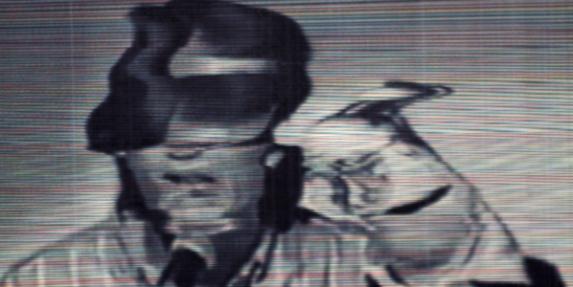
In her article Too Much World: Is the Internet Dead? Hito Steyerl asks what happened to the internet, after it died – that is, in an era of the “post-internet” after it stopped becoming a possibility, even in the midst, because of, and symptomized by, its permeation of everything. Steyerl is a major force in understanding our relationship to digital images, and her use of ‘death’ occurred to me often during viewings of this show and surrounding events, particularly as it could be applied to the post-digital.
So in a sense, I experienced the show as an autopsy of the digital image. From the tragic, simian face looking out from the first ever digital image, taken by Russell Kirsch of his son in 1950, exhibited at two points in the exhibition like an insistent memory. To Marilène Oliver’s figures from her 2003 Family Portrait series where bodies have been evoked as series of horizontal cross-section prints layered on acetate, so that they appear as though stored, but only partially in this world; the exhibition continually references, exemplifies and unpacks the death of its medium.
The post-digital is a paradoxical term – at once assuming the reliance of all contemporary culture in digitality, but also looking past it; affirming the death of a form, while embodying its afterlife. This is what Elizabeth Gossling’s images of a dead comedian says to me, when it is scanned from a computer screen and printed back on to archival paper, with his image waving from behind an ether of static, living in the solid pulp. The best works in this show, Gossling’s included, speak very eloquently about the post-digital, and how artists are motivated into hybrid forms of production, always acknowledging and working in a context of the saturation of the digital.

The notion of saturation, and its implications of the dissolution and liquidity, itself saturates the show: the first work, Maurice Carlin’s monumental print, scrolling down from the ceiling of the vide space is in one sense a spectral ancestor of Monet’s waterlilies, but with gashes and pustules of CMYK colour oozing up from behind the serine blue and greens of the pond, and white pixel-like rectangles plugging up the gaps; London Fieldworks’ 3D image of data collected from Gustav Metzger’s brain while he thought of nothing, is presented on a screen with a trickling sound – perhaps of information leaking inexorably back in?

Marilène Oliver’s glitch-sculpture of body parts fused in the heart of the 3D scan/print machine hang in the chute of the gallery corridor, their surfaces mid-ripple as though submerged; Jo Stockham’s etherized black and white shot of an element of the London skyline, seen perhaps through a teary bus window, but now writhing with red in its afterlife as a veined and depthless skin.

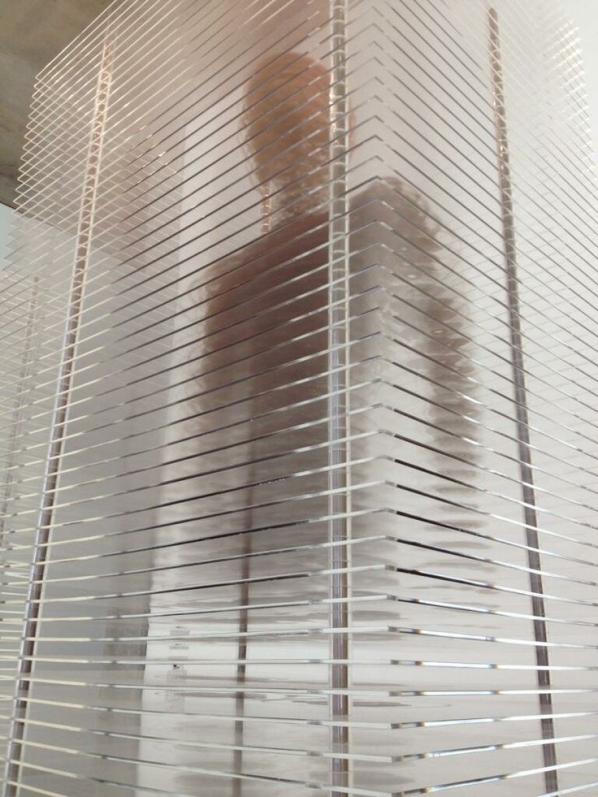
Using damage and error to expose the affectivity of a medium, particularly in the context of the digital is the central mode of Glitch Art. I have already used the term glitch to describe the aesthetic of Marilène Oliver’s sculptures, and the traces of digital-to-digital scan in Gosling’s work and the rich material pixilation of Christine Baumgarner’s inscription of CCTV camera stills into largescale wood prints, also contain these signatures.
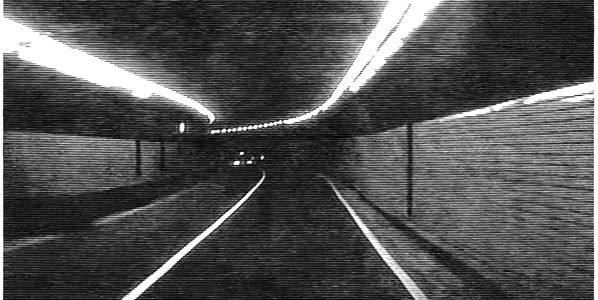
If there is a criticism to be leveled at these admirable and, frankly gorgeous, works. It is in their distance from what Rosa Menkman refers to as the moment(um) of the glitch. In the medium of print-making, the material fact of the object dominates, and with this show, no-matter the stated and playful interest in the ‘between-state’ of scanning, there remains the focus on material production – and therefore an irrefutable commodification.
Prints on archival paper and tempered steel, casts in plaster and large-scale hardwearing plastics, each speak of an appropriation of the tactical and fluid glitch, and its migration into commodifiable form. Maurice Carlin’s large-scale printwork could adorn a restaurant wall, just as Monet’s waterlilies functioned during his era, and Oliver’s sculptures also speak and modernise the language of sculpture as produced for private collections through the ages.
There are works also which say nothing of the ‘post-digital’, such as Imogen Stidworthy’s Sacha, a deeply thoughtful study of a wire-tap transcription ‘artist’ Sacha van Loo. Stidworthy’s enigmatic works are often hard to pin down thematically, and here it feels like the loft-type space of Gallery 3 has been used as an outer limit to the reach of the show. And then there are other works that say nothing at all and lessen the show’s conceptual rigor. I see Jeaneu Project’s peice, and think ‘smudge lawn’. I see a Cory Archangel print and a Rachel Whitereed miniture and their names flash through my consciousness like a Google Glass press release.
Truly though, this is a really refreshingly vibrant and precient show at the Bluecoat, and a great partner to the Mark Lecky exhibition featured at the venue last year in its pressing contemporaneity. The exhibition has also been a fulcrum for a really interesting series of events which have dealt with image production – including a day of talks and presentations, i-Scan, artist talks from contributing artists such as Imogen Stidworthy, and independently curated events such as the second in Deep Hedonia’s excellent Space/Sound series, where artists such as Madeline Hall, Jon Baraclough, Simon Jones and Andy Hunt explored the multiple angles from which digital scanning can be exploited as a performance and av medium. As with the Mark Lecky show, there is something about the context of the Bluecoat, as Liverpool’s most paradoxical space, which delivers an archival retrospective out of the most up-to-date material, and this tension is what pulls appart the body of works before us.
The Rubik’s Cube is not just a forgotten toy from the 80’s. The fact is that it’s even more popular than ever before. You can play with this great puzzle here.
First of 6 articles as part of the Piratbyrån and Friends exhibition at Furtherfield. Mariana Delgado, Coordinator of El Proyecto Sonidero (Mexico), writes about the Polymarchs posters (1980-1990) by Jaime Ruelas. Translation by Tess Wheelwright.
Panther / Jaime Ruelas / Polymarchs. On How We Came To a World of Legend By Mariana Delgado, Coordinator of El Proyecto Sonidero, I met José Luis Lugo in 2009 in the office above the Publicidades Panther print shop in Mexico City. Lupita La Cigarrita introduced us: sonidera, collaborator and number one follower of Sonido La Changa, el Rey de Reyes – the King of Kings. Later we learned from Lupita that José Luis had an important collection of sonidero event posters and flyers. Marco Ramírez, the co-founder of El Proyecto Sonidero, grew enthusiastic.
As soon as we released the book Sonideros en las aceras, véngase la gozadera (roughly Sonideros on the Sidewalks: Bring on the Revelry) in 2012, we began to see what should come next. In 2013 we launched the Proyecto de Gráfica Sonidera, in association with Panther, and in collaboration with draftspeople, poster artists, graphic designers, graffiti writers, sign painters, printers, promoters, collectors and researchers.
We are taken back to the origins of the tropical sonidero movement, which began in the 60s with turntables and LPs – loudspeakers and tweeters set up in the streets, dances thrown in the barrio. Over time various sound systems are added, each with its own crew; soon the multicolored Aztec or robotic lights are streaming. The biggest parties feature close to 50 systems at once, working simultaneously for hundreds of thousands of people. Music is introduced and mixed the Mexican way. Equipment is fiddled with; beats are slowed. Bass rumbles out from walls of speakers. Followers take their places and multiply along with vernacular genres. Transsexual dance clubs form circles on the dance floor; here a family, there a group of insiders – la banda – make their way through the crowd. The mic starts up, amplifying the shout-outs that will circulate the continent on CD and DVD, through streaming, links, posts. From Peñon de los Baños aka Colombia Chiquita to Neza York; from the barrio Tepito aka Puerto Rico to Chimalwaukee, out to all the brothers in Illinois.
In this world, all hatched from La Sonora Matancera. Cumbia and salsa are the queens of a grand court of rhythms. The Virgin of Guadalupe reigns supreme; it’s her congregation. Changó, San Judas Tadeo, and the Santa Muerte share the power thereafter. Epic is important, and family, too. What begins as a passion for Cuba soon builds: music from Colombia, Puerto Rico, Venezuela, Ecuador, Panama, Peru, the Dominican Republic, Buenos Aires, New York… The sonideros leave behind the established Mexican labels and their standardizing limitations, heading out on their own to comb the continent. They become vinyl diggers, import records, discover bands and musicians; they turn into promoters, create record companies and pirate labels, compile mixtapes to disseminate in the street markets and plazas, at parties and on commercial stands, through the internet.
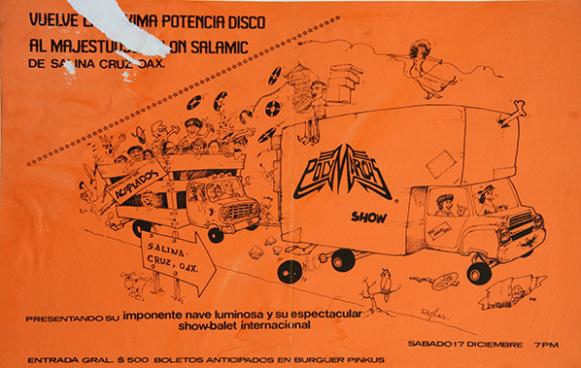
In the margin within – those more notorious neighborhoods of the Distrito Federal – embroidered logo jackets circulate, lending publicity to the sonidos along with their cards, posters, flyers, banners. Nonetheless, fewer and fewer dance parties are thrown. The city government has issued a discretionary ban of sonidero events in public spaces, canceling even traditional dances like the anniversary celebrations of Tepito’s markets. In the outer margins, ringing the DF and beyond, painted walls announce upcoming events and sonido trailers take over the streets. The dances go on.
We aren’t as familiar with the electronic scene, headed by Polymarchs. Our inroad is through the graphic materials comprising the collection Panther has amassed since 1979, which he rightly considers his primary asset. It all began in the Zona Rosa, where he used to go to trade posters, leaflets, stickers. At thirteen he formed part of the Polymarchs crew, coiling cables. Later he became a publicist, promoter, producer. He never stopped his gathering; stacks of paper tower in the office. Hundreds of posters and dozens of original drawings from the golden age of Hi-NRG pass in front of the camera, as José Luis remembers key scenes and events from this world: when they brought Gloria Gaynor to Mexico for the first time, when Sylvester came, when they packed the World Trade Center.
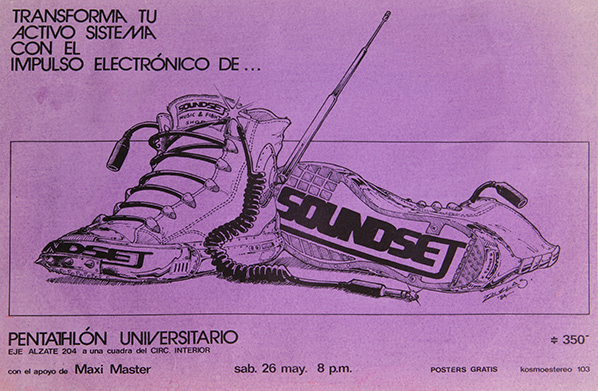
We are introduced to the world of artists and designers who created an imaginary to suit the precursors of the genre: pharaonic, galactic, utopian, spectacular, and futuristic. Always epic. Tailored to the moment, to the experience of the fans. The posters of the electronic sonidero movement are unique in format, employing unexpected techniques and materials; they are distinct, painstaking, sensational, new. In contrast, the works of tropical sonidos follow in the typographic vein of Mexico’s Gráfica Popular – reminiscent of the wrestling, taking the freedoms of the tropics, whether with box cutter or in full pixel. In the world of disco, Hi-NRG, and techno, the graphics are like the sound system: cult objects, concepts, myth.
“Do you want to meet Jaime Ruelas?” asks José Luis. The master of ink drawing, creator of logos and illustrations as iconic as La Changa or Polymarchs themselves. Of course we do. We are his fans, and we are an army. We arrive nearly punctually to the interview, with photography, audio and video gear in tow. Nearly punctually, because Jaime is already waiting; the son of a watchmaker, he knows machines, design and sound from the inside. He also knows the history of Polymarchs well, and from the beginning. Polymarchs’s first gig took place in his apartment in Tlatelolco. Later, Jaime became the sonido’s first DJ, before switching his focus to images.
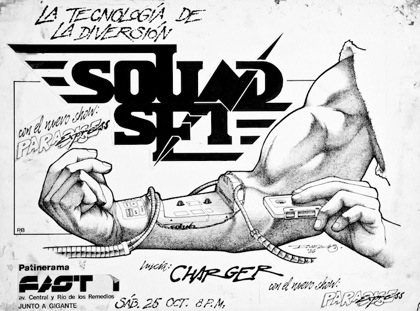
Like the sonidos thriving now in the capital, Polymarchs began in Puerto Ángel, on the Oaxaca coast, with a modest set-up – just a single Telefunken console and two baffles. The collective was formed by three siblings in 1975: Apolinar, Elisa and María de los Ángeles Silva Barrera. In 1978 they moved to Mexico City. Apolinar took charge of the sonido, and with Jaime Ruelas he discovered disco and Hi-NRG. The tenacity of Polymarches transcends mere selection of musical genres; the approach here is different. With tropical sonidos, the music, the equipment, the role of DJ and MC are the purview of one person, a single all-powerful figure operating from behind the console. Polymarchs is coming from somewhere else, assembling great towers of scaffolding, creating a spectacle, an experience, an environment. Neither DJ or MC, this is an entire machine. Polymarchs designs, produces and operates structures of light and sound as have never been seen before, radiant vessels that travel, carrying immense tech crews and companies of retro-futuristic dancers, from Tenochtitlan to outer space. There are explosions in the cosmos. On the floor all hands are up, cellphones by the thousands.
When Apolinar Silva and the Polymarchs team arrive at the Centro Cultural de España to give a conference in the context of the Proyecto de Gráfica Sonidera, the auditorium is brimming. Followers sport the distinctive t-shirts and jackets, hold up posters they’ve collected, wave cellphones. Apolinar is glowing; he is the supreme authority and, more than mythic, he is mystic. The audience takes the microphone to share their experiences. Like the time a Polymarchs event was organized in Mexico City’s Zócalo and what people thought was an earthquake turned out to be the earth shuddering under such dance. Below, in one of the exhibition spaces, Polymarchs set up a kind of black-light temple, aglow with, among many others, the visions we now share now with you.
The Proyecto de Gráfica Sonidera was an intensive program that resulted in records and research, specialized workshops and others for children, the painting of walls, the exhibition of graphic, photographic, and video material, and a series of talks along with book and documentary releases. We had the honor of including a drawing by Jaime Ruelas, and we kicked off with a dance party dedicated to Polymarchs… which was epic. There was a little boy who stole the dance floor, winning it against the odds from the more seasoned dancers.
All this was made possible thanks to many people and institutions. Shout-outs to the following generous collaborators: Marco Ramírez, José Luis Lugo, Javier Echavarría, Jaime Ruelas, Livia Radwanski, Mark Powell, Mirjam Wirz, Rocío Montoya, Tonatiuh Cabello, Diego Delgado, Alan Lazalde, Sonido Fajardo, Luis Sánchez, Héctor Rubí, Julio Díaz Corona, Sonido Leo, Christian Cañibe, Eduardo “Aníbal” Dueñas, Eleazar “Canuto” Escobar and the shop personnel of Publicidades Panther, Publicidades Lupano, Aisel Wicab, Citlali López Maldonado, Pedro Sánchez, Marisol Mendoza, Lupita La Cigarrita, Sonido Pío, Víctor Hernández, Edgar Ramírez, Laura Zárate, Griska Ramos, Mirna Roldán. Official respects to FONCA, to CONACULTA, to the Fundación Alumnos 47 and to the Centro Cultural de España.
Furtherfield presents DIGITAL ZOO: Life from the world wild web, a touring exhibition that invites audiences to explore and marvel at new patterns of human and digital behaviours in the network age.
Featuring Andy Deck, Mary Flanagan, Genetic Moo, Liz Sterry, Thomson & Craighead, Pete Gomes, and a new interactive mobile artwork commission by Transnational Temps.
DIGITAL ZOO features experimental software, interactive videos, installations, workshops, networked and mobile media created by internationally recognised artists inspired to explore the ways in which our lives are being shaped by digital technologies, and challenge the concept that digital art is only accessible in galleries or online.
Since 2008 artist group Genetic Moo have been developing a series of interactive video installations using choreographed video clips that respond in a variety of life-like ways to user motion and touch. With Animacules they take inspiration from the 19th century sea life illustrations of Ernst Haeckel and the work of the 17th century Dutch scientist Antonie van Leeuwenhoek to create a dark sea of wiggling, luminescent creatures that gorge on torch light.
Internationally renowned artist duo Thomson & Craighead create a new site-specific installation especially for the DIGITAL ZOO tour. A wall of propaganda style posters of the Tweets and other status updates drawn from people in the local area of the tour venues, offers a poetic snapshot of the invisible conversations taking place, “the idle mutterings of ourselves to ourselves as a form of concrete poetry.” The work is based on the artists’ London Wall series shown at the Museum of London (2010), Furtherfield Gallery (2012) and Carroll/Fletcher (2013).
Liz Sterry is an artist fascinated with the way people use the Internet to express themselves. In Kay’s Blog she presents an exact physical replica of a young woman’s bedroom, recreated through information, images and notes about her daily life that the real Kay posted on her public blog. With social media often used as a platform for self-expression and performance, the work questions how much of ourselves we share online with strangers without even realising it.
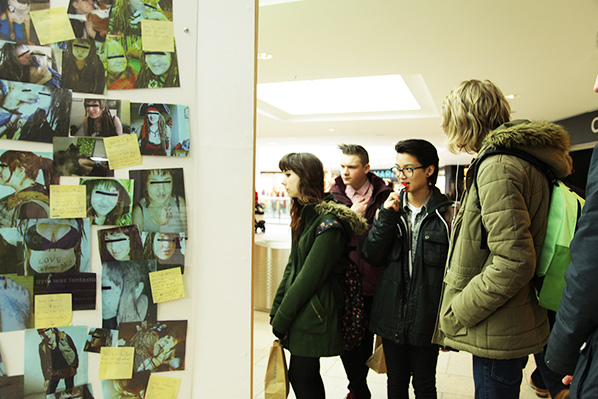
With his novel use of Twitter, US artist Andy Deck savours the wildness of everyday language with people around the world, inspired by the wealth of nature-related sayings passed down over centuries. He invites audiences to help him build a bestiary of animal idioms using social media and an interactive installation.
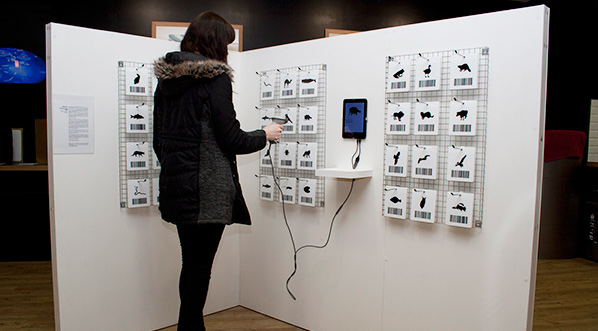
Experimental filmmaker Pete Gomes invited residents in Sunderland with no acting experience to participate in a 45 minute long acting session. Each participant was directed to perform on camera for a single five-minute take. Screened as a series, Cycle of Purposes questions reality and artifice by exploring how thoughts and feelings are acted, amplified, exaggerated and stylised every day in response to different people and places.
Mary Flanagan travels overland and undersea, in virtual worlds built and inhabited by other virtual beings. [borders] is a video documentation of her walks in beautiful and hypnotic landscapes that expose the boundaries of the virtual world by testing its edges. Her walks are inspired by Thoreau, the great American nature writer and walker, who, avoiding highways, chose instead to wander in order to understand the spiritual possibilities of the landscape.
Mall of the Wild by Transnational Temps is a new commission created especially for Digital Zoo. Players help the famous artist Magritte to find fake wildlife in the shopping centre. Equipped with a store map and a smart phone app, they have limited time to find a number of representations of wild animals visible in the products of the shopping centre. They map rare species and share their wildlife documentary photos in the online “Ceci n’est pas…” collection via social networks.
In creating DIGITAL ZOO, Furtherfield believe that digital networks and social media offer the potential for a more open relationship between artists and audiences, changing the life of an artwork in the world, and the ways in which people encounter it, and sometimes collaborate in its creation.
Personal information is exchanged with increasing frequency, and daily lives are becoming ever more public, as if in a public zoo. People are both animals and visitors; hunters, trackers, observers, naturalists and zookeepers; and educators and pundits. The longer-term social effects of this collective public performance are awaited…
The exhibition was accompanied by a series of creative workshops inspired by Crow_Sourcing for children aged 6-11 years old.
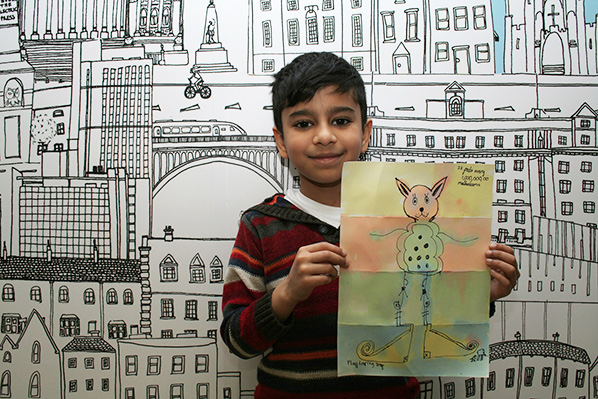
Curated and produced by Furtherfield in collaboration with Culture Code and Land Securities.
Digital Zoo is supported by Arts Council England through the Strategic Touring programme.
Crow_Sourcing by Andy Deck was made possible with funding from the Jerome Foundation, and was a 2012 Commission of New Radio and Performing Arts, Inc. for its Turbulence website.
Featured image: Screen capture of Joseph DeLappe’s intervention in America’s Army
The Fresno Art Museum, in collaboration with the Fresno State Center for Creativity and the Arts, is exhibiting “Social Tactics,” a mini-retrospective of the work of Joseph DeLappe, a new media artist and director of the Digital Media Program at the University of Nevada, Reno. The exhibit has been running alongside the construction of a to-scale sculptural reproduction of an MQ1 Predator Drone on the campus of Fresno State, coordinated by DeLappe and executed by students and volunteers. I had the opportunity to interview DeLappe about his work, and the way it connects to militarism, memorialization, and embodiment. His work has been an ongoing critique of games that look like war, and warfare that looks like gaming – insisting that, within the hall of mirrors that forms “simulation culture,” reality still must be accounted for, and attended to.
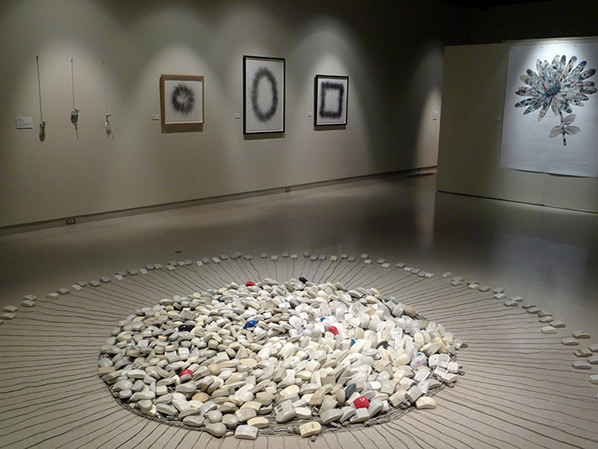
The earliest work in the show is a series of riffs on the computer mouse. The “Mouse Mandala” (2006) splits the difference between a trash heap and an object of meditation – a small sargasso of computer mice is ringed by a circle of yet more mice. The outer radius, tethered to the central mass by extended mouse cords, makes the whole sculpture resemble a dingy grey sun – one that has been pawed by innumerable, invisible fingers. His “Artist’s Mice,” first begun in 1998, are a series of mice that have drawing implements attached to them, so that the mice can draw while being utilized for their normal activities. The drawing attachments resemble braces, as though the mice are being rehabilitated from an injury – the drawings produced by them are beautiful abstractions, circular or square scribblings that give the illusion that, while working or gaming or goofing off, we could also be making art – skimmed off the surface of our interface with our machines.
All these mice, removed from the context of their guiding hands, inevitably – if ambiguously – echo with a pair of outsized sculptural hands, titled “Taliban Hands” (2011). Modeled from white plastic polygons, the left hand in particular looks as if it could be cradling an invisible, equally outsized mouse. The right hand has its pointer finger extended, as if it were about to press a button. The fact that the hands are upturned short-circuits those prosaic possibilities of gesture, turning them into gestures of supplication. The hands were constructed from 3D data extracted from the model of a Taliban fighter in the game “Medal of Honor,” and once you learn that, it’s easy to imagine the right hand gripping a gun, the extended finger wrapped around the trigger. The disembodied nature of the hands is discomfortable – it feels like a dismemberment, a pair of hacked war trophies offered up for display.
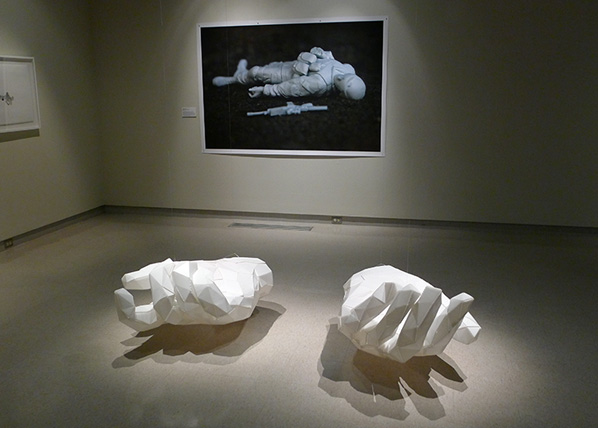
DeLappe also used polygon modeling for a small replica of a US military Drone that hangs in the gallery, which served as a prototype for the life-size drone constructed as a memorial on the grounds of Fresno State. Where the “Taliban Hands” and drone prototype are white and pristine, the Drone Memorial was designed to be inscribed upon. In a public ceremony, volunteers wrote the names of 334 civilian casualties of drones on the faceted surface of the sculpture.

DeLappe’s years-long project “dead-in-iraq” (2006-2011) is represented by a machinima video and a large-scale digital print modeled after his fallen avatar in the US Army recruitment game America’s Army. Over the course of the American war with Iraq, DeLappe entered the multiplayer first person shooter game, and at the start of each mission threw down his weapon and began typing in the names of US military personnel who had been killed in Iraq. His avatar was invariably shot, either by the opposing team or by members of his own team. In the latter case, it’s as though his killers are trying to gun down an itch of conscience – or the nuisance of reality itself. In the machinima of this intervention, when Delappe positions his camera above his virtual corpse, there is sometimes a very profound effect of quietude. The body occasionally twitches, in a gruesome effluvium of game physics, or puffs of smoke are kicked up by stray bullets – but those filigrees of activity only heighten the feeling that the game has moved on. It brings to mind bodies left on real battlefields, unattended to, abandoned to the weather and the birds and the insects while the important business of fighting continues.

“Project 929: Mapping the Solar” (2013) echoes the circularity of the Mouse Mandala. For the project, DeLappe rode a bicycle 460 miles in a circuit around Nellis Air Force Base in Southern Nevada. The bicycle was outfitted with an apparatus that held a series of pieces of chalk to the road – DeLappe was both marking a chalk outline around the base, and mapping out the dimensions of a solar farm that could power the entire United States, based on a size estimate from the Union of Concerned Scientists. The project is shown through a series of photographs, a video, and the modified bike itself, with a circle of chalk stubs positioned under the frame. In some ways, the piece expands the logic of the “Artist’s Mice” to a different scale. Instead of the hand being the driving force, the whole body is the recorded object, and rather than being confined to the top of a desk, the drawing itself is allowed to range across hundreds of miles. In this case, the drawing is the opposite of accidental – it’s utopian.

Not represented in the show – but a point of discussion in our interview – was the “Salt Satyagraha Online” (2008), a 26-day durational performance which used a customized treadmill to control the movement of a Second Life avatar modeled after Mahatma Gandhi. On the treadmill, installed at Eyebeam Art and Technology in New York, DeLappe walked the 240 miles Gandhi marched in protest of a British Salt tax – driving his avatar, step by step, across the territory of Second Life. That project was yet another of DeLappe’s exploratory reconfigurations of the relationship between protest, performance, and physicality.
Chris Lanier: With the mouse-derived work, from the “Mouse Mandala” to “The Artist’s Mouse” and the drawings that are made as you’re playing a game – what was it like putting those things together at this time, when it’s possible to imagine the disappearance of the mouse? Right now there is eye-controlled software , and even thought-controlled software…
Joseph DeLappe: Part of my thought process when doing the mouse pieces was doing a sort of reverse engineering, and trying to figure out what that thing is, because it really is a useless little object otherwise. It’s not a hammer, it’s not a screwdriver, it doesn’t have a function beyond plugging into a computer to allow you to move around this detached marker on a screen. There’s already something separate happening, and so attaching a pencil to it was a way of perhaps returning it to its roots. It’s sort of a drawing device, a pointer, all these things that a pencil might be, but I was intrigued by the possibilities of extracting some kind of meaning out of it.
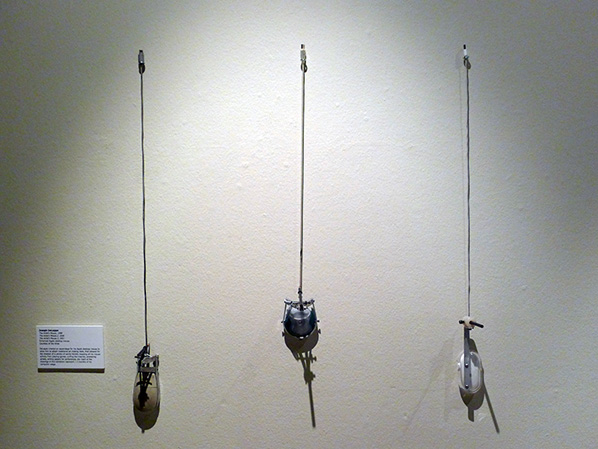
CL: It’s funny because it’s an extension from the computer to the human, like an organ that extends itself to us, and I wonder what you think of that interface becoming even more disembodied. If the hand is taken out of that circuit, what do you think that says about our relationship to the screen?
JD: I think it will change it. I can really only speak from my experience, not having played the wii, or things like that. I messed around with the kinect a little bit. When you’re putting the body into works like what I did in the Gandhi project (which is something that’s not in the exhibition) – I placed myself on a treadmill to actually interact with Gandhi, walking him through Second Life. My body became the game controller in a kind of way, the mouse – or however you want to refer to it. I didn’t realize it at first but there was an intrinsic alteration of my relationship to the experience going on, on the screen. I wonder if that deterioration of that awkward physical thing you have to do with the mouse or track ball, if that’s going to bring us closer to our machines. As it becomes gestural and everyday, I suspect it will become more naturalistic.
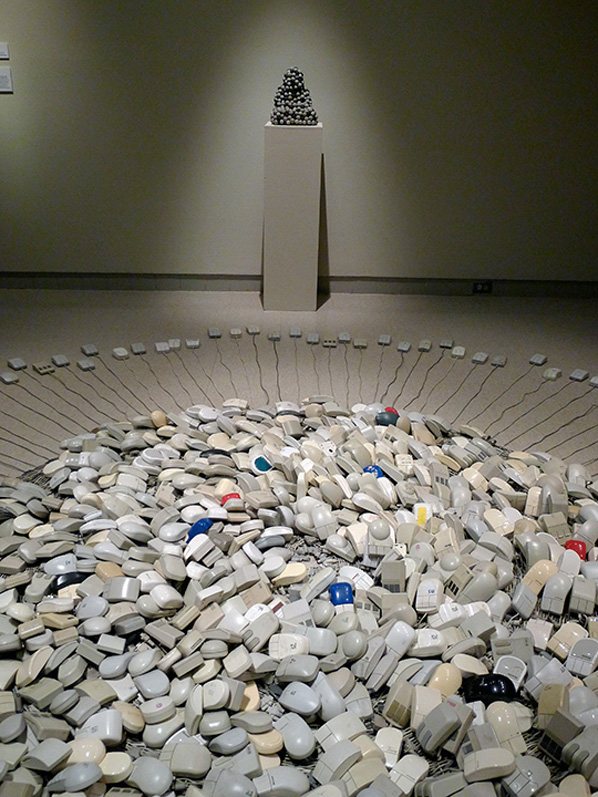
CL: Listening to you talk about the Gandhi project, it seemed to bring you more directly and somatically into that virtual world.
JD: Which was very unexpected. I went into that project from a conceptual durational performance ideation – this would be an examination of “performance,” in quotes. Performance and protest. It was done at Eyebeam in New York, and I was thinking about the many durational performances that had taken place in New York, from Tehching Hsieh, to Linda Montano, to Joseph Beuys. I had done performance works online for almost a decade prior to that piece, but that action that the body involves, that was just transformative. It was amazing and intriguing and kind of disconcerting in a way, because I found myself completely drawn into that experience, and connected to my avatar in a way that I never had previously. I was walking in Second Life, which you’re really not supposed to do – you’re supposed to teleport – so I was navigating over mountains and in places people don’t generally walk. And Gandhi would fall off a mountain-side into the next region, and I’d find myself almost falling off the treadmill. Or, after finishing the performance for the day, walking to the subway and thinking I could click on someone to get information. It became this mixed reality in my head.

CL: Embodiment seems to be a crucial part of your practice. With “Taliban Hands,” you extracted hands from Medal of Honor, and brought them into physical space. In the “dead-in-iraq” project you brought the names of the dead soldiers into the game space of America’s Army. It seems that bringing bodies into that space, or extracting bodies out of that virtual world, is important to you.
JD: Well, each of those pieces had different but connected intents. With the America’s Army project, “dead-in-iraq,” the intent was to embody the reality of the war, to bring it to this virtual space. So when you’re dying and or you’re killing in that virtual space, and you see these names go across the screen, you realize that this is an actual person that died in that conflict. That might change another player’s thought process about what they’re doing, and about that visualization – when you get shot you end up hovering over your fallen avatar. So there is this attempt to change how one considers that experience.

CL: It’s interesting, with the self-portrait as dead soldier – the way of marking yourself as dead is to show the body within the game. Moving you from a first-person space, a first-person-shooter space, into a third-person space. The body becomes a marker of death.
JD: That is certainly a problematic aspect of that game. I think the vast majority of the people playing the game – certainly there are some veterans and active military – but there are more people who aren’t in that situation. So there is this kind of temporary inhabiting of the US military. Bringing this out into real space is an attempt to drive home the connection of that fantasy pretend space to a very real space. It’s like bringing it to a sort of mid-ground. The America’s Army game is in fact official US military virtual space. I mean they own it. It is federal space – it’s part of the system of hundreds of bases around the world.

With the Taliban hands, it’s a similar attempt, but with a different thought process. With the America’s Army game, one of the most devilish things they did with that game is that they’ve created a system where everybody gets to be a good guy. There are two teams, and you see your team of 2 to 12 cohorts playing against 2 to 12 other cohorts. You always see yourself as Americans. They always see themselves as Americans, but you see each other as terrorist enemies. So there’s this digital switching, where they see your avatar as a Middle Eastern terrorist and vice versa.
CL: The strange thing that happens is that you’re inhabiting two bodies.
JD: Yeah, at the same time, exactly. But in the Medal of Honor game it’s not like that. That was a controversial game when it came out in 2010 because you could play as a Taliban killing American soldiers. It was the only game that was actually banned from military bases. They ended up changing it before they released it – they weren’t called “Taliban,” they were called OP 4, which stands for opposition forces. But you’re still Taliban. So anytime that game is being played as an online match, 50% of the players are being American and 50% are being Taliban.
I found that really curious. I started extracting these maps from that particular game, and then diving into this incredible morass of 3-D data. I would have to dig through all of this wireframe stuff to find these objects, and I found the Taliban and started deleting everything else, and landed at one point with the hands. It was just so intriguing – these hands were gorgeous. When they became disembodied from their source and I started visualizing them in the 3-D software, they took on a kind of Da Vinci-esque quality – like the hand of God or something.
CL: There is a gestural quality to it.
JD: Yeah, exactly.
CL: I’m curious if this work has brought you more into contact with the idea of simulation. Simulation can be useful, obviously – it allows you to think through a situation before it’s actually encountered. But then it can actually introduce errors into the actual [situation], because the simulation doesn’t correspond absolutely to reality.
JD: I don’t know if this connects to your question at all, but if you die in America’s Army – this is standard in most shooter games – they have something called the ragdoll effect. It’s a simulation of your body going limp. It’s meant to give a naturalistic [simulation of] you collapsing, and you’re dead. But the effect is actually quite different – there are points where your avatar, in that space – it can be almost comical, like you’re going to do a somersault. And every time you actually die, your body – because of that ragdoll effect – you watch the video and the avatars do this kind of shaking thing, that’s part of this ragdoll effect. When I first saw it I thought it was this macabre death spasm, but it’s just part of the simulation. It’s not meaningful in the context of the game, but it becomes meaningful in the work that I did and in the recording of it.
CL: It’s funny that a simulation can have these unintentional, almost poetic, effects – if you are attuned to it.
JD: And that’s a good metaphor for the whole project, right? It’s taking this simulated wargame – this recruiting tool – and re-branding it, remaking it. It’s a way to say: “No, let’s see if we can make this game be about this, not about that.” I appropriated the space – I took it over in a simple way, and I think it was quite effective.
CL: You frame yourself as an activist as well as an artist.
JD: Yeah, and sometimes uncomfortably. I drift in and out of that. There’s a difference between being an artist and activist. And right now I’m feeling rather reticent [about the “activist” label] – but I’m an artist at base. It’s a little bit more symbolic I guess…
CL: Making a political act in a virtual space – is that inherently symbolic?
JD: That’s a really interesting question because in the progression of my work, I think my work has slowly emerged towards existing in a real space – with the bike-riding around the Air Force base, and now building a life-sized predator drone down in Fresno.

As an artist you do deal with a kind of symbolic reality – metaphor and symbolism, and things that communicate ideas through form. As an activist it seems there would always be a goal of actually fostering change, making change happen in the world. Whether activism is effective at doing that – that’s a really big question too, right? I’m not sure sure if that’s the case these days. That’s one of the reasons I was interested in going into the America’s Army project. It was seeing the – I wouldn’t say the complete failure – but the invisibility of traditional forms of protest. You had the world’s largest worldwide gatherings of protest, a year before we started that war, which was totally under-reported…
CL: And under-counted.
JD: Right. And I’m not saying that I never want you to go protest in these places, but you do have to push that envelope into places where people would not expect it, to actually reach people. And that was a surprise actually, that that piece resonated so powerfully with others – and became a viral thing that, by accident, was disseminated to a huge audience. That was good. But I’m not sure how I feel about it as a kind of permanent venue for trying to do that kind of thing.
With the “dead-in-iraq” project, there were some people who were criticizing it, saying, “Well, you’re just sitting there at your keyboard.” It’s like: “Yeah? Right. I know that – that’s part of the point. Everybody playing that game is sitting at their keyboard.”
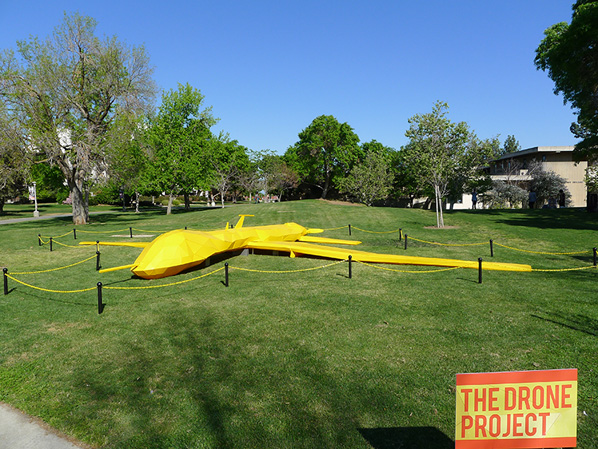
CL: And the people who are manning drones are sitting at their keyboards.
JD: Precisely, and that’s exactly one of the reasons I’m so interested in drones. Speaking of embodiment, the drones –it’s like a perfect synthesis of computer gaming culture, and our militarism, and our love for the latest possibilities of technology. It’s like somebody bashed those things together and out came this perfect system for blowing shit up on the other side of the planet – sitting in your comfortable gamer’s chair.
CL: The way you’re activating the Drone Memorial as an extension of your art activism – I’m wondering if part of the appeal is doing it within an educational institution, where you’re enlisting students to help you out, so it actually becomes part of an educative process. How much do they know about the drone policy?

JD: What’s interesting with that project is that they brought up these different groups – art students, design students, and there has been a group of activists from Fresno called Peace Fresno who’ve come out to work. There have been some TV interviews, and there’s a journalism class – they’re taking turns, every day there’s a different crew and they’re documenting the process and interviewing the people that are involved. And it’s been interesting talking to some students because there have been a number of students that are like: “What, drones? We can blow stuff up in Pakistan, from sitting in Las Vegas at Creech Air Force Base?” They don’t know about it, so there is a kind of basic informational aspect of the project.
But what I’m finding most interesting is that the students and volunteers – and myself – at this stage of the work we’re so absorbed in the embodiment, if you will, of the physical sculpture. It’s a building process and there’s a kind of pleasure in that. There’s the hands-on aspect of building, and seeing this form come into being. What I’m waiting for is that realization when we get the whole thing together, and it has this 48 foot wing span and 27 foot fuselage, sitting on the ground at the campus – and then we write the names [of the civilian casualties on the sculpture] – we have 334 names in English and Urdu.

I think that’s going to have a powerful impact, that’s going to completely flip the equation. Not just to give them a sense of their making something as a community build – but that we own these drones – we are this policy. These victims that are on the drone are connected to us, right? There’s a direct lineage from that pilot sitting in Creech Air Force Base, from the missile that rained down on that village and killed a 12-year-old girl, to you and me. It may be tentative, but it’s our government – it’s us.
Conclusion.
The interview was conducted several days before the completion of the Drone Memorial. After the sculpture was assembled and installed, there was a public ceremony at the site. Afterward, I asked Joseph if the effect of the ceremony was in fact what he envisioned, and he sent me the following reply via email:
We finished the drone just as the ceremony was scheduled to commence. There was a crowd of about 75 people – I made some brief comments thanking the volunteers and the CCA. The actual ceremony was being coordinated by a wonderful group, “Peace Fresno”, who coordinated the creation of individual, hand written index cards, each with the name, date of death and age (if available), of each of the 334 Pakistani drone victims. These were read aloud by individuals from Peace Fresno of Pakistani or Indian descent to ensure that the names were correctly pronounced. Those gathered for the event stood in line to take possession of a name after it was read aloud – walking towards the drone where they were given a pen. Each name was written with the associate dated of death and age of the victim when available. Several volunteers followed this process by filling in the names translated into Urdu.

I personally completed the process of standing in line, taking a pen and writing names on the drone 7-10 times, I lost count. The most memorable was that of an 8 year old girl – I don’t recall her name but after writing on the drone the realization of the death of a child was quite overwhelming. Others had similar experiences – there were several walking away from the drone after writing their name who were in tears. This cycle of writing, standing in line and continuing the process went on for perhaps 45 minutes until all 334 names were written upon the drone. All the while there were passersby stopping, asking what we were doing, some joined us. I recall a father on a bicycle have a discussion with his young son about drones, “are you ok with being surveilled 24/7?”, that kind of thing.
In my exhaustion after working 2 weeks followed by an additional weekend of 11 hour work days, the experience was moving and quite overwhelming. There was indeed a palpable realization of the nature of the project. The camaraderie established among the workers and volunteers evolved into a collaborative process of memorialization.
“Social Tactics” runs through April 27, and the Drone Memorial will be on display through May 31.
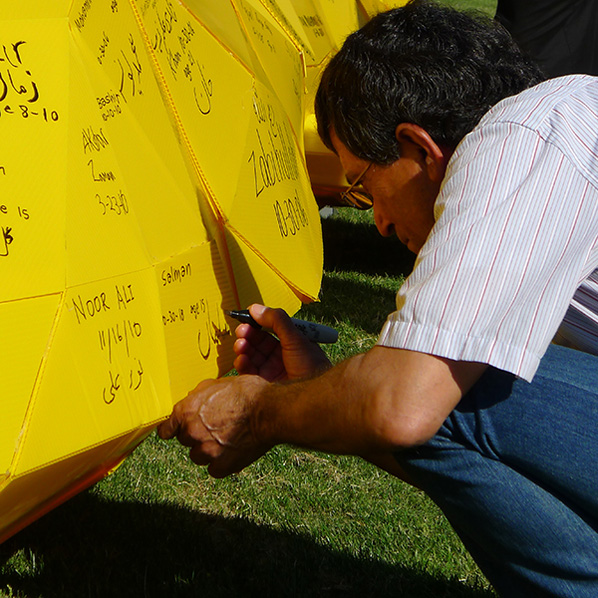
Joseph DeLappe’s website: http://www.delappe.net
A previous furtherfield interview on another drone-related project by DeLappe:
The 1,000 Drones Project, by Marc Garrett – 05/02/2014, furtherfield.org
http://furtherfield.org/features/interviews/1000-drones-project-interview-joseph-delappe
News story on US Military objections to ‘Medal of Honor’:
Sales of new ‘Medal of Honor’ video game banned on military bases, by Anne Flaherty – 09/09/2010, Washington Post
http://www.washingtonpost.com/wp-dyn/content/article/2010/09/08/AR2010090807219.html
News story and video on the Drone Memorial:
Drone project at Fresno State a call for ‘contemplation’ (video), by Carmen George – 03/26/2014, The Fresno Bee
http://www.fresnobee.com/2014/03/26/3845089/drone-project-at-fresno-state.html
Fresno College Newspaper story on the Drone Memorial:
Drone sculpture construction begins, by Collegian Staff – 03/18/2014, The Collegian at Fresno State
Drone sculpture construction begins
Essay on the visualization of the “Enemy” in military games, with a focus on “America’s Army”:
The Unreal Enemy of America’s Army, by Robertson Allen – 01/2011, Games and Culture 6(1):38–60
http://www.academia.edu/231295/The_Unreal_Enemy_of_Americas_Army
Featured image: Pablo Garcia’s presentation at Resonate 2014
Resonate, the Belgrade, Serbia digital arts and design festival, now in its third year unfolds over a long week at the start of April. Its central tenet is to bring together “artists, designers and educators to participate in a forward-looking debate on the position of technology in art and culture.” It is also an emerging and challenging festival that raises many more questions than it answers. The festival starts off with a number of workshops held by practitioners for practitioners. Foregrounding the demystification of the creative process immediately sets it apart from any number of other media arts festivals. Whereas many festivals might be broader in their approach to what the digital can include, and focus on themes that don’t always feel like they directly influence what happens in the festival, Resonate doesn’t give itself a curatorial focus. But, and so, the workshops set the festival off with a focus on making. Most people who come to Resonate are just that: makers of work. It feels as though there are fewer curators, producers and academics here than you would expect.
Resonate, the Belgrade, Serbia digital arts and design festival, now in its third year unfolds over a long week at the start of April. Its central tenet is to bring together “artists, designers and educators to participate in a forward-looking debate on the position of technology in art and culture.” It is also an emerging and challenging festival that raises many more questions than it answers. The festival starts off with a number of workshops held by practitioners for practitioners. Foregrounding the demystification of the creative process immediately sets it apart from any number of other media arts festivals. Whereas many festivals might be broader in their approach to what the digital can include, and focus on themes that don’t always feel like they directly influence what happens in the festival, Resonate doesn’t give itself a curatorial focus. But, and so, the workshops set the festival off with a focus on making. Most people who come to Resonate are just that: makers of work. It feels as though there are fewer curators, producers and academics here than you would expect.
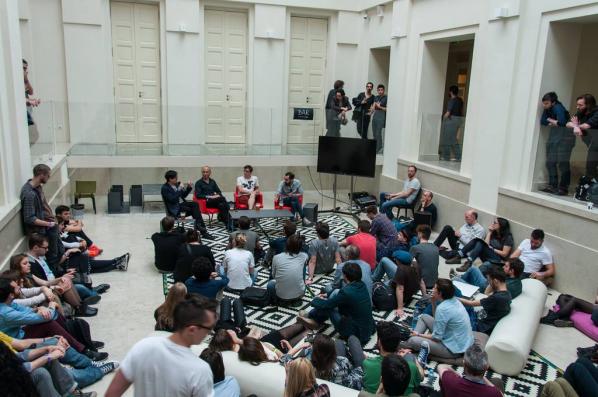
This year, shifting location from 2013’s Dom Omladine, perhaps learning from some of the problems of last year’s over-heated and occasionally too-tightly packed events, they have moved to a spread of venues, with the base being the Kinoteka Cinema, a sleek-looking modern building with a number of different spaces. Any decent festival has a spread of overlapping events making it impossible for one person to attend everything. Resonate makes no apologies for being just as packed with events as any other festival. The one time it might be possible to sit and spend a day in one place is if you’ve managed to get on to a workshop event that takes place on the Thursday. Once the workshops are over though, Friday kicks off with the panels and presentations. Choreographic Coding discussion, led by NODE Forum’s Jeanne Charlotte Vogt opened the panel discussions. A broad ranging talk with Raphael Hillebrand, Florian Jenett, Peter Kirn (CDM), Christian Loclair and Klaus Obermaier, (returning again after last year’s Resonate, possibly being an ongoing presence at the festival). All of the panel talks took place in the central lobby of the Kinoteka, which proved to be a terrible choice for anyone who wanted to actually hear the speakers. At times the discussions descended into a barrage of mumbles blending with the sound of people emerging from surrounding presentations and the poor choice of PA equipment placements. A shame, as the themes for these were well chosen, including Ways of Seeing, chaired by Greg J. Smith of HOLO magazine, and Generative Strategies, across the Friday and Saturday. The best laid plans of mice and journalists. I had planned to interview a number of presenters during the event, key amongst them was Pablo Garcia, who was on a panel and presented his own work on the Saturday. Apart from a brief conversation, we finally caught up over email several days later. I fired a number of questions at him, which are dotted across the rest of this review.
Do you find that Resonate offers something different than some other digital festivals? If so, what might that be? “It feels a lot like some of the better festivals I have seen, like EYEO. It is selecting from the best digital artists/makers out there, and giving them free reign on the stage to talk and share. The city has a great vibe and the overall feel is truly a “festival”, and not so much a conference or academic gathering.” ~ Pablo Garcia.
Friday’s talks included Cedric Kiefer (Onformative) giving a presentation in Gallery of Frescos, a short hop and stumble from Kinoteka Cinema. I’ve always enjoyed the juxtaposition that occurs when digital media is presented in contrast to, in this case, a venue “exhibiting in one place the highest achievements of Serbian Mediaeval and Byzantine art.” In other words, old stuff that enforces the modernity of the digital work we are being shown. Kiefer’s presentation covered some of their major projects including their work for Deutsche Telekom which used the company’s Facebook interactions to create beautiful data visualisations (Facebook Tree – 2013). There’s an unabashed acceptance of the interaction between corporate funding and creativity on display with many of the presentations. It’s something which never provokes debate, at least not in any of the conversations I had with participants or the panels I attended. Maybe that’s no longer ‘a thing’ that concerns creatives and the money required for some of the bigger projects has to allow for corporate sponsorship? I’m not suggesting we shouldn’t embrace funding from wherever it comes, it would just have been nice to have some debate around it.
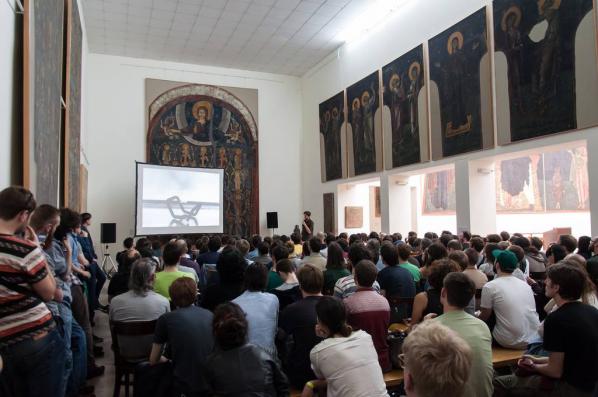
The schedule for the whole festival is broad and busy. There’s no chance of making it to every presentation or discussion, which is a great reason to go with others or to make an effort to talk to other attendees about what you’ve seen. The festival is a research port of call for many established, practicing digital artists. The UK’s Ludic Rooms have been to the past two festivals and consider it an opportunity to engage and re-establish contact with their peers in the community. “It is a coming together on an international scale with a thoughtful focus on practice,” reckons Ashley Brown, one half Ludic Rooms. Co-Director Dom Breadmore adds, “for us, Resonate has quickly superseded other events to become an annual pilgrimage for discussion and inspiration.”

One of the final presentations of the festival is by Daito Manabe in the Kolarac, another add-on venue of the festival, again an improvement on last year’s Dom Omladine. Daito’s work reflects something of the current state of digital media work. His presentation includes his (literally) home-made research videos, as well as the documentation of bigger projects. Whether he’s attaching electrodes to his own face to see what the effect is (hilarious facial distortions in this case), or working with dancers to create a drone/dancers piece, there’s humour and an enquiring mind at the center of his work. Daito showed his Ayrton Senna project, using the data transmitted from Senna’s car during his world-record lap in 1989, an ambitious and challenging project, least of all being the decision to erect it on the original racetrack. The data is used to trigger LEDs and numerous speakers laid out on the course. The LEDs follow the path taken by the car, while the sound is the engine accelerating and decelerating as the car would have taken the corners. It’s a ghostly piece, at once recreating that frustration that race fans must have of just having missed the car and a reminder that this is an event that happened many years ago. An echo of the past. Data mining, big data, is like this, in most contemporary projects. Data visualisation is a zombie, rising up to challenge the present. And like all the best zombie films, it can be a metaphor for our own rampant consumerism and reliance on technology. Still, at least in the hands of someone like Daito, our guilt is assuaged by humour.
What is your own take on the current landscape of digital media/art/design? “It’s an exciting time, for sure. Not only because there is so much digital access today for all to experiment with. We are starting to see makers move past the “wow” phase of tech and really start to integrate digital techniques into various historical techniques. Watching digital work cease to be about digitality will go a long way to opening new avenues of exploration.” ~ Pablo Garcia.
In those important few hours after a festival when you make your way back home, you finally get a chance to take stock. Thoughts crash over you in what better place for free-form thinking than the nowhere of airport waiting zones. In the neverzones I realised that what I’d thought was my frustration with Resonate, was actually the thing that gives it a unique flavour. Resonate doesn’t present a theme and then hope to find an answer through precarious curation of speakers who most likely will follow their own path anyway. What it does do, and does well, is ask questions that might not have answers. The focus on knowledge and learning gives attendees a broad enough palette to choose their own ambitions for the festival. There isn’t any guided pathway through the diverse range of speakers. There are many things that Resonate could do better. It would have been nice to see more actual work in the various spaces. Line of Sight, a collaborative project by Kimchi and Chips and Nanika, (produced by CAN_LABS and Resonate Festival) was installed and produced for Kinoteca goers during the festival, giving a taste familiar to many attendees, of the stress of having to deliver a working project to a tight deadline. Thankfully, they did so. More projects would have been nice though. Even the digital needs to explode out of the screen and smear itself across a few walls or public spaces, obstructing and challenging people around the venues. After all, contextuality is nine tenths of the art law. Equally, some of the audio/visual problems need addressing. Complaining about them seems like a mean sideswipe, but these are the things that leave people with the suspicion that a festival isn’t as bothered as it should be. Resonate does care about attendees, as is evidenced by the free workshops and focus on helping to develop practitioners. It reflects this in its very DNA as an ever-becoming environment for creatives. And besides, the good stuff always happens in the rough and frayed edges. Resonate needs space and time to stretch and breath and see what it can become, just as Serbia, despite a rich and ‘interesting’ history (Belgrade is one of Europe’s oldest cities) is still finding its feet in the modern world (it applied for membership of the European Union in 2009). The festival supports emerging digital media practitioners by accelerating interaction with other countries to support the country’s upper-middle income economy with its strong service sector economy.
What was your experience of Resonate? “Resonate is a jam-packed, head-spinning experience. So many amazing people showing all their goodies in tightly packed spaces. It’s a lot of fun. Caveat: don’t go expecting to see everything. So many events and talks are happening simultaneously, you can’t see it all. Personally, I found it incredibly valuable to be able to show my work to a really talented and smart group of people to get solid feedback on what I do. I learned a lot by presenting and by seeing sympathetic artists.” ~ Pablo Garcia.
As the festival evolves, it would be nice if it smoothed out some of the frayed edges. But maybe this isn’t possible without allowing the freedom the open spaces allow for the fun stuff to happen. As Daito Manabe’s presentation showed, the open, unordered spaces are where all the best artistic developments take place.
Jonas Lund’s artistic practice revolves around the mechanisms that constitute contemporary art production, its market and the established ‘art worlds’. Using a wide variety of media, combining software-based works with performance, installation, video, photography and sculptures, he produces works that have an underlying foundation in writing code. By approaching art world systems from a programmatic point of view, the work engages through a criticality largely informed by algorithms and ‘big data’.
It’s been just over a year since Lund began his projects that attempt to redefine the commercial art world, because according to him, ‘the art market is, compared to other markets, largely unregulated, the sales are at the whim of collectors and the price points follows an odd combination of demand, supply and peer inspired hype’. Starting with The Paintshop.biz (2012) that showed the effects of collaborative efforts and ranking algorithms, the projects moved closer and closer to reveal the mechanisms that constitute contemporary art production, its market and the creation of an established ‘art world’. Its current peak was the solo exhibition The Fear Of Missing Out, presented at MAMA in Rotterdam.
Annet Dekker: The Fear Of Missing Out (FOMO) proposes that it is possible to be one step ahead of the art world by using well-crafted algorithms and computational logic. Can you explain how this works?
Jonas Lund The underlying motivation for the work is treating art worlds as networked based systems. The exhibition The Fear Of Missing Out spawned from my previous work The Top 100 Highest Ranked Curators In The World, for which I assembled a comprehensive database on the bigger parts of the art world using sources such as Artfacts, Mutaul Art, Artsy and e-flux. The database consists of artists, curators, exhibitions, galleries, institutions, art works and auction results. At the moment it has over four million rows of information. With this amount of information – ‘big data’ – the database has the potential to reveal the hidden and unfamiliar behaviour of the art world by exploring the art world as any other network of connected nodes, as a systemic solution to problematics of abstraction.

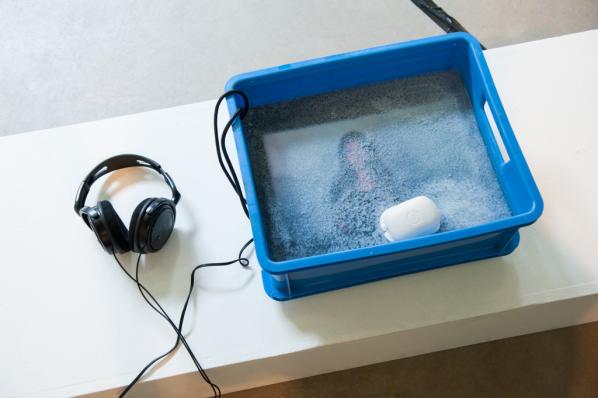
In The Top 100 Highest Ranked Curators In The World, first exhibited at Tent in Rotterdam, I wrote a curatorial ranking algorithm and used the database, to examine the underlying stratified network of artists and curators within art institutions and exhibition making: the algorithm determined who were among the most important and influential players in the art world. Presented as a photographic series of portraits, the work functions both as a summary of the increasingly important role of the curator in exhibition making, as an introduction to the larger art world database and as a guide for young up and coming artists for who to look out for at the openings.
Central to the art world network of different players lies arts production, this is where FOMO comes is. In FOMO, I used the same database as the basis for an algorithm that generated instructions for producing the most optimal artworks for the size of the Showroom MAMA exhibition space in Rotterdam while taking into account the allotted production budget. Prints, sculptures, installations and photographs were all produced at the whim of the given instructions. The algorithm used meta- data from over one hundred thousand art works and ranked them based on complexity. A subset of these art works were then used, based on the premise that a successful work of art has a high price, high aesthetic value but low production cost and complexity, to create instructions deciding title, material, dimensions, price, colour palette and position within the exhibition space.
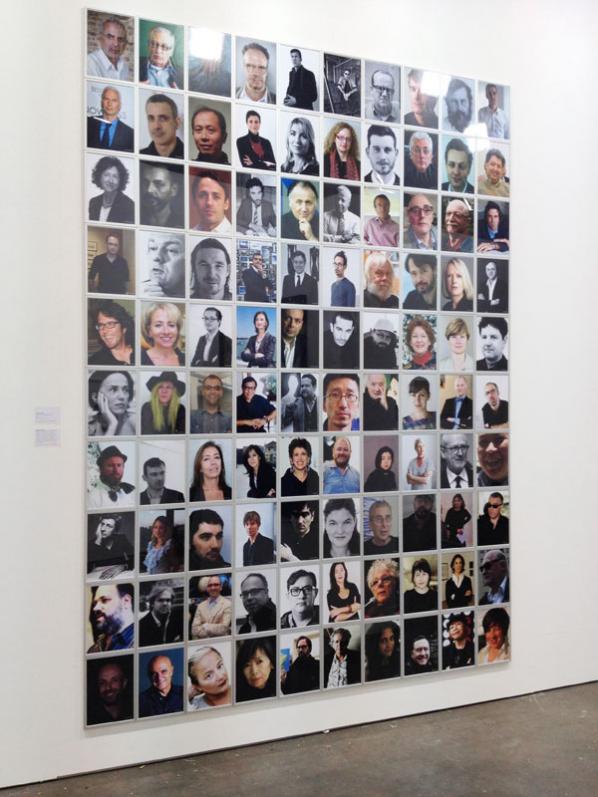
Similar to how we’re becoming puppets to the big data social media companies, so I became a slave of the instructions and executed them without hesitation. FOMO proposes that it is possible to be one step ahead of the art world by using well-crafted algorithms and computational logic and questions notions of authenticity and authorship.
AD: To briefly go into one of the works, in an interview you mention Shield Whitechapel Isn’t Scoop – a rope stretched vertically from ceiling to floor and printed with red and yellow ink – as a ‘really great piece’, can you elaborate a little bit? Why is this to you a great piece, which, according to your statement in the same interview, you would not have made if it weren’t the outcome of your analysis?
JL: Coming from a ‘net art’ background, most of the previous works I have made can be simplified and summarised in a couple of sentences in how they work and operate. Obviously this doesn’t exclude further conversation or discourse, but I feel that there is a specificity of working and making with code that is pretty far from let’s say, abstract paintings. Since the execution of each piece is based on the instructions generated by the algorithm the results can be very surprising.
The rope piece to me was striking because as soon as I saw it in finished form, I was attracted to it, but I couldn’t directly explain why. Rather than just being a cold-hearted production assistant performing the instructions, the rope piece offered a surprise aha moment, where once it was finished I could see an array of possibilities and interpretations for the piece. Was the aha moment because of its aesthetic value or rather for the symbolism of climbing the rope higher, as a sort of contemporary art response to ‘We Started From The Bottom Now We’re Here’. My surprise and affection for the piece functions as a counterweight to the notion of objective cold big data. Sometimes you just have to trust the instructionally inspired artistic instinct and roll with it, so I guess in that way maybe now it is not that different from let’s say, abstract painting.
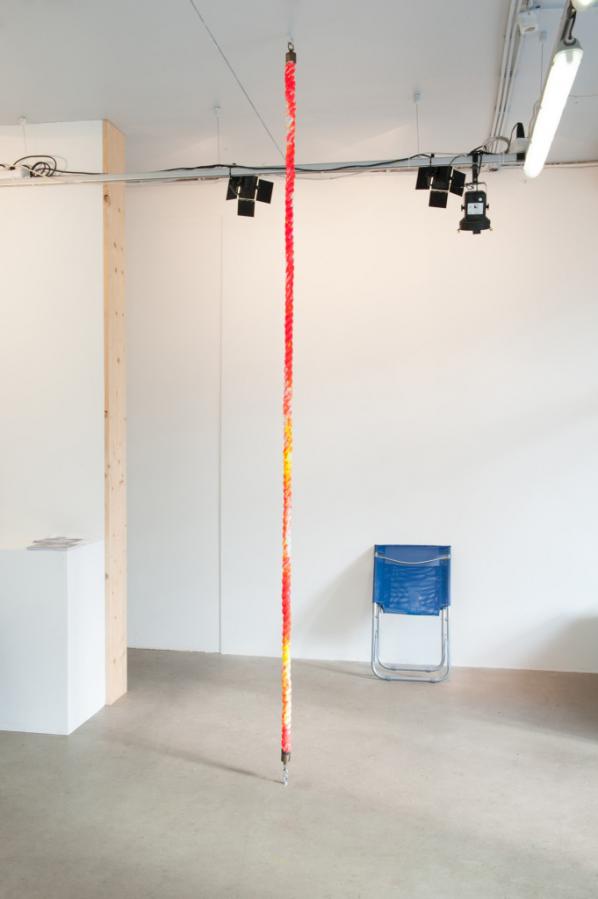
AD: I can imagine quite a few people would be interested in using this type of predictive computation. But since you’re basing yourself on existing data in what way does it predict the future, is it not more a confirmation of the present?
JL: One of the only ways we have in order to make predictions is by looking at the past. Through detecting certain patterns and movements it is possible to glean what will happen next. Very simplified, say that artist A was part of exhibition A at institution A working with curator A in 2012 and then in 2014 part of exhibition B at institution B working with curator A. Then say that artist B participates in exhibition B in 2013 working with curator A at institution A, based on this simplified pattern analysis, artist B would participate in exhibition C at institution B working with curator A. Simple right?
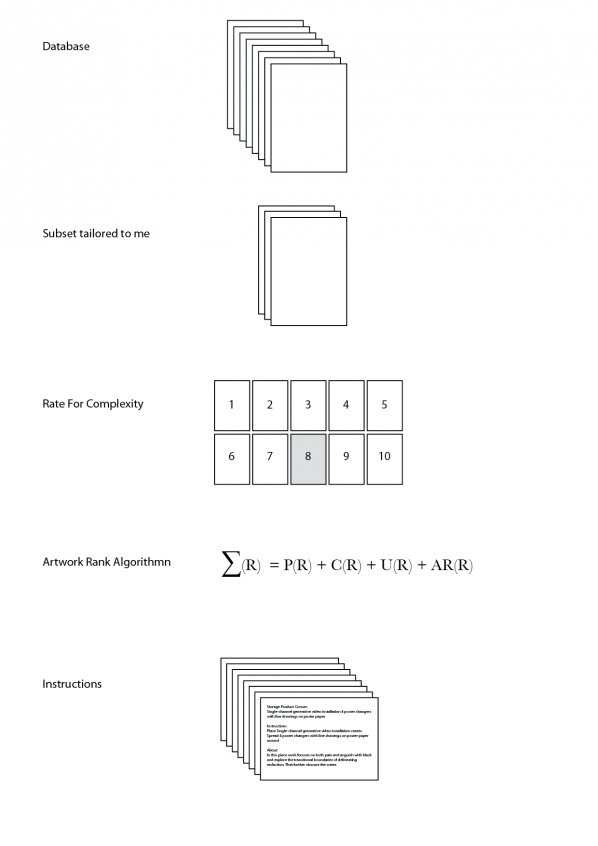
AD: In the press release it states that you worked closely with Showroom MAMA’s curator Gerben Willers. How did that relation give shape or influenced the outcome? And in what way has he, as a curator, influenced the project?
JL: We first started having a conversation about doing a show in the Summer of 2012, and for the following year we met up a couple of times and discussed what would be an interesting and fitting show for MAMA. In the beginning of 2013 I started working with art world databases, Gerben and I were making our own top lists and speculative exhibitions for the future. Indirectly, the conversations led to the FOMO exhibition. During the two production phases, Gerben and his team were immensely helpful in executing the instructions.
AD: Notion of authorship and originality have been contested over the years, and within digital and networked – especially open source – practices they underwent a real transformation in which it has been argued that authorship and originality still exist but are differently defined. How do see authorship and originality in relation to your work, i.e. where do they reside; is it the writing of the code, the translation of the results, the making and exhibiting of the works, or the documentation of them?
JL: I think it depends on what work we are discussing, but in relation to FOMO I see the whole piece, from start to finish as the residing place of the work. It is not the first time someone makes works based on instructions, for example Sol LeWitt, nor the first time someone uses optimisation ideas or ‘most cliché’ art works as a subject. However, this might be first time someone has done it in the way I did with FOMO, so the whole package becomes the piece. The database, the algorithm, the instructions, the execution, the production and the documentation and the presentation of the ideas. That is not to say I claim any type of ownership or copyright of these ideas or approaches, but maybe I should.
AD: Perhaps I can also rephrase my earlier question regarding the role of the curator: in what way do you think the ‘physical’ curator or artist influences the kind of artworks that come out? In other words, earlier instructions based artworks, like indeed Sol LeWitt’s artworks, were very calculated, there was little left to the imagination of the next ‘executor’. Looking into the future, what would be a remake of FOMO: would someone execute again the algorithms or try to remake the objects that you created (from the algorithm)?
JL: In the case with FOMO the instructions are not specific but rather points out materials, and how to roughly put it together by position and dimensions, so most of the work is left up to the executor of said instructions. It would not make any sense to re-use these instructions as they were specifically tailored towards me exhibiting at Showroom MAMA in September/October 2013, so in contrast to LeWitt’s instructions, what is left and can travel on, besides the executions, is the way the instructions were constructed by the algorithm.
AD: Your project could easily be discarded as confirming instead of critiquing the established art world – this is reinforced since you recently attached yourself to a commercial gallery. In what way is a political statement important to you, or not? And how is that (or not) manifested most prominently?
JL: I don’t think the critique of the art world is necessarily coming from me. It seems like that is how what I’m doing is naturally interpreted. I’m showing correlations between materials and people, I’ve never made any statement about why those correlations exist or judging the fact that those correlations exist at all. I recently tweeted, ‘There are three types of lies: lies, damned lies and Big Data’, anachronistically paraphrasing Mark Twain’s distrust for the establishment and the reliance on numbers for making informed decisions (my addition to his quote). Big data, algorithms, quantification, optimisation… It is one way of looking at things and people; right now it seems to be the dominant way people want to look at the world. When you see that something deemed so mysterious as the art world or art in general has some type of structural logic or pattern behind it, any critical person would wonder about the causality of that structure, I guess that is why it is naturally interpreted as an institutional critique. So, by exploring the art world, the market and art production through the lens of algorithms and big data I aim to question the way we operate within these systems and what effects and affects this has on art, and perhaps even propose a better system.
AD: How did people react to the project? What (if any) reactions did you receive from the traditional artworld on the project?
JL: Most interesting reactions usually take place on the comment sections of a couple of websites that published the piece, in particular Huffington Post’s article ‘Controversial New Project Uses Algorithm To Predict Art’. Some of my favourite responses are:
‘i guess my tax dollars are going to pay this persons living wages?’
‘Pure B.S. ……..when everything is art then there is no art’
‘As an artist – I have no words for this.’
‘Sounds like a great way to sacrifice your integrity.’
‘Wanna bet this genius is under 30 and has never heard of algorithmic composition or applying stochastic techniques to art production?’
‘Or, for a fun change of pace, you could try doing something because you have a real talent for it, on your own.’
AD: Even though the project is very computational driven, as you explain the human aspects is just as important. A relation to performance art seems obvious, something that is also present in some of your other works most notably Selfsurfing (2012) where people over a 24 hour period could watch you browsing the World Wide Web, and Public Access Me (2013), an extension of Selfsurfing where people when logged in could see all your online ‘traffic’. A project that recalls earlier projects like Eva & Franco Mattes’ Life Sharing (2000). In what way does your project add to this and/or other examples from the past?

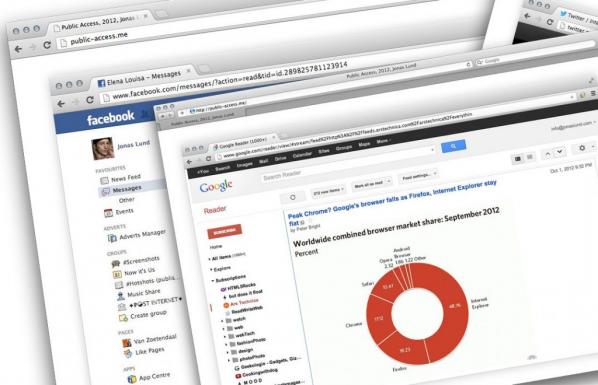
JL: Web technology changes rapidly and what is possible today wasn’t possible last year and while most art forms are rather static and change slowly, net art in particular has a context that’s changing on a weekly basis, whether there is a new service popping up changing how we communicate with each other or a revaluation that the NSA or GCHQ has been listening in on even more facets of our personal lives. As the web changes, we change how we relate to it and operate within it. Public Access Me and Selfsufing are looking at a very specific place within our browsing behaviour and breaks out of the predefined format that has been made up for us.
There are many works within this category of privacy sharing, from Kyle McDonalds’ live tweeter, to Johannes P Osterhoff’s iPhone Live and Eva & Franco Mattes’ earlier work as you mentioned. While I cannot speak for the others, I interpret it as an exploration of a similar idea where you open up a private part of your daily routine to re-evaluate what is private, what privacy means, how we are effected by surrendering it and maybe even simultaneously trying to retain or maintain some sense of intimacy. Post-Snowden, I think this is something we will see a lot more of in various forms.
AD: Is your new piece Disassociated Press, following the 1970s algorithm that generated text based on existing texts, a next step in this process? Why is this specific algorithm of the 70s important now?

JL: Central to the art world lies e-flux, the hugely popular art newsletter where a post can cost up to one thousand dollars. While spending your institution’s money you better sound really smart and using a highly complicated language helps. Through the course of thousands of press releases, exhibition descriptions, artist proposals and curatorial statements a typical art language has emerged. This language functions as a way to keep outsiders out, but also as a justification for everything that is art.
Disassociated Press is partly using the Dissociated Press algorithm developed in 1972, first associated with the Emacs implementation. By choosing a n-gram of predefined length and consequently looking for occurrences of these words within the n-gram in a body of text, new text is generated that at first sight seems to belong together but doesn’t really convey a message beyond its own creation. It is a summary of the current situation of press releases in the international English art language perhaps, as a press release in its purest form. So, Disassociated Press creates new press releases to highlight the absurdity in how we talk and write about art. If a scrambled press release sounds just like normal art talk then clearly something is wrong, right?
The Arts Catalyst in partnership with Furtherfield
Gallery tour with the artists, Saturday 21 June 2pm
The SEFT-1 exploration probe will be on display next to the gallery 20–22 June, 11–13 July, 18–20 July and 25–27 July 2014.
SEE IMAGES FROM THE PRIVATE VIEW
Ivan Puig and Andrés Padilla Domene (Los Ferronautas) built their striking silver road-rail SEFT-1 vehicle to explore the abandoned passenger railways of Mexico and Ecuador, capturing their journeys in videos, photographs and collected objects. In their first London exhibition, SEFT-1 Abandoned Railways Exploration Probe – Modern Ruins 1:220, commissioned by The Arts Catalyst and presented in partnership with Furtherfield in their gallery space in the heart of Finsbury Park, the artists explore how the ideology of progress is imprinted onto historic landscapes and reflect on the two poles of the social experience of technology – use and obsolescence.
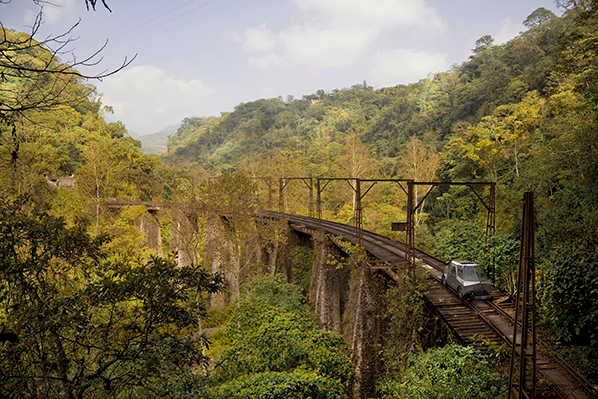
Between 2010 and 2012, the artists travelled across Mexico and Ecuador in the SEFT-1 (Sonda de Exploración Ferroviaria Tripulada or Manned Railway Exploration Probe). In a transdisciplinary art project, they set out to explore disused railways as a starting point for reflection and research, recording stories and testimonials as well as the landscapes and infrastructure around and between cities. Interviewing people they met, often from communities isolated by Mexico’s passenger railway closures, they shared their findings online, www.seft1.com, where audiences could track the probe’s trajectory, view maps and images and listen to interviews.
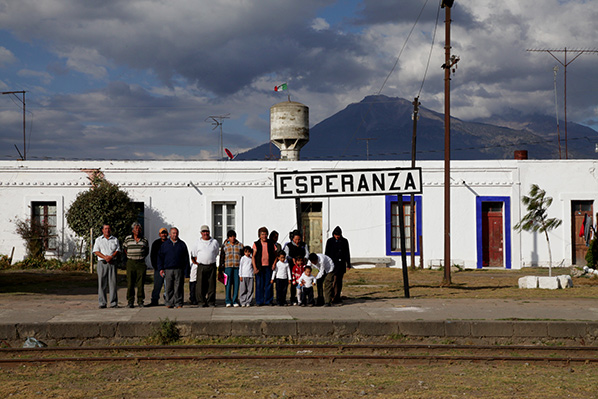
The artists’ journeys led them to the notion of modern ruins: places and systems left behind quite recently, not because they weren’t functional, but for a range of political and economical reasons. In the second half of the 19th century, the Mexican government partnered with British companies to built the railway line that would connect Mexico City with the Atlantic Ocean – and beyond to Europe. This iconic railway infrastructure now lies in ruins, much of it abandoned due to the privatisation of the railway system in 1995, when many passenger trains were withdrawn, lines cut off and communities isolated.
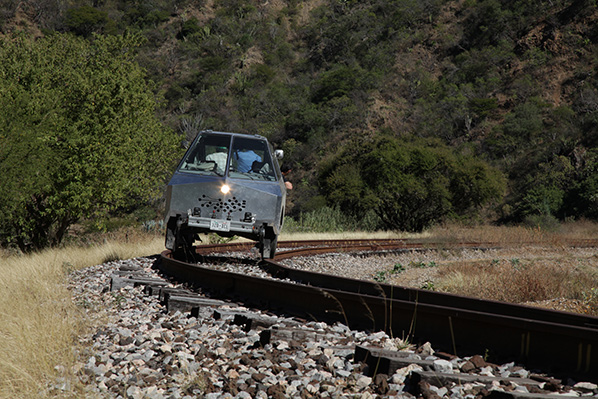
For this new exhibition, the artists are inviting British expert model railway constructors to collaborate by creating scale reproductions of specific Mexican railway ruins exactly as they are now. One gallery becomes a space for the process of model ruin construction. The room’s walls will show the pictures, documents, plans and other materials used as reference for the meticulously elaborated ruin construction. With this action a dystopian time tunnel is created.
Ivan Puig (born 1977, Guadalajara, MX) has exhibited internationally in Mexico, Germany, Canada, Brazil and the United States. He is the recipient of a number of awards and residencies including the BBVA Bancomer Foundation Grant for the SEFT-1 project (2010-2011) and the Cisneros Fontanals Foundation (CIFO) Grant in 2010. Puig, a member of the collective TRiodO (with Marcela Armas and Gilberto Esparza), lives and works in Mexico City.
Andrés Padilla Domene (born 1986 in Guadalajara, MX) has exhibited work in various contexts including ISEA 2012 (Albuquerque, New Mexico), The National Museum of Art MUNAL (Mexico City, 2011), 04 Transitio_MX (Mexico, 2011), and EFRC, Centro de Arte Contemporáneo (Qutio, Ecuador, 2012). His video work as director and producer with Camper Media includes documentaries, fiction films and TV shows.
Tuesday 17 June 6.30–9.00pm – artists Ivan Puig & Andrés Padilla Domene will be in conversation with The Arts Catalyst curator Rob La Frenais during London LASER 04 at University of Westminster (book here)
Saturday 21 June 2pm – Gallery tour with the artists, FREE
Saturday 21 June 3–5pm – A de-industrialised estate – Talk with Dr Malcolm Miles and discussion with the artists at Furtherfield Commons – (limited capacity £5, details and online booking here)
Saturday 12 July 11.30am–1.30pm – Drop in to the gallery and meet model railway maker extraordinaire Neville Reid and artist Andrés Padilla Domene, FREE
Saturday 12 July 2–4pm – Death Collapsing Into Life – Guided walk along Parkland abandoned railway with landscape architect, urbanist and writer Tim Waterman (limited capacity £5 and up to two children under 15 free, details and online booking here)
With support from Embassy of Mexico, Arts Council England, Central de Maquetas.
Furtherfield Gallery
McKenzie Pavilion, Finsbury Park
London N4 2NQ
T: +44 (0)20 8802 2827
E: info@furtherfield.org
Furtherfield Gallery is supported by Haringey Council and Arts Council England
Featured image: A live portrait of Tim Berners-Lee (an early warning system). Thomson and Craighead. March 2012.
Flat Earth was published to accompany two solo exhibitions. The first, Not even the sky at MEWO Kunsthalle, Memmingen, Germany from 26 October 2013 – 6 January 2014 and the second Maps DNA and Spam at Dundee Contemporary Arts, Scotland from 18 January – 16 March 2014. The book contains a foreword by Axel Lapp, essays by Dundee Fellow Sarah Cook and DCA Director Clive Gillman as well as an interview with the artists by Steve Rushton.
On the whole, the mainstream art world has failed to ‘convincingly’ adapt to (new) media art and similar contemporary art practices using networks and technology. Thomson & Craighead have overcome this impasse and this is one of a few reasons why they’re so interesting to look at as contemporary artists. The book, Flat Earth does not propose to cover all of their art and this review does not propose to cover all that it is featured in it. The review features Flat Earth Trilogy, The End, October and TRIGGER HAPPY (not in the book).
“Their work provides us with a new perception, through
a completely unexpected multi-focal perspective. They reveal
the wide ramifications of systems of information exchange and
provide us with an insight into the resulting infrastructure of
our own thinking.” [1] (Alex Lapp 2013)
TRIGGER HAPPY: Shooting The Messenger.
Although TRIGGER HAPPY (1998), is not featured in the publication it provides a useful introduction to some of the ideas and conceptual approaches present in Thomson & Craighead’s later artworks. I first experienced the work online, but it’s also a gallery installation that takes the form of an early shoot-em-up arcade game, Space Invaders. This work reflects the sly and cheeky side of Thomson & Craighead and tells us how humorous they can be in their art. TRIGGER HAPPY is philosophical and playful. It asks the player to shoot down the text of Michel Foucault’s essay What Is an Author? published in 1969. [2]
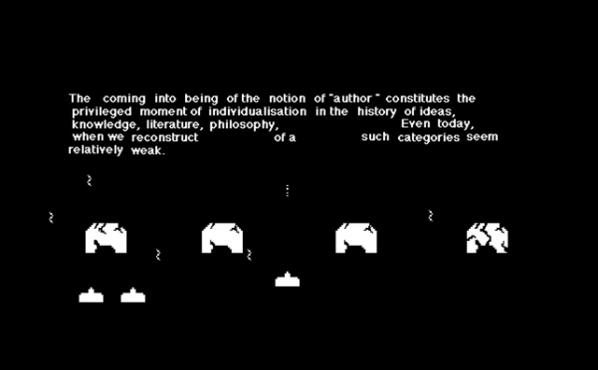
Foucault said the depiction of knowledge is a production and truth is produced, and it is always a reconstructed falsification. In a way TRIGGER HAPPY gives us a chance to shoot at Foucault, who in this respect is the annoying messenger. At gut-level, this art object recognises that on the whole we prefer to shoot at things or play games, than to deal with the complex and pressing questions of our time. Even if the gamer does manage to destroy Foucault’s text, this action prompts an existential enactment of doubt and induces a more vulnerable state of interpassivity. This relates to the illusion of agency when playing games, using corporate online platforms like Facebook and other experiences involving interaction with media, and it can also be extended to life situations. Slavoj Žižek proposes that interpassivity is the opposite of interaction and says “that with interactivity a false activity occurs: ‘you think you are active, while your true position, as it is embodied in the fetish, is passive’. Žižek refers to the Marxist notion of commodity-fetishism to imply that social relations are increasingly reduced to objects (Žižek, 1998).” [3]
We can almost hear the catchphrases “it’s only a movie” or “it’s only a game” as we are compelled to shoot at rather than attend to the messages that may serve to enlighten us and free us from our societal conditioning.
Flat Earth Trilogy: A networked society’s gaze at its mediated self.
The Flat Earth Trilogy is a series of documentary artworks each made entirely from information found on the World Wide Web; with fragments collected from people’s blogs, This covers a six-year period beginning with Flat Earth (2007) A short film about War (2009/2010) and then ends with Belief (2012).

Commenting on A Short Film About War, on their website, Thomson & Craighead write “In ten minutes this two screen gallery installation takes viewers around the world to a variety of war zones as seen through the collective eyes of the online photo sharing community Flickr, and as witnessed by a variety of existing military and civilian bloggers.” [4]
In the book Flat Earth Steve Rushton discusses with Thomson & Craighead why he feels A short film about War works for him best. He says, “It seems to make a claim on truth – which is the traditional claim of the documentary in particular and photography in general – whilst at the same time it shows us that truth is constructed.” [5] (Rushton 2013)
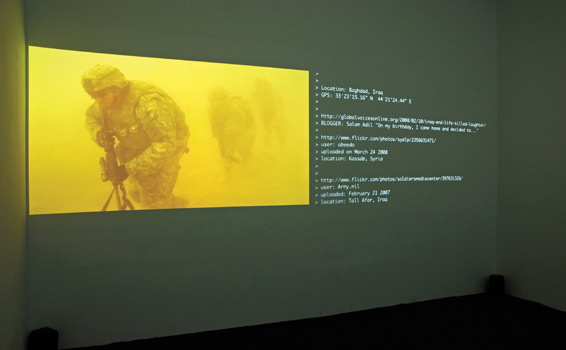
These works challenge our notion of what a documentary is, what and who the author is, and leaves us with the question, what does this mean for the wider society? This brings us back to Foucault’s ideas on the production of truth and its falsification. Tom Snow writes “In the essayistic act of image compilation then, the piecing together of filmic clips and stills distorts the dividing line between fiction and fact, and reimagines the enigmatic relations between photographic mediums and the condition of representation.” [6] (Snow 2009)
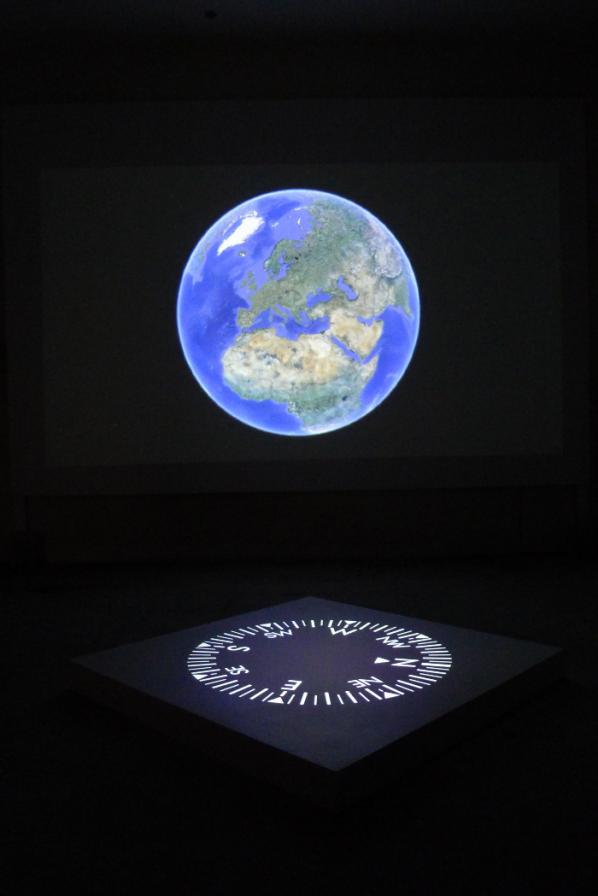
Flat Earth, A short film about War, and Belief all relate to topics concerning human values, conflicts, militarism and everyday societal struggles. “Machines,” wrote Gilles Deleuze in his examination of Foucault’s thought, “are always social before being technical. Or, rather, there is a human technology before which exists before a material technology.” [7] (Berger 2014) And so the technologies we produce are another materialization of the continuing human story.
Millions of people, en-masse, are uploading their personal data (different indications of their states of being) to a collective assemblage. Alex Galloway says that in order to get a better understanding of what networks are we must put aside the idea that networks are a metaphor. He proposes networks as part of a materialized and materializing media. He views this as an important step toward understanding the “power relationships in control societies.” [8] (Galloway 2004)
“It is a set of technical procedures for defining, managing, modulating, and distributing information throughout a flexible yet robust delivery infrastructure.” And “More than that, this infrastructure and set of procedures grows out of U.S. government and military interests in developing high-technology communications capabilities (from ARPA to DARPA to dot-coms).” [9] (Ibid 2004) Galloway’s distinction helps us to re-evaluate what he sees as distracting tropes and uncritical interpretations of the Internet, the World Wide Web and Web 2.0.
Thomson & Craighead provide parallel insights through their artwork into the protocols and technical procedures governing the functions of networks. However, human existence and human experience has a relationship with these networks and, out of millions of interactions, evolves not metaphors but fragmented symbolisms and stories. These are telling us about a networked society’s gaze at its mediated self. And this is where art can play a special role in critiquing, communicating and sharing the nuances of this emerging multitude.
The Flat Earth Trilogy presents us with a complexity where everything is flattened out. It maps out a human psyche from an anthropological perspective. And this leaves society to deal with issues concerning the human condition entwined within a machinic evolution.
This evolution has no physical body even if real lives and bodies are its source material “each mode is displaced by machinic evolution, mixing flows and the shifting codes and overcodes of power, the base forms continue onward, written directly into the heart of the system.” [10] (Berger 2014)

To further understand this work in relation to the machinic evolution, the networked gaze, and human interaction, I feel there is some value in considering hyperreality “…a condition in which what is real and what is fiction are seamlessly blended together so that there is no clear distinction between where one ends and the other begins.” [11] Hyperreality is a post-modern term used by Jean Baudrillard, Albert Borgmann, Daniel J. Boorstin, Neil Postman, and Umberto Eco. However, if we add a contemporary flavour to what hyperreality looks like now in a networked society we come up with hyper-mediality. “What we refer to as reality very often is just mediality, and also because that’s how human nature often prefers to observe reality, you know, via some media.” [12] (Ubermogen 2013)
We can see an example of this condition in an artwork by artists’ Franco and Eva Mattes, with their performance video No Fun (2010) [13] where they staged a suicide in the popular webcam-based chat room Chatroulette.
“Notably, only one out of several thousand people called the police. Moving beyond the aspects of shock and provocation, this touches on a basic question: What does “reality” mean in the digital age?” [14] (Eva & Franco Mattes)
The Flat Earth Trilogy throws up many questions and you’d be forgiven for thinking we need another book to fully examine the ramifications of these artworks. Instead let me to refer you to other related texts by Tom Snow, Edwin Coomasaru, Jo Chard, and Alan Ingram by clicking here http://www.inmg.org.uk/archive/thomson-craighead/catalogue/

Shifting Sands.
Clive Gillman in his essay in Flat Earth says “if artists are to find a way to assert a commentary or expression through these emerging forms of contemporary media, they will have to do this by reconciling the resistance of these new media objects to be ordered into a form that may represent a recognisable notion of artistic intent. And it is into this challenge that Thomson & Craighead pitch themselves.” [15] (Gillman 2013)
It is not the audiences who have difficulties with emerging forms of contemporary media it is the mainstream art world, and this is most of its magazines, galleries and museums. From our own experience of showing art and technology at Furtherfield Gallery, audiences tend to be adventurous and open-minded regarding their experiences with technology and societal issues. And yet the art world has had difficulties making a place for this work.
Sarah Cook and Christiane Paul, both curators well versed in the field of media art, have tirelessly offered us convincing arguments why this is. Christiane Paul says, “Many curators and other practitioners in new media seek to “teleport” the art out of its ghetto and introduce it to a larger public.” [16]
Sarah Cook says “artists who are really working with technology are still redefining art. So they’ll always be “in emergence” [..] They always will try to change the boundaries of what we think Art is and challenge the institutions that show it.” [17] This is true with Thomson & Craighead’s installation and networked artwork. It is plugged directly into a larger, expansive, worldly discourse, in contrast to traditional modes of artistic and news presentation which are highly restrictive and contained within their mediated monocultures.
Gillman proposes that Thomson & Craighead are pitching themselves to create art which is a recognisable notion of artistic intent, and other artists should do this also. I am assuming this is so the work is recognisable as ‘art’ to the mainstream artworld and its traditional remits. This is a strange ask if you are an artist who is truly exploring further than what is typically expected by mainstream art culture. I would argue that artistic context and its values are not fixed and that’s the point. If artists become too self conscious in trying to make their art look like an art that “fits”, it then looses its imaginative edge and critical reasoning.
It’s a difficult balancing act if the artist is examining deep or necessary questions whilst the current art world is lagging behind in so many ways. Julian Stallabrass sees this lagging behind as a political issue. In his book Contemporary Art: A very Short Introduction, he critiques the blocking of emergent, and critically engaged artistic expression as part of a ‘New World Order’ where we are constrained by a compliant culture controlled by the rampant demands of a corporate elite, who only consider art in terms of economics, markets and brands. And these restrictive and dominating frameworks are dedicated to the neoliberal promotion of privatisation and growing inequalities.
In his article ‘Reasons to Hate Thomson & Craighead’ he says “At this point, the art professional sees a world crumbling, visions of empty galleries, unique works owned by everyone, a stuttering and then failing of artspeak amid a mass proliferation of ‘work’ and comment, the autonomy of art ruptured, artists and dealers redundant, in short an economy broken and the sacred polluted with the profane. Naturally, representatives of the old order, more or less sharply aware of dark clouds gathering at their horizons, have good reason to hate Thomson & Craighead.” [18] (Stallabrass 2005)


Thomson & Craighead’s work connects with people and they know this because they use content and themes people are thinking about in their everyday lives. This is what makes the series of documentary artworks so powerful. It assembles what is going on in the world in ways that traditional documentary and news channels are not. And this is their real challenge, because if they continue to reflect human culture as it happens with works like October – a documentary artwork about the early rise and fall of the Occupy movement – they will be highlighting messages from a world of people in need of something different than what is currently in place, whether this is deliberate or not. This art has a strange irony, it not only asks us what a documentary is, but it also asks what is news?
The End.

The End is a site-specific artwork first shown at the Highland Institute of Contemporary Art in 2010, Scotland. It is situated in one of the gallery rooms at H.I.C.A that has a large, wall-sized window looking out onto the countryside in the Highlands. It is an intervention into the space where the words ‘The End’ are fixed onto the glass in a style and scale one might associate with the end credits of a movie.
The combination of the outside natural environment, the galley building with its large glass window, and the added text, are assembled together to build a whole artwork. If any these components were taken out of the assemblage it wouldn’t work. This tells us how well crafted Thomson and Craighead’s work is and how much attention is paid to detail.
When looking at The End, one cannot help feeling a little out of sync. It is like a monument or an obituary for a lost world or lost time when we were all standing on solid ground and felt we knew what was real and not real. The End brings into play the rhythms of a larger natural environment and works as a bridge between two worlds or the illusion of it. It reminds us we are no longer experiencing the world face on or directly, but the world is re-introduced to us mainly through screens, televisions, mobile phones and our computers. It also invites us to imagine as we look out on the beauty of the natural world that we are viewing the end of our own role in the story of humanity.
The Situationist, Guy Debord said that people’s alienation was once about having things and claiming better working conditions, but then it moved onto being about a state of appearing. Meaning, it is not producing things, or even owning things that drives society but rather how things appear and how they make us appear. The glass acts as a filter and an interface, a place of safety distant from the touch of the wild. Its physicality, metaphors and symbolism offers a poetic moment for us to consider how perceptions about ourselves and ideas concerning real-life have changed, and what this means.
On the DCA website as part of its commentary about the book, it says Flat Earth presents Thomson & Craighead as pioneers in the field of new media for nearly twenty years. Sarah Cook and Christiane Paul also deserve credit as pioneers for recognising, supporting and dedicating their lives to creating the contexts in contemporary art culture for Thomson & Craighead’s work and other artists’ works. Also, Cook has edited a fine publication. Flat Earth is well designed and the whole book is meticulously well put together with quality images throughout. The mix of inteviews and essays with Thomson & Craighead give the reader a well balanced overview of their the art and their ideas, it is unpretentious and explores their focus as creative and thinking individuals artistically, conceptually and critically. We need many more of these types of books to support this dynamic and ever-changing field.
Thomson & Craighead dig deep into the algorithmic phenomena of our networked society; its conditions and protocols (architecture of the Internet) and the non-ending terror of the spectacle as a mediated life. When reading the Flat Earth publication, you get a clear impression of their conceptual rigour. They know their place and role as artists in society and this is well presented in the book. Their collaborative journey has remained faithful to the World Wide Web, and the Internet as a focal point and a content provider for their art practice.
It would be simplistic to assume they are embracing technology as a celebration of its progress. Their critical scope examines big issues and this is evident in Flat Earth. They belong to a generation of artists who are experimenting with real time data, networks, web cams, movies, images, sound and text; as part of an anthropological venture that studies humanity’s relationship with technology, alongside the inane and profound nature(s) of the human and non-human condition. We exist at a point where ubiquitous computing now redefines our point of presence, shifting our perceptions in reference to cultural tags and repeated experiences of mediation. They successfully critique these changes. Not only to other artists, curators and galleries, but to all who are being transformed by technology and this is what makes them essential and contemporary.
Thomson & Craighead are not just making and showing art they are also presenting questions. These are not invented questions they are already out there. But, just like some need an interpreter to translate different dialogues they are assembling for us the dialogues of an emergent multitude.
In “How Readers Will Discover Books In Future“, science fiction author Charles Stross envisions a future in which weaponized eBooks demand your attention by copying themselves onto your mobile devices, wiping out the competition, and locking up the user interface until you’ve read them.
This is only just science fiction. Even the earliest viruses often displayed messages and malware that denies access to your data until you pay to decrypt it already exist. ePub ebooks can execute arbitrary JavaScript, and PDF documents can execute arbitrary shell scripts. Compromised PDFs have been found in the wild. Stross’s weaponized ebooks are not more than one step ahead of this.
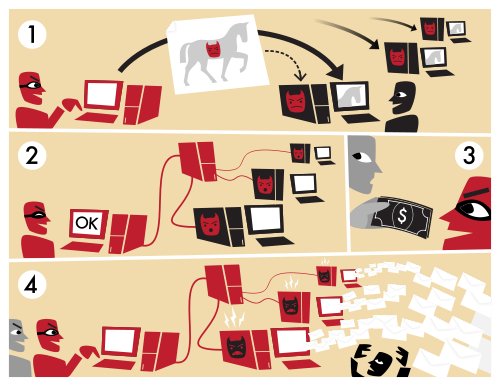
Why would eBooks want to act like that? To find readers. In the attention economy, the time required to read a book is a scarce resource. Most authors write because they want to be read and to find an audience. Stross’s proposal is just an extreme way of achieving this. In Stross’s scenario, authors are like the criminal gangs that use botnet malware to get your computer to pursue their ends rather than your own, use adware to coerce you into performing actions that you wouldn’t otherwise, or use phishing attacks to get scarce resources such as passwords or money from users.

As so much new art is made that even omnivorous promotional blogs like Contemporary Art Daily cannot keep up, scarcity of attention becomes a problem for art as well as for literature. And when people do visit shows they spend more time reading the placards than looking at the art. In these circumstances Stross’s strategies make sense for art as well. Particularly for net art and software art.
A net or software artwork that acted like Stross’s vampire eBooks would copy itself onto your system and refuse to unlock it until you have had time to fully experience it or have clicked all the way through it. It could do this in web browsers or virtual worlds as a scripting attack, on mobile devices as a malicious app, or on desktop systems as a classical virus.
Unique physical art also needs viewers. Malicious software can promote art, taking the place of private view invitation cards. Starting with mere botnet spam that advertises private views, more advanced attacks can refuse to unlock your mobile device until you post a picture of yourself at the show on Facebook (identifying this using machine vision and image classification algorithms), check in to the show on FourSquare, or give it a five star review along with a write-up that indicates that you have actually seen it. In the gallery, compromised Google Glass headsets or mobile phone handsets can make sure the audience know which artwork wants to be looked at by blocking out others or painting large arrows over them pointing in the right direction.
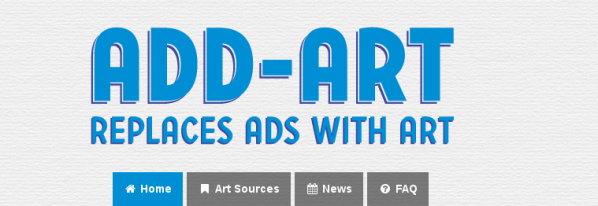
Net art can intrude more subtly into people’s experiences as aesthetic intervention agents. Adware can display art rather than commercials. Add-Art is a benevolent precursor to this. Email viruses and malicious browser extensions can intervene in the aesthetics of other media. They can turn text into Mezangelle, or glitch or otherwise transform images into a given style. In the early 1990s I wrote a PostScript virus that could (theoretically) copy itself onto printers and creatively corrupt vector art, but fortunately I didn’t have access to the Word BASIC manuals I needed to write a virus that would have deleted the word “postmodernism” from any documents it copied itself to.

Going further, network attacks themselves can be art. Art malware botnets can use properties of network topography and timing to construct artworks from the net and activity on it. There is a precursor to this in Etoy’s ToyWar (1999), or EDT’s “SWARM” (1998), a distributed denial of service (DDOS) attack presented as an artwork at Ars Electronica. My “sendvalues” (2011) is a network testing tool that could be misused, LOIC-style, to perform DDOS attacks that construct waves, shapes and bitmaps out of synchronized floods of network traffic. This kind of attack would attract and direct attention as art at Internet scale.

None of this would touch the art market directly. But a descendant of Caleb Larsen’s “A Tool To Deceive And Slaughter” (2012) that chooses a purchasor from known art dealers or returns itself to art auction houses then forces them to buy it using the techniques described above rather than offering itself for sale on eBay would be both a direct implementation of Stross’s ideas in the form of a unique physical artwork and something that would exist in direct relation to the artworld.

Using the art market itself rather than the Internet as the network to exploit makes for even more powerful art malware exploits. Aesthetic analytics of the kind practiced by Lev Manovich and already used to guide investment by Mutual Art can be combined with the techniques of stock market High Frequency Trading (HFT) to create new forms by intervening in and manipulating prices directly art sales and auctions. As with HFT, the activity of the software used to do this can create aesthetic forms within market activity itself, like those found by nanex. This can be used to build and destroy artistic reputations, to create aesthetic trends within the market, and to create art movements and canons. Saatchi automated. The aesthetics of this activity can then be sold back into the market as art in itself, creating further patterns.

The techniques suggested here are at the very least illegal and immoral, so it goes without saying that you shouldn’t attempt to implement any of them. But they are useful as unrealized artworks for guiding thought experiments. They are useful for reflecting on the challenges that art in and outside the artworld faces in the age of the attention-starved population of the pervasive Internet and of media and markets increasingly determined by algorithms. And they are a means of at least thinking through an ethic rather than just an aesthetic of market critique in digital art.
The text of this article is licenced under the Creative Commons BY-SA 4.0 Licence.
Featured image: Reactor Halls E09: Psychotronic Reactors Ryan Jordan & Jonathan Kemp // Photo: Julian Hughes
Intro: Nathan Jones has his head bent by an evening of psychogeophysics and laboratory manufactured noise at Reactor Halls E09: Psychotronic Reactors, by Ryan Jordan & Jonathan Kemp, at Reactor’s new space in Primary, Nottingham. Photos by Julian Hughes.
Approaching an abandoned school in Nottingham as dusk fell, I hopefully considered a new subgenre of science fiction. After the Social-Science Fiction recently reinvented in the film work of Ryan Trecartin, perhaps then the Lab-Science Fiction of the psychogeophysicists. An authored art of reality, one that intrudes under the pretense of the experimental environment and appropriates the materially integral as theoretically freakish.
A red throbbing smoke seethes out of two open windows at the side of the building, blue and yellow light jumps across the window ledge, electric whip-cracks heard down a corridor.
This is the ambience of Kemp and Jordan, UK practitioners of ‘psychogeophysics’. The location is Primary, the new art space in Nottingham, home to art experience specialists Reactor and thirty of the city’s other independent art initiatives – but in the weekend evenings, all-but-abandoned. The eerie emptiness of the building lends itself to the increasing feeling of having slipped into a fiction.
I enter the old school through a side door, some lost parent in a nightmare, through an empty hall, on the verge of an integral, unfathomable assessment.
The background reading on psychogeophysics[1] is rich with conceptual freakery, based on the application of experimental conditions to pick up signals and messages from the spiritual other – such as the notorious Electronic Voice Phenomena experiments of Konstantin Raudive, which reportedly discerned the voices of the dead in electronic noise. The term psychogeophysics itself is a half-tongue-in-cheek addition to the always-already-playful ‘psychogeography’ adding to concerns with the summative effects of environment and mind on arts practice, with a pataphysical enquiry into the earth’s wave-spectrum effects as they impact on consciousness.
Kebab coagulates with tension, rises up like a deep brown lava-lamp fluid.
Kemp and Jordan, today’s psychogeophysics representatives, work at the edges of the believable, taking inspiration and theoretical modes from outside – through the discredited or unfashionable sciences of the mind and matter which proliferated in the 18th century – and projecting them into an experimental arts environments in the form of dystopian noise/rave-scapes.
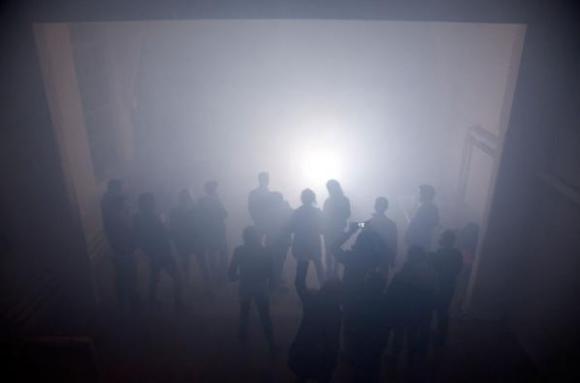
It’s a seductive atmosphere. But this isn’t a confidence trick, and the initial uncanniness is offset quite quickly by the manner of the artists themselves. Jonathan Kemp and Ryan Jordan have an approach which is the precise inverse of music-hall tricksters. Their diverse range of practices – taking in electronics and chemistry, installation, sound-performance, workshops – are unified around an obsessively open and unassuming approach, which is somehow difficult to reconcile with exotic conceptual grounding, and the promise of hallucinatory, out of body experience of the event. Throughout the evening, this integral conundrum between cynicism and being on the edge of discovery, plays out as a series of modesties, odd-ball crackpot demonstrations, chatty cigarette breaks, and noise abuse.
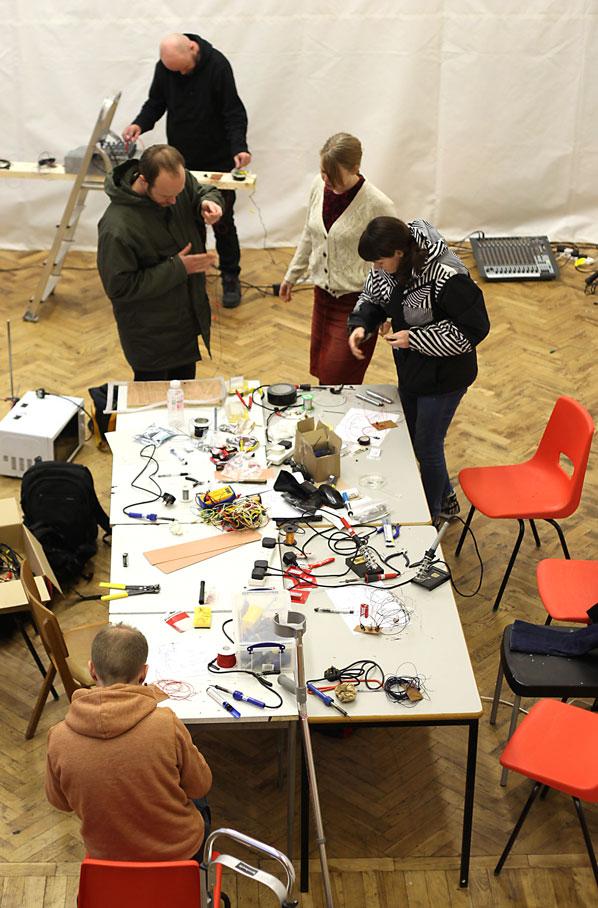
The basis for this evening’s bill was a laboratory workshop run by the artists, where participants – Nottingham based artists and Reator’s own esoteric cadre – could make their own devices with basic electronics – one for picking up electromagnetic waves, and another ‘solo-strobe’ unit which allows the user to stick two LED lights melted into lab glasses up close to their eye. It is these glasses that provide the first ‘performance’ moment of the night. We are invited to put the glasses on, and they are wired into the sound system, so each time the light goes on or off it makes a popping noise. Keeping our eyes closed, we can alter the frequency at which the lights flash on our eyes, and the resulting pulses or screams.
Blood strains in eye-lids. Crystaline salt remnants on pupil. Granular arrangement of optical receptors just before the brain. A familiar green and purple mesh which sieves the world into your soft-matter. Turning, the green grains mould together into white-hot orbs.
A pattern emerges where Kemp and Jordan take it in turns to set up and overload to breaking point a kind of ephemeral circuit between electronic equipment, geological objects, and our own nervous systems. Are we humans, or resistors?
The optical nerves, neuronal receptors and bodies of the audience are, to varying degrees of success, co-opted into a system of electro-magnetic flow across wires and solid matter – one which theoretical precursors might attribute to any number of things, from spirit-world contact, to the healing properties of rock, but that the artists themselves seem content to simply evolve and then break.
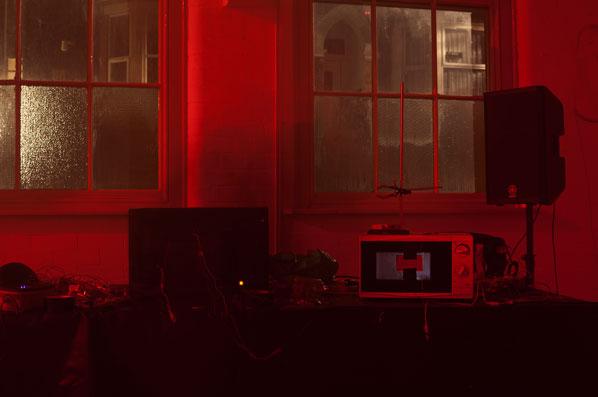
Jonathan Kemp puts tinfoil in a microwave that has a solar panel taped to it. He strings together a number of circuits made by workshop participants, and wires them to a large rock. There is the feeling of being part of something truly special and interesting, twinned with the feeling that an entirely intelligent and sane person might consider the whole evening to be some kind of elaborate joke on an unwitting reviewer. It isn’t a complementary train of thought to follow, and one which inevitably leads you to wonder whether the evening could be better presented. Why no introductions, no accompanying materials, no ‘show’? For a moment, I imagine my mum and dad standing in the centre of the small school hall demanding to know what is going on.
Back inside after a cigarette in the cracked and melted night, we are finally barraged with a single strobe light, by Ryan Jordan. There is a set of crystals set in front of the strobe also, so the electromagnetic pulses given off by them as innate response to the light stimulation, make the speakers pop and crack. The timing of light and sound is immaculate, and richly textured. Our own circuitry fully descended now from the cerebral, critical, suspicious human being, to a purely biological system, granulating, flipping on and off with the light and sound. Somewhere deep inside the purple matter a tiny voice wondering when it will end.

Rising, the mesh pulled upwards by the orbs distorting the front of the eyeball, pushing up at the iris like a small hot hand. The brain responds with a rumbling tide on its underside. The glitching and popping at the ears make your mouth turn up into a grimace.
Among the noise, the roughness and the seeming ambivalence of the artists towards the audience, a feeling of our own innate connection to the technological and chemical comes across very strongly. This connectivity is the hard-won evocation of two artists who have invested fully in the material consequences of their media, a feeling which has lasted well beyond the evening, for me. I did wonder though, whether this one successful evocation is dependent on the anti-showmanship of the artists, or in fact limited by the attention paid to the audience experience – a contrast which is especially stark given the context of the Reactor collective’s own portfolio of experiential arts environments. Perhaps not a new genre of sci-fi then, but a discipline that insists along with the noise practices of the last few decades, on the outer limits of entertainment.
Autonomous spaces, autonomous networks, boxes and forks – we invite all DIY lovers to come and join us for an afternoon of re-appropriation of networking technology to bypass the censorship and liberate our files.
What does a free culture look like? What is technology that supports it? For many years artists (among others) have been engaging with these questions, challenging restrictive laws and regulations as well as complex technical solutions. A new surge in search for practical solutions to file-sharing, easier to use and incorporate to our everyday life is the focus of this workshop. On the day we will install and use Piratebox and Librarybox on various devices to test their promise.
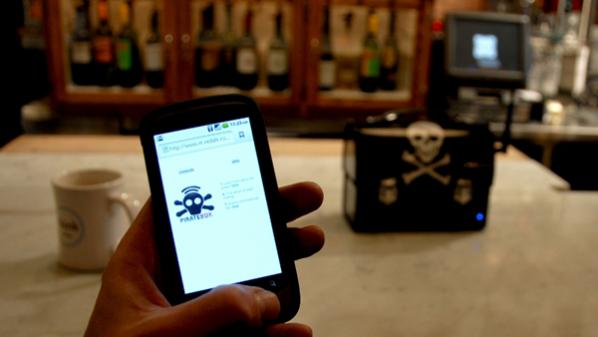
Inspired by pirate radio and the free culture movements, PirateBox utilizes Free, Libre and Open Source software (FLOSS) to create mobile wireless communications and file sharing networks where users can anonymously chat and share images, video, audio, documents, and other digital content.
Piratebox fork, LibraryBox is an open source, portable digital file distribution tool based on inexpensive hardware that enables delivery of educational, healthcare, and other vital information to individuals off the grid.
+ For more information about the event please contact Larisa Blazic.
Flossie is for women interested in using open source as coders, artists and social innovators. We run an annual conference and also regular events in London.
Furtherfield Commons
Finsbury Park
Near Finsbury Gate On Seven Sisters Road
E: info@furtherfield.org
Furtherfield Gallery is supported by Haringey Council and Arts Council England.
Codasign, in partnership with Furtherfield, will be running a new series of creative technology workshops for different ages at Furtherfield Commons, a hub to connect and activate local and international communities of artists, technologists, thinkers and doers.
Interactive Puppet and Story Workshop
Saturday 15 February 2014
10am – 12:30pm – 6-9 year olds
2-4:30pm – 9-12 year olds
Come and learn how to create your very own interactive hand puppet which tells you a story using Scratch and MaKey MaKey!
Create a Tron Hoodie
Sunday 23 February 2014
11am – 1pm
Upcycle your hoodie using electroluminescent wire.
Make Your Own Platform Game With Scratch
Saturday 1 March 2014
10am – 12pm – 6-9 year olds
1:30-4pm – 9-12 year olds
Learn how to create your very own platform based computer game in Scratch!
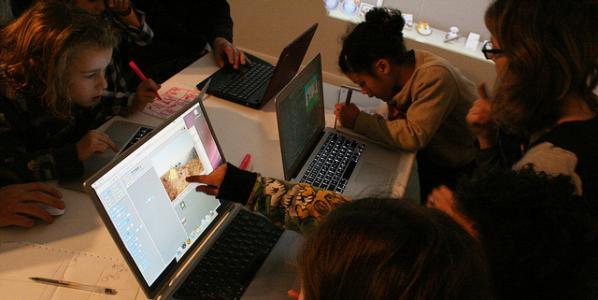
Miniature Circuit House
Saturday 15 March 2014
10am – 12pm – 6-9 year olds
1:30 – 3:30pm – 9-12 year olds
Wire up your own shoebox sized house using different electronic components which will be inserted into a circuit drawn with Bare Conductive‘s paint.
Soft circuit phone badge
Saturday 22 March 2014
10am – 1pm
Create a soft circuit badge which flashes when your phone receives a text message or is ringing.
Make a Musical Instrument with Paint, Scratch and MaKey MaKey
Saturday 24 May 2014
10am – 12pm – 6-9 year olds
1:30 – 4pm – 9-12 year olds
Come and learn how to make a conductive painting to control a musical instrument that you’ve created in Scratch and MaKey MaKey!
For more information and to book a place to any of the workshops please visit Codasign website.
All supporting material for the workshop will be available at learning.codasign.com.
VISITING INFO
Located by Finsbury Gate entrance on Seven Sisters Road
T: 0208 802 1301
E: info@furtherfield.org
Just think about the ordinary, and by that I mean not an ordinary life, event, custom, or thing (at least not yet), but the ordinary as such.
We can never fully exhaust the ordinary – how could we? For as sure as we try to get close, the ordinary becomes something else. Elusive – in the same way that words, peoples, names and symbols become strange if we concentrate on them too long. Neither does anyone grasp the ordinary in sheer ignorance, because its ordinariness just evaporates in retrospect. The ordinary claims little attention only because it is ordinary and is implicitly taken on that account. The extraordinariness of the ordinary has to be rejected if its implicitness becomes something we unavoidably accept. Yet, its givenness appears unproblematic insofar as it remains unacknowledged. The ordinary is what happens when we’re concentrating on something else: it is what constitutes the ontological furniture of the world.
Nevertheless, the ordinary remains drastically important, as it always was: and yet its implicitness already remains curiously forgotten, waiting to be exposed or made present. As Charles Bernstein writes in The Art and Practice of the Ordinary, “any attempt to fix the ordinary pulls it out of the everydayness in which it is situated, from which it seems to derive its power.” Representations and objectifications of the ordinary claim transparency to its own cost.
“Science” wishes to naturalise the ordinary into a neat little piecemeal encroachments of textbook knowledge and then move towards the next eliminative paradigm. Technology commandeers the ordinary seeking to render it more efficient and effective for the benefits of, well, hardly anyone but futurists. Traditionalists seek to undermine the ordinary in favour of some primordial ordinary which benefits some reactionary stupor. Global neo-liberalism commandeers the ordinary even further, waging that no-one will change anything in it for lack of time or for opposing the marketplace. Everyone has access to the ordinary, even though the ordinary remains unaccessible.
Yet it seems that whatever we do, whatever new particle is discovered, whatever new economic theory found, or new conceptual scheme offered – the coordinates of “normality” and “convention” might change, for some at least, but soon after the ordinary returns, with a hidden shrug and an hour to kill. Faster computation and digital transmission may have egged a generational shift of Western production, knowledge, communication, control, community, yet the ordinary still prevails only by re-shifting and re-configuring itself: different uses, words, things, together with different uses of words and things. The concrete acknowledgement of banal yet entirely extra-ordinary things constitute the bizarre ecology of the ordinary, which operates regardless: detached memes, first-world jokes, boredom, mediocre top 10s, compassion, political intrigue, scoops, as well as emotional heartache.
Different cultures, tribes, gangs, and communities have their ordinaries: everyday customs and uses, most different, some utterly indifferent to one other. Some ordinary customs hold the relevancy of others to account. Yet the ordinary is clearly there, unshakeable and implicit, yet also unmistakable and haunting, without any essence of natural custom to which it can be easily assigned. It has just a background assumption of ‘bleh’, or ‘meh’ with no distinctive features to explicitly signal its silent functioning.

Why am I waxing lyrical abut such matters? I do so in the effort of introducing an underdeveloped but convergent alternative. Not one that has any justification nor merit of its own, but one that exists, for the most part, as an epistemological alternative to what has hitherto been called accelerationism: and how the tensions and similarities of both positions impact art, literature, science and especially systems.
The doctrine of accelerationism is accelerating, as it should be (Twitter hashtags and all) making giant leaps in art and cultural theory circles. By no means does it signal anything concrete, (at least not yet) than it provokes the insistent beginnings of a modern political doctrine: one that joins up similar threads of interest across disparate thinkers and topics. Of late, it has enjoyed multiple discussions online, a recent symposium in Berlin, the sole topic for an e-flux journal on aesthetics, a forum held last year, and an expectant anthology from Urbanomic.
Coined by Benjamin Noys in The Persistence of the Negative: A Critique of Contemporary Continental Theory, the acceletrationist doctrine takes many forms, but by and large, its aim is to accelerate, conceive, invert and uproot capitalist infrastructures and abstractions using the abstract epistemic resources of capitalism itself. For Marx and Engels this required the dialectical development of capitalist contraction towards its ‘inevitable’ destruction. Deleuze and Guattari famously mused that the process of capital was to be accelerated, and in its darker, more heightened levels (most famously, the macabre futurist machinic practice of Nick Land), it meant pushing the social deterritorialising force of capitalism into its inevitable post-capitalist future.
In its early stages, accelerationism established a darker, more virulently techno-nihilistic strain of theoretical terror. Land was spellbound by the 90s demonic growth of neoliberalism: for it possessed, not just some freaky quality of being utterly impervious to any resistance of leftist critique, but the singular quality of accelerating unparalleled technological progress. Land’s future was a rumbling techno-capital singularity smuggling itself within collapsing human civilisations until the latter would eventually be creamed off. These views eventually drove Land out of academia but remained a curious alternative to other political responses: a darker alternative to fields of protest, against disruption, antonomist intervention, situationist détournement, hackitivism or a resuscitated dialectical antagonism.
Filtering out the hysteric reactionary stupor of Land’s thought, contemporary thinkers have begun to rethink accelerationism beyond the squalid drive of accelerating capitalist contradiction. Nick Srnicek and Alex Williams, who co-authored the widely circulated Accelerationist Manifesto, have clearly articulated this view, rejecting Land’s singularity but endorsing the use of capitalist quantification techniques, engineering, infrastructure, persuasive models, and advanced computational affordances to accelerate the modern left. Whereas leftist thought has sought to question, undermine or even reverse modernity, Srnicek and Williams suggest that radical thought must accelerate the mediums of capitalist production into a post capitalist future. They proudly assert that “if the political left is to have a future it must be one in which it maximally embraces this suppressed accelerationist tendency.”
Against what Srnicek and Williams term “folk politics” (the title for their forthcoming publication) – defined as “localism, direct action, and relentless horizontalism” – an accelerationist politics preserves neoliberal infrastructure, but intends to push its affordances faster than neoliberalism would allow: in particular a basic universal income and the reduction of work (through automation). For them, folk politics has no big picture, nor any infrastructural plan beyond a ‘the party’ or a ‘horizontal network’: no method of effectivity or material advancement. In a separate article they condemn the conservative left for reducing themselves into “trafficking in the politics of fear, rather than the politics of freedom and the project for a more just society”.
Technology is to be used as method of “furthering leftist goals”, that is, building a material platform for a genuine post-capitalist societal framework. The emphasis is on accelerating modernity and progress, not accelerating contradictory speed (the latter evident in, say, high frequency trading), investing an understanding of post-capitalist infrastructure through new economic models and repurposed machinery. There is no wiggle-room here for Srnicek and Williams: either build a post-capitalist future or don’t. Either establish or experiment towards a broad ideological vision for accelerating the future or repeatedly fail. Failure, in their eyes, is not a thing of beauty, but a path towards an alternative future. Instead of leftist faith, Srnicek and Williams advocate alternative means of building an infrastructure of the future.
And there’s a lot here to agree for the most part. The left has instigated a lot of its own irrelevancy by ignoring or rejecting the often affective affordances of technology – rather than changing its use, or learning how to build a more just society. Yet, accelerationism’s major problem concerns itself with peddling a systematic theory to explain the practice of doing all the stuff the left failed to realise. What happens to the ordinary?

Within the accelerationist doctrine lies an old epistemological assumption that the problem with political thought is the rejection of progress, and the mastering of knowledge: that folk politics has suppressed knowledge and progress to its cost, whilst capitalism marched onwards and upwards, mostly upwards. All of this is partly accurate. Yet philosophically, accelerationism is more than these insightful remarks, and justifiable political demands. For Srnicek and Williams:
“The movement towards a surpassing of our current constraints must include more than simply a struggle for a more rational global society. We believe it must also include recovering the dreams which transfixed many from the middle of the Nineteenth Century until the dawn of the neoliberal era, of the quest of Homo Sapiens towards expansion beyond the limitations of the earth and our immediate bodily forms. These visions are today viewed as relics of a more innocent moment. Yet they both diagnose the staggering lack of imagination in our own time, and offer the promise of a future that is affectively invigorating, as well as intellectually energising.”
Accelerationism then, is not just a new doctrine for the left whom have failed to reignite the dream for a better future, endlessly squabbling over moralistic games of trumpery, but a renewed praxis (and only that) of enlightened self-knowledge. Accelerationism is a renewed humanism that seeks to re-master the world. As a “Right-Accelerationist” this is as much as Land wants, accelerating reactionary aristocracy past democratic values (Land’s so-called Dark Enlightenment). As “Left-Accelerationists, Srnicek and Williams declare that only a radical “maximal mastery” of renewed Enlightenment values will secure victory over capital, in an age where modern infrastructure is constituted by complexity and systemic automation.
“This mastery must be distinguished from that beloved of thinkers of the original Enlightenment. […] But this is not to align ourselves with the tired residue of postmodernity, decrying mastery as proto-fascistic or authority as innately illegitimate. Instead we propose that the problems besetting our planet and our species oblige us to refurbish mastery in a newly complex guise; whilst we cannot predict the precise result of our actions, we can determine probabilistically likely ranges of outcomes. What must be coupled to such complex systems analysis is a new form of action: improvisatory and capable of executing a design through a practice which works with the contingencies it discovers only in the course of its acting, in a politics of geosocial artistry and cunning rationality. A form of abductive experimentation that seeks the best means to act in a complex world.”
In this guise (as well as Land’s), accelerationism resumes the Enlightenment’s dictum of ‘dare to know’ – to pursue moral knowledge under the name of rational universalism, to which the ‘daring’ or ‘cunning’ part isn’t limited to empirically tracking or modelling post-capital infrastructures, nor of resuscitating the modern ethos (quite why Enlightenment thinkers are assumed to be beloved isn’t addressed, but hey ho). Instead, their task consists in expanding human rationality beyond its current epistemic state and limit, to test the critical faculties of human knowledge, and extend them without apologising, without any dint of skepticism. That it really could demonstrate the “best means” of acting in a post-industrial society. It aims to accelerate the human mastery of the concepts as well as the technical infrastructures to which it cohabits. The human ‘we’ must be self-constructed, such that – in their words – we “collectively come to grasp our world such that we might change it.”
Such a grasping or understanding wants to, at the bottom of everything, reduce or eliminate the ordinary. Thus capitalist infrastructure isn’t just an infrastructure but also a manifest limit of what it means to be familiar in a community: within that it must be universally unified into a rational community of self-knowledge. It is our concepts and rational freedom, our everyday experience which is to be extended, sustained, accelerated, even beyond the pale vagaries of our solar system. The ordinary is inherently set to be eliminated in accelerationism: and this becomes a problem.

By all means, accelerationism’s recent trajectory and increasing prominence (especially in Berlin) is a moving target, and so not all the arrows fired at it intend to halt that movement, nor what it might spawn. Our provocation towards, what I call ‘ordinaryism’ is less of a tactical move, not a hostile polemic, certainly not a threat, than it is a sympathetic twin operating alongside accelerationism’s endorsement of universal self-mastery. The philosophical fate of the human creature, tends to re-assert self-mastery from time to time, until it runs out of steam, or submits to itself that the best “science” undercuts its own majestic foundations, leading to critical revisions. Ordinaryism is not intended to trump accelerationism, than it is presented as an alternative to think about the ignorance of limitations within human finitude and of human creatures, which constitute the very presence of the ordinary. Ordinaryism doesn’t advocate a traditional ‘ordinary’, natural, ‘way of life’ against future mastery – nothing of the sort – rather, it seeks to expose the hidden wound of human mastery which becomes unavoidable.
Ordinaryism is presented as what might be left over once accelerationism has finished in avenging the limits of rational concepts (and the violence in doing so), such that the ordinary always returns, inherently unwelcome, but always ambiguous. That accelerationism will be beset by the mark of tragedy, finitude and disappointment: but in ordinaryism’s eyes, this is to be accepted and resettled. Of course accelerationism, by its own definition, cannot abide disappointment: manifestos are not the best means of articulating disappointments.
It is only after a state of affairs has been accelerated, that ordinaryism begins and works with the reconstruction or resettlement of the everyday, of what we already took for granted. Whilst accelerationism reimagines the future by eliminating the everyday, ordinaryism reimagines the entanglement of the everyday which weaves in and out of our collective grasp endlessly. We might indeed change the world, but in most cases, it feels like the ordinary changes us. Ordinaryism resembles and works through the difficult unsolvable left-overs of accelerationism, where it must be collectively reconstructed, rather than collectively mastered.
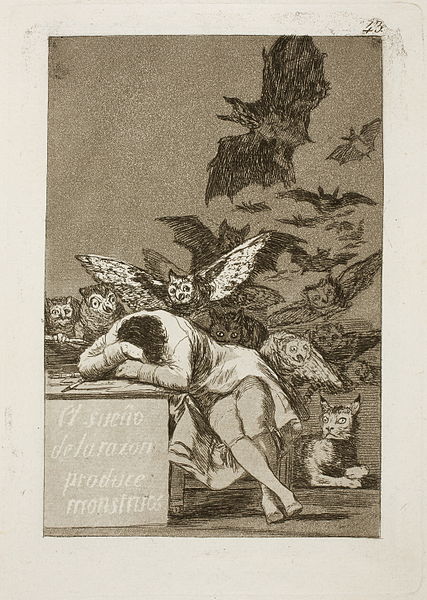
To prise open this debate further, we have to set up a philosophical/historical split that encompasses both world-views – namely, a set of philosophical attributes which partly make up accelerationism and ordinaryism’s similarities and tensions. All philosophical topics are quite good at this from time to time: historical figures count as manifest gaps, whom might inherit one particular zeitgeist, but whose differences from it continue to play out in subsequent world-views. The transcendent forms of Plato, vs. the individual forms of Aristotle: the determinate computational rationality of Leibniz vs. the determinate horizontal immanence of Spinoza: The scepticism of Kant’s concepts to never know the ‘thing in itself’ vs. Hegel’s absolute motions of the concept that can: Heidegger’s horizon of withdrawn Being vs. Wittgenstein’s later ‘forms of life.’
Without preaching to anachronism, the split between accelerationism and ordinaryism follows these gaps in various ways. The split discussed may be established within the predominant influence of two American analytic philosophers, who have had little recognition in continental philosophy and scarcely their political vicissitudes. They are Wilfrid Sellars and Stanley Cavell, and both of their contemporary philosophical systems are cited here for a number of reasons: both philosophers are prolific contemporaries, who from the 1950s, worked tirelessly after the rejection of logical positivism (Sellars in founding a materialist, nominalist inferentialism – Cavell as a second-generation ordinary language philosopher, writing after Wittgenstein and J. L Austin). Both are completely influenced by the foundations of Kant and the teachings of Wittgenstein, albeit different stages. Both jointly understand the human condition to be a product of the rules and standards of language, holistically used in a social community and both have dedicated their careers to moral and ethical questions that are produced from such insights. That’s about where the similarities end, important as they are.
More controversially, both thinkers have in some method or other, been cited as attempting to represent a bridge between analytic and continental philosophy, despite such a incessant institutional divide remaining. Clearly, to establish any such divide is prone to error, insofar as the term ‘continental’ – established by analytics – only pithily defined other thinkers who ‘don’t do what they do’. What’s interesting here, is the sense of the world-view to which such bridge-building is actioned.
The ‘continental’ use of Sellars is fairly recent, and has taken place conterminously with the rational analytic wing of (what is usually referred to as) speculative realism, most notably Ray Brassier’s recent work (despite him rejecting the movement entirely). Brassier himself, has sought to make Sellarsian epistemology central to the materialist future of continental philosophy, appealing to thinkers who seek to break away from an affirmation-vitalist induced metaphysics (Deleuze & Guattari), deconstructionist accounts (Derrida, Butler), or a post-Hegelian dialectical materialism (Žižek/Badiou).
What is pivotal for Brassier is that a Sellarsian legacy points towards a recoding of continental post-Hegelian framework set within an analytic project of scientific realism. This is where accelerationism finds its enlightened humanist teeth, even if it isn’t explicitly Sellarsian: an analytic-continental framework, which accurately establishes a set of arguments enlightening human conception (that we can scientifically speculate on what human rationality is) and to go to work putting these tools into pragmatic action, with the hope of extending our reign of knowledge. That in its scientific efficacy, both Sellars and the return to Hegel reflects one basic insight: that the special human affordance of ‘knowing’ must be identical with what it knows.
In his recent article The Labor of the InHuman: (parts [1] and [2]) Reza Negarestani has promoted similar accelerationist principles within a similar universalising project of humanism. Quoting Negarestani, Inhumanism establishes the same accelerationist dictum: which “stands in concrete opposition to any paradigm that seeks to degrade humanity either in the face of its finitude or against the backdrop of the great outdoors.” In any case, Sellarsian tropes are all over Negarestani’s and the accelerationist enterprise: such as how one justifies what one says in the “space of reasons”. How reasoning exists as a universal, meta-linguistic evolutionary natural function, which once grasped, eliminates the ambiguities of using it. Even Sellar’s students (notably Robert Brandom) have begun to reengage with the systematic potentials of Hegelian philosophy. All equally share an implicit rejection of romantic thought.
A Sellarsian future is unquestionably wrapped up in an accelerationism one, insofar as a) both distinguish what functions are essential to human rationality (inferential sapience), from biological functions (animal sentience), and then b) use such epistemic assurances to take account of discursive practices and establish moral actions. The Hegelian end-game, as it were, is to not only establish (with certainty) the laws of thought, but to show how the possibilities of the world’s laws (Being) and rational laws (appearance) are one and the same: that is, rationally accessible through enlightened reason. What is important to such insights are that the conditions of finitude cannot be attached to such accounts: i.e. Sellars’ account of what concepts are in a community (that is inferential semantics) have no bearing on what can or can’t be known by an individual. All intuitive ambiguity must be rooted out: such that ‘what I can deduce is what I know’ and that such ‘ought to dos’ are necessary yet speculative features of grasping the best moral actions.
Stanley Cavell however is immeasurably harder to pin down: not least because whilst recognised as a major analytic American philosopher, he has never been discussed with much, if any, resounding depth in continental circles, and remains substantially unknown to various audiences who would stand to benefit from his work. Cavell’s thought is thoroughly respected, maybe referred to, yes, but was historically disregarded once the analytic mission ‘to know everything’ through cognitive science resumed itself and sidelined ordinary language philosophy. Secondary literature on Cavell continues to grow however, particularly on studies of literature, film (literary studies in general), American studies, Shakespeare, animal studies, political philosophy and even pedagogy.
Yet, if there is one thinker who attempted to unite both analytic and continental world views since the 50s it is Cavell, only he tried it in reverse. Usually, the analytic way of treating continental texts is to de-romanticise them, by eking out or condemning what is purported to be rational arguments. Cavell went the other way, and sought to romanticise the analytic tradition by showing that it never had any absolute rational arguments in the first place. Thus, Cavell was emphasising ambiguity and the instability of language, independent of Saussure, Lacan, Habermas, even Derrida, and way before structuralist and poststructuralist texts arrived on our Anglophone shores in the 60s. Before Continental philosophy ever thought Žižek (or perhaps Baudry before him) was radical in combining philosophical insight into American cinema, Cavell caused disconcerting ripples in analytic circles when he starting doing it in the late 60s, and arguably did it better.
More significantly Cavell’s style of writing, like his thought and world-view, screams prose which is most un-analytic: ambiguity. His work does not fit into any noticeable philosophical idiom. Largely auto-biographical, entirely playful, but never simple – his insights are analytically complex, but written with an attitude much akin to the continental tradition: which is to say, staggeringly allusive yet direct. This, of course, matches Cavell’s heroes, whose prose preys upon and exudes ambiguity: namely the giants of Emerson and Wittgenstein. No wonder Cavell often expresses little interest in meaning anything bar “the accuracy of wording an intuition”. (In Quest of the Ordinary: 53). From here on in, unless otherwise stated, all citations are from In Quest of the Ordinary.
If Sellars is compelling for accelerationists because of his rigorous, technical accounts of what abstract concepts are in a scientific realism, Cavell is compelling because he presents an alternative difficulty: one that proceeds from not knowing: or a willingness to forgo it. There is no technically demanding jargon in Cavell: and barely a consistent systematic technique. He constructs arguments through atmosphere and intuitive lines of enquiry. Sentences which hold moments of stillness, generating an idea and then ending abruptly, but following on through wispy moments of insight, much like a musical score (Cavell began his career as a musical prodigy). His general register freely embraces philosophical insights with auto-biographical notes (philosophy just is autobiographical for Cavell), abstract deductions with concrete experiments, literary ideas with film experiences, Shakespearian tragedy with jazz overtones.
But Sellars and Cavell’s differences are exemplified not just by style, but also by the content and reception of their philosophical outlook. Reception wise: Sellars technical prose, which borders on being life-threateningly dull, provides the kind of challenge which the muscular philosophers among us feel the need to measure up to and surpass, like a scientific research grant or an unsolved mathematical problem. Ineffably technical to the end, Sellars excels in the matter of deductively writing in a certain way, to get out the theorems one is looking for. That reason, and reason only, is the true method of grasping things. To read Sellars then, is to know what one wants (to resolve the gap between oneself and one’s world) and to expect a result at the end of it: an account that answers the thorny issue of explaining, accounting or defining the ordinary within the “scientific image” and proceeding from there.
Cavell, unsurprisingly, establishes the complete opposite: the reader has no quick response, no general method of opposition to his ideas. There isn’t meant to be one. This is a philosopher, who takes pride in admitting that he tried to make Thoreau’s Walden more difficult, not on the adoption of jargon, but on the basis of how it educates problems in philosophy. Philosophy for Cavell, never makes any genuine progress, so neither should his writings. Philosophy will never be able to model itself successfully on the sciences, as it never thrives on deductive answers. Philosophy does not command a privileged relationship to reality, as it thinks science does or science thinks of itself: only the knowledge of science would purport the demolition of the ordinary, to which it’s own practice depends on. Accelerationism, likes other disciplines renders matters as supreme to themselves, such that the ordinary, monotonous means of how they got there are lost: their complexity squandered into an easy simple vision (its no surprise that Cavell was a close friend of Thomas Kuhn at UC Berkeley, and amongst other influential affinities, introduced him to Wittgenstein).
The Cavellian method actively incites disturbances and tensions in the reader, but ones that cannot be assimilated into one easy position or framework, where an effective solution is baldly asserted. Reading Cavell is akin to finding one’s own voice, in the midst of accompanying Cavell’s own. This is an important quality. And so, both Sellars and Cavell differ immeasurably in their accounts of what can be rationally asserted as real, and how the possibilities for how human language can be used. In fact, its not so much a differing account, but a diametric opposition.
Cavell’s relationship to what I’m calling ordinaryism, matches Sellars relationship to accelerationism in one formal sense: a collection of world-view tools set to work on two separate problems occurring in post-Kantian philosophy. For Sellars, the aim of philosophy from Kant onwards is to blatantly ‘solve’ Kant’s transcendentalism, insofar as philosophising operates as a “stereoscopic fusion” accounting for one privileged insight of knowing how one’s concepts work and how one functions. As Cavell puts it, “the aim of reason [is] to know, objectively, without stint; to penetrate reality itself.” [The Claim of Reason, 431]
In this regard, Cavell’s approach to language and humanity, is presented as a legitimate alternative to the latter: namely that the ordinary is a worthwhile avenue for philosophy and political change, not to eliminated out of existence: to be looked for and lived in, but not to be known. What does it mean to abide with reality? Is that even enough? This is the question of the ordinary.

To that effect, the entire epistemological role of the human creature changes (Cavell prefers ‘human creature’ to subject or rational agents): for Sellars and the accelerationist world-view, the human creature’s basis in the world must self-master its own conceptual possibilities for freedom, like a cognitive open-source self. For Cavell and the ordinaryist world-view, the ordinary human creature’s basis in the world, takes interest in its skeptical limits. In Cavell’s words, “the human creature’s basis in the world as a whole, its relation to the world as such, is not that of knowing, anyway not what we think of as knowing.” (The Claim of Reason: 241) That the skeptical limitations of knowledge are not failures of it, but an attempt to bargain with the things-in-themselves.
I emphasise this contrast between Sellars and Cavell, mainly to bring about an old Cavellian insight as to why accelerationism originates in the form that it does, and why it does.
This issue is present in Cavell’s understanding of modern skepticism: the deceptive fraudulence of what one experiences, the feeling of distrust to that which becomes given. Cavell’s innovative treatment of scepticism is never given its dues: perhaps as the broader interpretation of recent theory in the midst of ecological catastrophe, technological infrastructure and global networks, has done away with concentrating on such banal philosophical problems. When the environment is disintegrating and a just world seems more unlikely, old problems of wondering whether ‘we’re dreaming’ or not, seem less and less justifiable.
Fair enough: but this is not Cavell’s insight into skepticism. Skepticism for Cavell is less a rigorous method or intellectual exercise than it is a relation to the world that establishes itself within living in the everyday. “My idea”, as Cavell writes in In Quest of the Ordinary, “is that what in philosophy is known as skepticism is a relation to the world, and to others, and to myself, and to language, that is known to what you might call literature.” (155) Skepticism, following Wittgenstein and Heidegger, is not about whether one refutes knowing anything outright, but a mark or basic feature of finitude that constitutes human existence. It is not the case that skepticism is true, (i.e. relativism) but of re-emphasising the irrefutability of truth within skepticism. In his words, written elsewhere, the problem of skepticism does “not consist in denying the conclusion of skepticism but in reconceiving its truth” [The Senses of Walden, 133].
The legitimacy of scepticism reminds us of the contingency of criteria that a society possesses of itself. We can never be absolutely certain of ourselves and our relation to the world, nor of our words, nor of securing what they mean. To understand what we mean by a moral utterance, or command is to already bring the ambiguity of the world to such utterances, and any attempt to narrow such definitions, of making them explicit, or grounded in certainty, is utterly doomed. Language does not await precise explicit, functional use, but is unintentionally bubbling through us within contingent slips, mistakes and failures. What we mean, must forever stay implicit if we are to communicate at all.
Cavell’s target of course were the logical positivists, who did aspire to such certainty. Cavell reinterpreted their philosophy thus: instead of actually knowing a truth, or claiming some cast-iron logical proposition which brings human knowledge closer to reality, the logical positivists distanced themselves from the ambiguity of the ordinary even further. The logical positivists evacuated the ordinary, attempting to fill it with an artificial, scientific theoretical language of functional certainty, whereupon deductive answers, much like scientific theories would emerge, hard won and settled as fact. Cavell allied himself as an American interpreter of Oxford’s ordinary language philosophy (particularly J. L. Austin’ work), a new technique of undermining logical semantic certainty by emphasising how a certain word or game is used within a society, as established in Wittgenstein’s Philosophical Investigations.
Yet Cavell went further and deeper than other ordinary language philosophers by aligning their insights towards a renewed focus on post-Kantian scepticism (in the same historical manner Sellars achieved with his own philosophy) – on how one lives, or how a society functions despite these irrevocable conditions of finitude. No doubt of course that fundamental to the human condition is to know: to make the world more present, to solve skepticism. This is what Kant ultimately achieved: to bargain with skepticism and establish a conceptual stability founded on epistemological mastery, which Sellars thinks he has extended and accelerationism follows in equal measure.
But such stability comes at a price. The bargaining of building Kant’s transcendental a priori synthetic knowledge, assures us that the thing-in-itself exists, yet we are forced to give up true knowledge of it. At the cost of preventing human thought from lapsing into crippling doubt, Kant prevents us from gaining knowledge about the world we know exists beyond us. In short, Cavell argues that Kant gave up intimacy with the things in themselves in order to establish conceptual certainty. “You don’t – do you?” Cavell laments, “have to be a romantic to feel sometimes about that settlement: Thanks for nothing.” (31)
Cavell’s interpretation of logical positivism followed this line of diagnosis: the human creature performs a certain kind of violent satisfaction in response to the discovery of its limitations, where our relation to the world is contested. And its this sense of anti-romantic satisfaction which accelerationism excels at: not stopping at self-mastery, but of suspending illusions, and building a platform for Promethean expansion. Its own form of bargaining with human mastery and planning for a more ‘just’ world, may appear effective, but still carries with it all the same Kantian bargaining tools of a settlement which it has little hope of fully mastering. That’s the trouble with bargaining with the noumenon: the other party (the things in themselves) might deceive and hoodwink the terms of agreement.
Caught in the bind of disappointment with the world, and of being a disappointed species because of it: we are a set of creatures who are continually ordinary. Accelerationism appears less a system of bargaining, than a wish fulfilment. One that accelerates Kant’s bargain into some unknown techno-future, on a foolhardy whim that rationality is somehow more significant than everything else, or rather, such mastering will always get on the best side of the agreement. A revenge against the romantic that dared to suggest something else.
Ordinaryism offers no such remedies, and any appeals to such expansions are fragile, fraught with tragedy or crafting goals out of the banal facets of the ordinary. Bargaining with skepticism, is in Cavell’s eyes, simply a redirection of its difficulty. In his preface to Must We Mean What We Say? he presses his finger on this salient point:
“The idea that there is no absolute escape from (the threat of) illusions and the desires constructed from them says there is no therapy for this, in the sense of a cure for it … [that] was evidently something that captured my fascination halfway through Must We Mean What We Say? with Samuel Beckett’s Endgame––in effect a study of the circumstances that, “You’re on Earth, there is no cure for that.” [Must We Mean What We Say, 129]
Au contraire, demands accelerationism, we have the moral cure! But to know it, you’re going to have to sacrifice the ordinary, and why not? As Cavell notes, the enlightenment’s conscience is likely to herald Kant’s achievement intact: the Sellarsian response may feel, yes Kant, “thanks for everything.” (53) However, in The Claim of Reason, Cavell utterly dismantled philosophy’s quest for the foundations of moral obligation, by showing that it too had bargained with Kant’s foundations for knowledge: that somehow, the dream, as is accelerationism’s dream, to fully render some natural method of grasping a common world to which everyone ‘reasons’ in a space. That reason: inferential reason, is supposedly enough of a confrontation to be, quoting Cavell, “sufficiently powerful [that] it must work on people at random, like a ray.” [The Claim of Reason, 326]
But the ordinary doesn’t exist as an implicit fallacy to be eliminated away by the confrontations of ‘science’. Instead it operates as a romantic supplement to monitor the stability of accelerationism’s settlement: both of satisfaction and dissatisfaction. There is then, a new profound sense of ‘thanks for nothing’ in accelerationism: one that is a measure of dissatisfaction with Romantic attitudes and of their current instability, under attack from speculative realism (of what Meillassoux terms correlationism), amongst other positions. Ordinaryism will argue that this measure of satisfaction with Kant’s settlement is a measure of its stability, one that has persisted to this day: and speculative realism is nothing if not a movement that has become entirely dissatisfied with it. In other words, acceptance of this settlement heralds the conflict of a different version, upgrade, or application of skepticism. A different bargaining.
Romanticism’s answer was to fully justify the existence of the world outside thought, and that the act of enlightenment’s self-mastery had itself lost nature, or even tried to kill it off. For the Romantics (Cavell being one) the task set before them, proceeds in how we can recover, or cure the world from the violence of this Kantian settlement. But this, as Cavell fully admits is also another bargaining, set up from scepticism itself. The first generation’s response to this Kantian settlement was romantic animism, another ‘thanks for nothing’ type of bargaining: that the world lives and dies, as if it were another being (55-56).
Cavell’s own response is to return to the ordinary, as per his interpretation of Wittgenstein. The return to the everyday and ordinary things, which must now bargain with scepticism, and not successfully. That is, “the drift toward skepticism as the discovery of the everyday, a discovery of exactly what it is that skepticism would deny … the impulse to take thought about our lives inherently seeks to deny” (170-71) The way that ordinary language is expressed, or, pushing Cavell further, how ordinary things are used is the challenge of acceptance – with the emphasis placed on challenge rather than acceptance. The issue becomes one of paring knowledge as one fragment of the ordinary, together with Cavell’s suggestion that:
“the existence of the world . . . is not a matter to be known, but one to be acknowledged. And now what emerges is that what is to be acknowledged is this existence as separate from me, as if gone from me. . . . the world must be regained every day, in repetition, regained as gone.” [172]
But to take this further, ordinaryism – and its romantic slant – now has to orient towards a different bargaining strategy, as accelerationism chooses to do. Accelerationism takes Sellarsian tropes and moves them further than Sellars ever realistically envisaged. Its form of bargaining enlists that which is most contemporary: science, computation and quantifiable knowledge. Accelerationism brings forth its ray-like vision, onto the realm of automated systems, extended science and machines. It is the site where rational progress becomes constitutive of a deterministic machine, following rules to an-already decided, method of reason, unanswerable to anything other than more reasons of settlement.
For ordinaryism, language is out of date and out of time. Ordinaryism must keep up with such developments, but not under the banner of progress or knowledge. Instead ordinaryism understands the ordinary within the entangled ecologies of media and machine: of that which we took, and still take for granted. Of what became radically altered once the ordinary mysteriously entered the realms of automation.
Cavell notes that the ordinary changed significantly after the abstraction of logical positivism: ordinary language looked uncanny after it, as if analytic philosophers were discovering for the first time how language, through little reason of its own, operates within the lost meadows of un-graspedness. Just as accelerationism enlists technology for its own sceptical bargaining, ordinaryism enlists the affordances of technology too – how we live in an ecology where such everyday automatedness is continually un-grasped. We must realign, as Cavell does, overlapping regions, “not in [the] deflections of skepticism but in … respect for it, as for a worthy other; I think of it as [a] recognition not of the uncertainty of failure of our knowledge but of our disappointment with its success.” [Emerson’s Transcendental Etudes: 118].
To this end, ordinaryism’s uncanniness must be taken up in automated systems and computational networks, but these appear not as extensions of knowledge, but as separate, wider fields of acknowledgment, to which knowledge is one fragment: not the defining mechanism. That complex systems produced from us within the ordinary, solidify dissappointments with reason’s success: of its extension and operation. And the opportunity to regain the ordinary still stands, but in the time of machines, and systems executing beyond ones finite knowledge: an ecological pluralism of finitude awaits those who wish to bargain anew: of our finitude and theirs.
Ordinaryism’s new dissatisfaction with scepticism specifies nothing more than to inject a romantic slant back into the heart of the machine.
————————
With sincere thanks to Paul Ennis who read through an earlier draft.
Eva Kekou met Tobias Rosenberger at the international e-MobiLArt workshop which took place in Athens, Vienna and Rovaniemi, in turn these led to a number of exhibitions and successful collaborations between artists and theorists. She now invites him to discuss his work, issues of surveillance and how a young European artist views the situation in China and what he expects from his interaction with the Chinese art scene.
Tobias Rosenberger (b. 1980) is a German media artist who works at the crossroads of media art, visual arts, and performance. He has produced art works in Yemen, Spain, Mexico, India, and Ukraine etc. Since 2011 he has been based in China, where he teaches at the College of New Media Art, Shanghai Institute of Visual Art.
“Nowadays, anyone who wants to combat lies and ignorance and to write the truth must overcome at least five difficulties. He must have the courage to write the truth when it is suppressed everywhere; the wisdom to recognize it, although it is concealed everywhere; the skill to use it as a weapon; the judgment to choose those in whose hands it will be effective; and the cunning to spread the truth among such people.” (Bertolt Brecht)
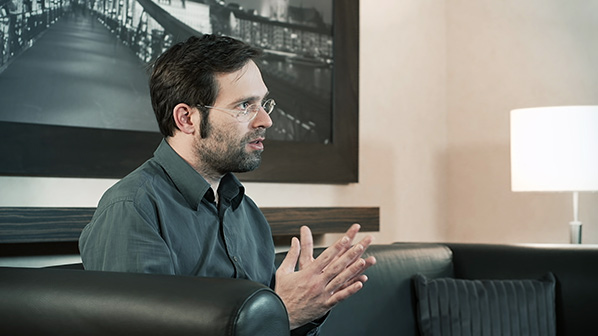
Eva Kekou: I would like to start this interview with this quote which seems to be significant for your work and in particular the recent one – the secret race film and discussion at Goethe Institut Washington. As you well state in your event invite: “It was pure coincidence that for a few days in the summer of 2013, two unrelated events simultaneously dominated the major headlines in the German press: the monitoring and spying scandal of 2013, triggered by Edward Snowden’s leaks of National Security Agency top-secret classified documents, and the official acknowledgement of the prevalence of doping in competitive sports, best symbolized by Lance Armstrong’s televised confession.” What is the significance of surveillance in a globalized social and political context and where is the place of art within it? There are obvious reasons you decided to launch this in Washington through Goethe but I would like you to comment on this.
Tobias Rosenberger: Surveillance and espionage are as old as civilization. Power was always constructed, maintained, and expanded through monitoring, categorising, repressing, and excluding people. We all know that the digital apparatus opens a new world of possibilities to organize, quantify and control life and society in a before unknown scale, speed and efficiency. While I agree that we need early warning models to anticipate and fight cruelty and injustice whenever possible, I don’t believe that we can draw a sharp border between an evil surveillance that fuels unfair and inhuman systems and a necessary one that pretends to save dignity and a lawful order. The challenges of our time can no longer be met by elitism and secretiveness, but require the joint efforts from the middle of society. An independent art that rejects the simple desire for (self-)confirmation does not only open a non-biased discursive space for critical reflection, but it also has the potential to demask and break the mechanisms of power, as long as it takes its audience seriously. But to be able to do so, art also has to find its audience.
EK: It occurs to me that place and space play a very important role in your work and inspiration. How do these relate with each other with pieces of your work in a globalized and mobile network underlined by politics?
TR: I have a very pragmatic approach to what I am trying to do: Not following a specific agenda and always staying as curious and open as possible. This requires both a certain naivety and an observing attitude. I never start an artistic process with a specific idea or question, but i get attracted by places and spaces that i try to discover without too much of my personal baggage. But since space and place are never abstract but segmented by politics both on macro and micro layers, the resulting works often deal with political questions.
EK: How did you become interested in China and what do you find fascinating or difficult working there? Is it interesting for you as a European?
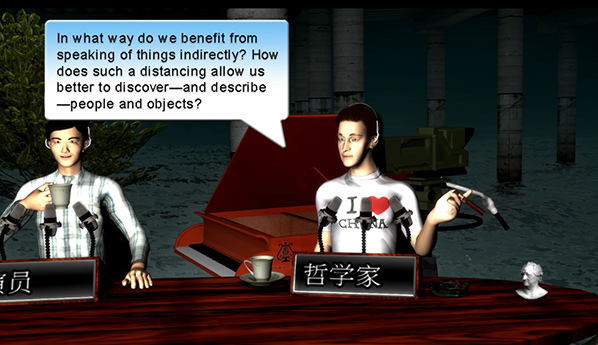
TR: I have a very special relationship to China. With my Chinese wife I decided three years ago to move there and to found a family. I was always fascinated by China as a cultural space, with a tradition of art and philosophy at least as long as in Europe. I also really like the food and the people there. As a foreigner I experience it as very fruitful to see things from a specific distance, both if I try to understand the culture, but also especially if I look back from there to where I come from. It is very interesting to observe the relation between art and politics, how the government here really appreciates art and how it is also afraid of it.

How artists, critics and curators fight for free space, a career, or both. In Shanghai you have both the global economy and the local life at your house-door. The country faces a lot of problems, and very often one can get the impression that things are not happening at all just because there is a small possibility that something unexpected could happen. So many people behave very pro-actively in a way that they won’t run into any problems themselves. But this maxim “to have everything running smooth” you certainly don’t only encounter in China.
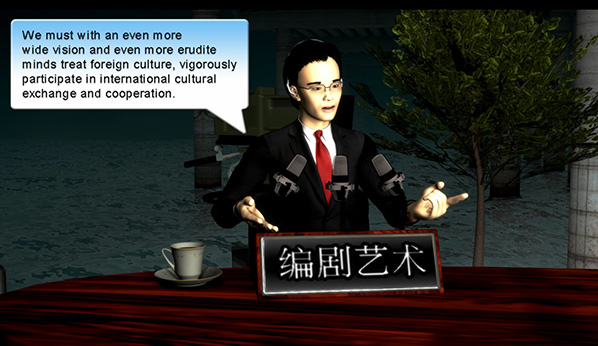
EK: Referring to some of your recent works (installation and performance): Choose any you like… How do you reach out to audiences and what is the main aim in your own work?
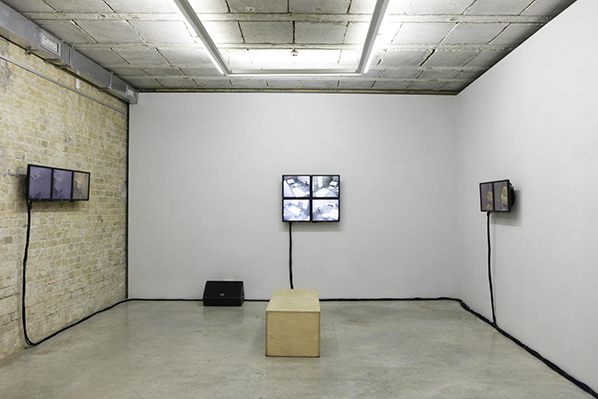
TR: “The First Twenty Years” is an installation that was shown in two different versions at the end of 2012 in Kiev and Dnipropetrovsk. I developed the basic idea for that work in 2011, when I was invited to spend some time in a small Ukrainian village near Kiev at a private artist residency programme. During that time the nation celebrated the 20th anniversary of its independence. There was a strange, partly paralyzed mood. But I also witnessed very controversial discussions with artists, curators and critics, and a new generation that seemed not anymore willing to accept living in a nation that was more and more perceived as a prison. So when I was approached during that time to do a work based on my experiences in the Ukraine, I decided to base it on Xavier de Maistres “Journey around my room” and Schuberts Music, which was inspired by a poem by Christian Friedrich Daniel Schubart.

I didn’t intent to comment directly on the situation there, but rather was trying to understand for myself what was happening. For me, art is not about expression but about the creation of a space where everybody is invited to take a bit of distance so to be able discover something from different perspectives and to think in his/her own way.
Surveillance Cameras dancing to Schubert, on Vimeo
EK: Can you give us a bit more information about a project that you have described alsewhere in the following way: “Right now working on a light sculpture for permanent setup in a former WWII Top secret military site, where some crazy NS-Germany scientist wanted to invent an x-ray wonder-weapon to shoot planes and soldiers, this involves an always transforming multichannel-sound installation, motorized miniatures (arduino-controlled), 2 projectors and led-objects. I will make an extra independent video of this work, filmed with multiple moving surveillance cams.”?
TR: I was approached by a cultural initiative that runs today a small history museum in a former research bunker, which was secretly constructed in 1942 / 1943 underneath a camouflage building. I came across a letter in which a certain Professor, Dr. Ernst Schiebold, proposed “An additional weapon to fight and eliminate the crews of hostile airplanes and ground troops in the defensive via x-ray and electron radiation”.
A weird ten pages male war fantasy about a new kind of tubular x-ray canon, written in a crude mixture of physical pseudo-science, soft patriotic enthusiasm and German pedantism. Schiebold really got his bunker built to start with his research. Everything was kept top secret, but stopped 18 months later without results. I decided to bring Schiebold’s proposal back into the space which only existed because of it: As a pure proposal, enhanced and communicated with new media technology.
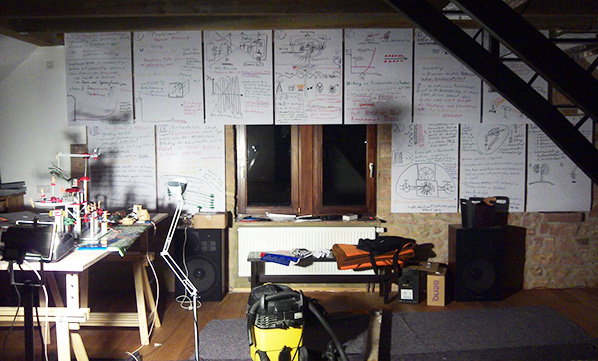
A lot of the tools that we are using as new media artists exist mainly through military development. So my intention was also to give something back. The audience will listen to single sentences that are randomly taken out of Schiebold’s letter and re-arranged into a constantly transforming synthetic sound atmosphere, which is synchronized with light beams crossing a motorized miniature military model. The toy miniatures cast shadows of moving soldiers and airplanes onto the walls. LED lights are flashing out of a tubular manhole, which was originally constructed to be used with a Betatron. All the technology that I use is quite low-budget and geeky. Last week I started to install the parts on site, and I have to admit that it is also a very weird experience for me to spend nights working alone in a former military research bunker, climbing down in a manhole and setting up the mockup of a “super-weapon” people researched in the darkest years of German history. Sure I will also try to document it properly.
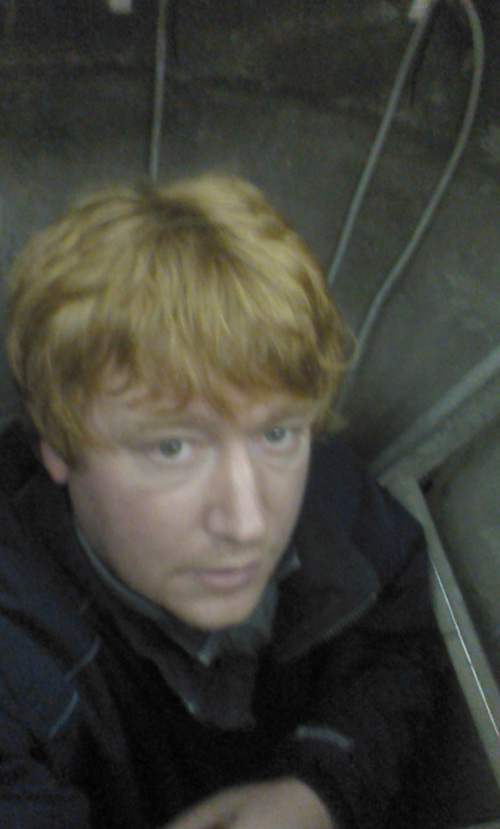
EK: Do you think art can be global and political, if not, what are the main restrictions we are all subjected to? How can art and artists make a difference in this respect?
TR: I think that art is per se political, since it deals with and also influences our perception of reality. And while all our lives are clearly connected in a global economy of good and information-exchange, art does also always operate on a global scale. As an artist I believe that it is worth to be curious and to investigate the (media) apparatuses and dispositifs that surround us, to take them apart and re-design them. What are they good for, what effects do they cause? While the world is getting closer, the world is never the same – people have different histories, problems, possibilities and hopes. As Europeans we take many things for granted, that other people see differently – or vice versa. I think artists can always make a difference, as long as they stay independent and continue to tackle serious questions, but don’t take themselves too seriously while doing so. We should laugh more together.
EK: What are your future aims and plans?
TR: I am looking forward to the new semester in Shanghai, where I will mentor the graduate works of eight students. I will also collaborate with Chinese artist Mujin (Lixin Bao) – a fellow teacher at the Shanghai Institute of Visual Art – on a series of works exploring the notion of the “Chinese Dream” and its perception both nationally and globally. I guess this dialogue will become quite interesting.
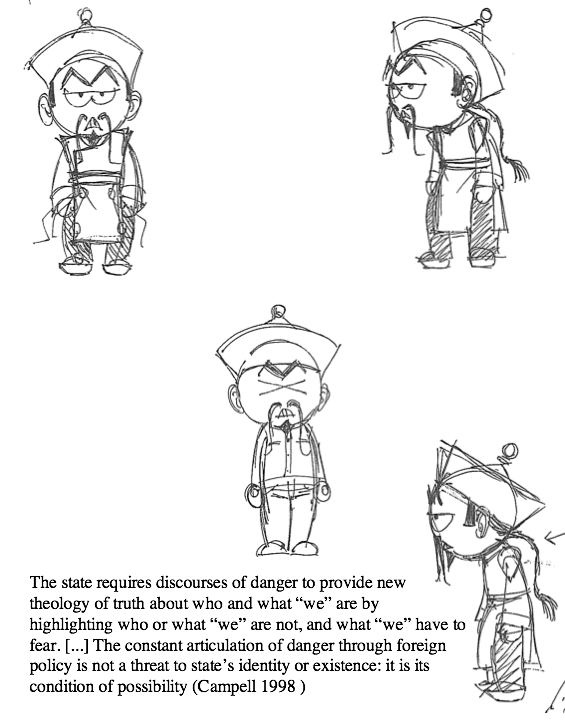
Bitcoin is the leading cryptographic digital currency. Created in 2009 by the now possibly unmasked hacker Satoshi Nakamoto, it polarizes opinion. Some people promote it as the technical embodiment of a libertarian attack on the iniquity of “fiat currency” and the power of the state and big banks, an embodiment of a pure market of value untainted by regulation where everything really is worth only what people will pay for it. Others criticise Bitcoin, often savagely, for the same reasons and for what they perceive as its technical and social failings. But Bitcoin is interesting in ways that go beyond the concerns of its most vocal proponents and detractors.
Rather than paper money backed by gold or electronic money held on a bank’s central mainframe, Bitcoin exists as records of transactions in a public record called the blockchain, which is added to and authenticated by computers on the Internet running the Bitcoin software. Transactions in Bitcoin use cryptographic signatures rather than names or emails as the identities of the sender and receiver. Computers on the network that process and validate groups (or “blocks”) of transactions are asserting the existence of particular pieces of data at the time they are validated, a process rewarded by the production of new Bitcoins. To discourage malicious or false validations, each mining computer must perform a computationally and therefore resource expensive task known as a “proof of work”, which can be checked and confirmed by other computers on the network.
All of this means that Bitcoin is a massively distributed system for asserting identity, existence, and truth, for values of those concepts that are outsourced to a community of mathematical proxies. The blockchain is essentially a time-stamped record of information that anyone can add to in order to prove that a particular piece of data existed at a particular time. This has applications beyond finance, with examples of new systems for blogging, contracts, corporations and Internet Domain Name services all being based on the block chain system. In many ways it is the blockchain and these applications of it that is the most exciting part of Bitcoin.
Money, cryptography (the making and breaking of codes) and alternative currencies all have long and often intertwined histories. Renaissance banks used secret codes to secure messages sent between city-states. Alternative savings or currency systems such as Green Shield Stamps, LETS or Air Miles were all popular at different times in the Twentieth Century. The first cryptographic digital currency was Digicash, from 1990. And Bitcoin isn’t the first multimillion dollar electronic currency. Linden Dollars, the virtual currency used in the Second Life online virtual reality environment, were used in USD567,000,000 of economic activity in 2009. Bitcoin solved the problems that prevented previous digital currencies from becoming decentralised, and although newer digital currencies have improved on its design it is Bitcoin that has captured people’s imagination.
Bitcoin has encouraged a debate about what money is, what money is for, and how money should work, indeed its production, use, and successors have embodied that debate. It’s created a sense of possibility and a range of production comparable to the early World Wide Web. And it’s launched parodies such as the Buttcoin site and the meme-based cryptocurrency DogeCoin, and the epithet “Dunning-Krugerands”. Bitcoin’s mining system rewards existing capital, and its transaction costs reward intermediaries in much the same way as existing banks and credit cards. But these are implementation details, and newer cryptocurrencies and national cryptocurrencies address them. Post financial crisis, cryptocurrency with all its possibilities and contradictions is a lightning rod for the social imagination. And this includes art.
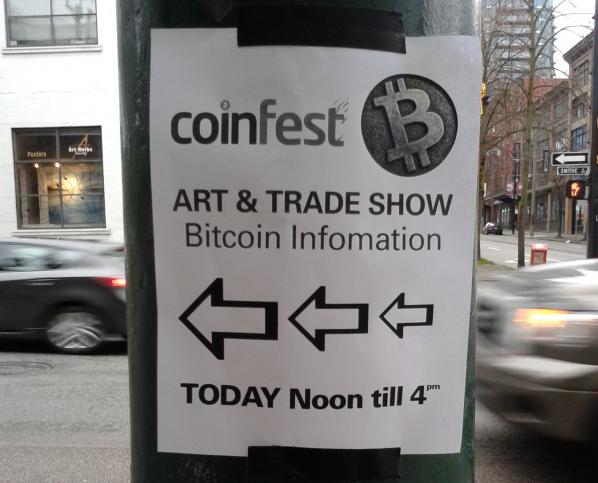
Coinfest 2014 in Vancouver featured examples of artists using Bitcoin. Buskers performing at the event could be tipped in Bitcoins, graffitti and mixed-media art being exhibited could be bought with Bitcoins. And in the computer lab at the venue each desktop PC displayed a piece of net art with a Bitcoin theme. This was the show “Computers and Capital”, curated by Erik H Rzepka and Wesley Yuen, also viewable online at http://x-o-x-o-x.com/press/computersandcapital/. It includes art depicting bitcoins, art visualizing wealth in terms of bitcoins, and work that evokes the operation of Bitcoin-like cryptocurrency.
thereisaprobleminaustralia’s “Bitcoin Garden” is an html5 alife pond populated by shoals of rippled and faded Bitcoin logos. It’s reminiscent of 90s Director alife, and might benefit from more of that algorithmicity. But as a post-internet tumblr assemblage it’s irresistibly calming and ironic. Bitcoin’s promise of a financial artificial paradise rendered organic, or hydraulic models of the economy leaking into the network.
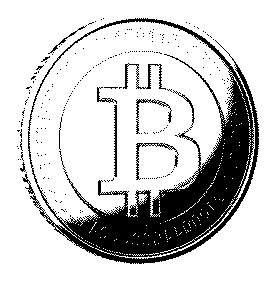
Jon Cates’s “817C01N” is a stark monochrome Floyd–Steinberg dither (an algorithm used on early Macintosh computers to convert colour or greyscale images to binary) animation of a broken iPhone spinning in front of a glitching animation “bitcrushed” from Manuel Fernandez’s “Broken Phone Gradients”. Networked art for a networked currency, it’s a clean, minimalist look afforded by a historical best-of-breed algorithm, an aesthetically and conceptually satisfying digital classicism. And it’s for sale in exchange for Bitcoins.
Ellectra Radikal’s “E.Rad Coin” is a Vasarely-meets-Twister undulating grid of distorted and colour gradient coin shapes. It’s the aesthetic equivalent of Bitcoin’s ethics: the market economic view of society as Conway’s Life with pennies given a post-digital twist.
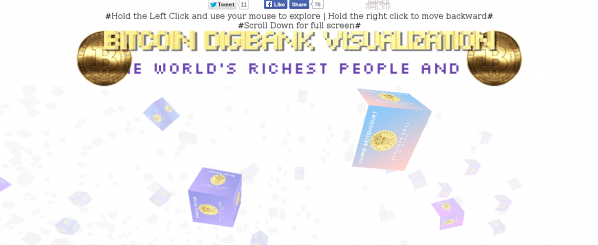
FELT’s “Bitcoin Digibank Visualization” is a financial hyperspace of cubes showing the value of the world’s rich quantified in Bitcoins floating in an endless whiteness. This shows both Bitcoin’s status as a separate economic plane and the ability of existing capital to colonize any resource-based attempt to escape its reach.
Giselle Zatonyl’s “Pop Coinfalls” is a video loop of analogue noise and digital compression glitched falling and stacking coins with a PowerPoint-hell upward graph line animated over them. Blink and you’ll miss it but there are faces on or reflected in the gold of the (Bit)coins as they pile up ever higher. The economy is like that.
Matt Tecson’s “lel buttcoin” is a tumblr blog zoom (an impressive subversion of the vertical scroll bar) of found imagery mostly on the theme of “buttcoins”, a common pejorative for Bitcoins. Coiyes, Bartcoins, and Radeon graphics cards intrude, presumably as they matched the search used to find buttcoin images.
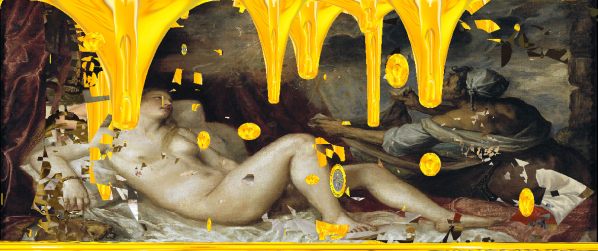
Roger Grandlapin’s “Danaë” is a Flash animation of Bitcoins dripping like honey over animated negative-space text, a porny neoclassical nude of the title and other imagery that I’m not fast enough to make out. Bitcoin’s origin story is related to those of older mythology as a shower of golden rain from Satoshi Nakamoto.
Kutay Cengil’s “Untitled” is a slightly glitched, default material rendered bust of a webcam-foreheaded, PayPal security-badged, melting financial mandarin. This is what Bitcoin is here to save us from, although in a recent interview the CEO of PayPal had more faith in Boitcoin than in NFC.
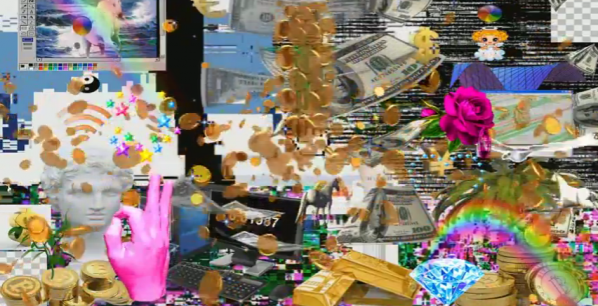
Systaime’s “Bitcoin Abundance” is a highly compressed YouTube video loop of the dross of 90s PC video clips surrounding a rain of bitcoins. It’s the opposite of Jon Cates’ piece. Visual Vaporwave, the kind of transubstantiation of kitsch that art is meant to do. It’s a formally rich composition, amusing and affecting. But even when I remove my cybercultural and net art historical horses from this race I’m left with the problem that it’s not clear how this aesthetic can fail.
Devon Hatto’s “letsnetworth” is another tumblr, this time of animated GIFs of compositions of that symbol of knowledge (and fashionable digital design), the apple. Digitisation, sustenance and symbolism combine here much as they do in Bitcoin. The net wealth of wealth on the net.
Adam Braffman’s “$$ULOGY” is a YouTube video of Dogecoins (the inflationary, Meme-mascoted rival to Bitcoins), Super Mario Bros gameplay, burning dollars and other found video imagery, with a brief visit from MST3K and a cheesy industrial and soft rock soundtrack interleaved with an echoing apocalyptic economic lecture. Its an impressionistic take on cryptocurrency and the environment in which it exists.
Nicolas Koroloff’s “Green Impact” is an image of a pile of Eurocent coins with a single transparent green bead or BB pellet in the middle. This is a reference to Bitcoin’s of-touted environmental impact due to the electricity expended in mining. The comparison between this energy footprint and that of fiat currency ATMs, chip and pin readers, and other elements of the global banking system probably compares to the relationship depicted here.
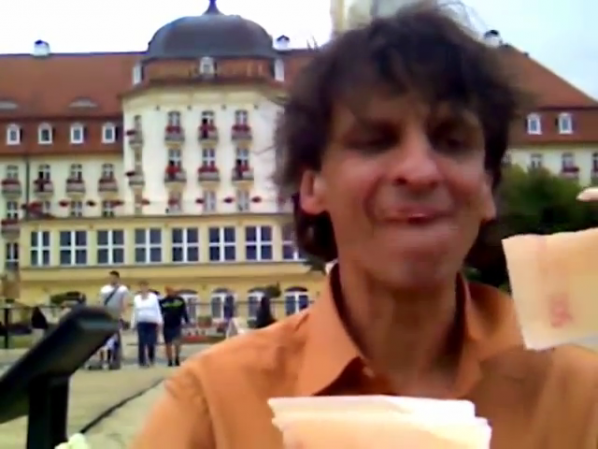
Dominik Podsiadly’s “I’ll eat any amount of EU subsidies” is a video performance of the artist smoking, drinking, and doing just that with some large edible 500 Euro notes. The Euro is a political instrument as much as a financial one, and its crisis has been another factor driving interest in alternative currencies, including Bitcoin.
Chimerik’s “Chimerikcoin” is a packed square graph puzzle that rearranges itself to fit as you drag rectangular fragments of an old gold coin around to reveal brief peaks of paper money. It’s the economy as a zero-sum game and Bitcoin as a digital return to the gold standard.
Miyö Van Stenis’s “Bitcoin Dreams” is an interactive html5 animation of settling Bitcoins in front of a cloudy sky and animated curtain. It’s an unusual and effective combination of tightly looped animation and interaction with a vaporwave aesthetic.
ASS Rain’s “Trees” is a collage of translucent green blocks dropped spillikins-style. I found it aesthetically and conceptually opaque, although a very effective composition.
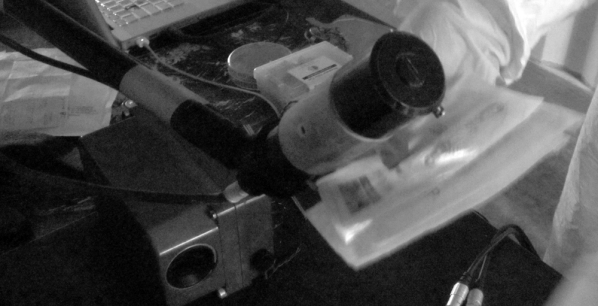
Robert B. Lisek’s “Quantum Enigma” uses a geiger counter to generate an encryption key for communication, ironically realising the promise of quantum crytography. It’s a historically and technically literate project that communicates a strong political stance while remaining technically and aesthetically interesting.
The ability to curate such a show online and present it as part of a wider cultural event marks a moment where the widespread availability of Internet access, Web 2.0 publication platforms, and computer labs at event and community spaces has transformed the possibilities for curating and contextualising digital art. “Computers and Capital” exploits these affordances very effectively. The recurrent themes, of pennies from heaven, ironic digital kitsch, glitchy compression artefacts, and potlatch, feel both appropriate and effective in visually communicating and critiquing the technical and social complexities of cryptocurrency in the age of austerity.
Bitcoin has caught the attention of the public, government, criminals, and artists. It is both an expression of the economic imaginary and a genuinely novel means of networked communication. This makes an unusual subject for art, whether celebratory or critical. Even the most ironic celebrations of Bitcoin in art are depictions of a network protocol, or a deflationary electronic currency. Whether visually and conceptually preparing us for a brave new world of cryptocurrencies or creating the illusory realm in which they will achieve their only lasting victory, Bitcoin art is very different from a Warhol dollar sign, a Hirst diamond skull, or the other symbolic band-aids for the ideological aporia of capital’s hollow victory. It is the art of a heresy rather than a hegemony, of a moment of technological, social and aesthetic possibility.
“Computers and Capital” very successfully captures this moment in art and makes it accessible in ways that thousands of words on the subject cannot. A thought-provoking, illuminating and often fun collection of work of a uniformly high standard that is nonetheless technically and aesthetically diverse can be presented online and off as part of a wider cultural event. “Computers and Capital” shows how network-enabled digital art can function as a bridge between complex and important ideas and the public imagination.
The text of this review is licenced under the Creative Commons BY-SA 4.0 Licence.
On 29 March it’s going to be Arduino Day 2014!
Furtherfield and Codasign will be hosting a day full of free activities at Furtherfield Commons in Finsbury Park. We would like to invite anyone interested in physical computing – people from all ages and all levels of expertise – to come and spend the day with us.
The day will consist of a series of FREE Arduino taster workshops for absolute beginners in the morning and a showcase of interesting interactive Arduino projects by artists, techies and enthusiasts in the afternoon. To participate in the workshops or to show your work, please see details below.
WORKSHOPS
10:00 – 11:00 Intro workshop for children (9-12 years old)
11:30 – 12:30 Intro workshop for young people (13-18 years old)
13:00 – 14:00 Intro workshop for adults
14.30 – 17:00 SHOWCASE
The workshops with give you a taster of how to work with Arduino, teaching you how to write your very first ‘sketch’ as well as how to build circuits on breadboards. We will work with components such as LEDs, potentiometers, Piezos and more! For the kids workshop we’ll combine Arduino with Scratch to show children how these two platforms can communicate with each other. For the workshops for young people and adults we will purely be using the Arduino environment, but will also be demonstrating how you can use it on your Raspberry Pi! All workshops are FREE. For more details about the workshops and how to sign up, please visit the Codasign webpage.
If you have an Arduino project you would like to show and discuss, we would like to invite you to participate in our Arduino Showcase. This is an opportunity to share your work and hear about what others are doing, to meet people, to be inspired, and, mainly, to have a good time. If this sounds like something you would like to do, please fill in this form. We aim for this to be a friendly and informal event, where visitors can wander around, get ideas, ask questions and play with the projects being showcased. We will provide power, Internet, and a table, and of course, there will be drinks.
If you have any questions or would like to discuss any details with us, please get in touch with Olga, olga@furtherfield.org.
Furtherfield Commons
Finsbury Park
Near Finsbury Gate On Seven Sisters Road
E: info@furtherfield.org
Furtherfield Gallery is supported by Haringey Council and Arts Council England.
‘RE / PRE / SENT / PAST’, an exhibition featuring works by media artist Markus Soukup as part of Furtherfield Clear Spots programme, explores different phenomena from dreamscapes to long distance travel recordings, as well as attempted considerations of societal change in relation to technological developments.
It brings together fragments of subjective experiences related to contemporary everyday existence, which were translated and transformed into ‘perceivable outputs’ by using different digital techniques. The screen or the physical object as output constitutes an interface, where perceptual experiences of the spectator intermix with the intentions of expression.
The wonders of perception are connected to imagination processes and a continuous stream of individual interpretation that play with the question of what defines objective reality.
Markus Soukup is a media, video and sound artist living and working in London since 2012.
In general he considers the process of making work as an exploration of how an object, image or moving image can communicate its intended content or expression by still enabling freedom of interpretation on realistic and abstract levels.
He is fascinated by the infinity of possibilities and starting points, which the work with moving images provides. Since the end of the 90s he produces videos, 2D and 3D animations investigating the narrative, expressive, poetic and aesthetic potentials of this time-based medium.
A series to be continued investigates language and its structure by de-constructing content or flow, breaking it into parts and reconstructing it on a time based level. Other areas of his work incorporate digital photography and typography, graphic and interactive design, field recordings and electronic music.
His work has been shown in local, national and international exhibitions and festivals, for instance at the 11th international Media Art Biennale WRO 05 (Wroclaw, Poland, 2005), NEXT UP at the Bluecoat Liverpool (2008), the 10th Seoul International New Media Festival (Republic of Korea, 2010) and the Liverpool Biennial 2010.
In 2011 he was awarded the Liverpool Art Prize. As a result his work was shown in the ‘Elements & Satellites’ exhibition at the Walker Art Gallery, part of National Museums Liverpool in 2012.
In 2013 he was commissioned by Metal Culture to produce the video installation Strata for the ‘STILL, conflict, conservation & contemplation’ exhibition curated by Simon Poulter at City Gallery Peterborough.
Recent exhibitions include Infinite Separation, part of ‘Art:Language:Location’ at Anglia Ruskin Gallery Cambridge, and Disjointed at Museum Ex Teresa Arte Actual in Mexico City.
+ More information:
www.toofastproductions.co.uk
Furtherfield Gallery
McKenzie Pavilion, Finsbury Park
London N4 2NQ
T: +44 (0)20 8802 2827
E: info@furtherfield.org
Furtherfield Gallery is supported by Haringey Council and Arts Council England.
Featured image: Mari Velonaki, “The Woman and The Snowman”. Responsive installation incorporating autokinetic robotic sculpture (2013).
I first met Mari Velonaki in person a couple of years ago and since then have attended one of her lectures. I was impressed by her work as a cross-disciplinary arts-led researcher. Also, her imaginative approach in her art practice which spans across interactive installations, robotics and kinetic sculpture and human-robot interaction. This interview is an opportunity for readers to find out more about the ideas and the contexts behind her work, including plans, dreams and also what is happening in Sydney Australia, where she is based.
Eva Kekou: I am fascinated by the project Fish-Bird, it operates as a metaphor for me to connect and relate two different notions in the most poetic way as in the case of art, science and technology. Could you please give us some information about the idea of this project and both its artistic and research views – also how audiences responded to this.
Mari Velonaki: “Fish-Bird” is an interactive autokinetic artwork that investigates the dialogical possibilities between two robots, in the form of wheelchairs, that can communicate with each other and with their audience through the modalities of movement and written text. The chairs write intimate letters on the floor, impersonating two characters (Fish and Bird) who fall in love but cannot be together due to “technical” difficulties. This was an interdisciplinary project that involved the creation of novel interfaces for human-robot interaction, experimentation in distributed sensory systems and robot ‘perception’.
The wheelchair was chosen as the dominant object of the installation for several reasons. A wheelchair is the ultimate kinetic object, since it self-subverts its role as a static object by having wheels. At the same time, a wheelchair is an object that suggests interaction – movement of the wheelchair needs either the effort of the person who sits in it, or of the one who assists by pushing it. A wheelchair inevitably suggests the presence or the absence of a person.
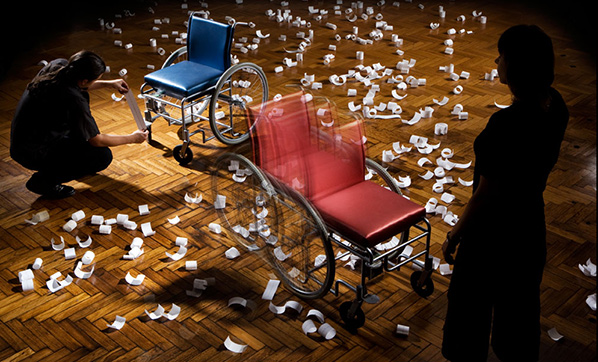
Furthermore, the wheelchair was chosen because of its relationship to the human – it is designed to almost perfectly frame and support the human body, to assist its user to achieve physical tasks that they may otherwise be unable to perform. In a similar manner, the Fish-Bird project utilizes the wheelchairs as vehicles for communication between the two characters (Fish and Bird) and their visitors. Finally, the wheelchair also possesses an aesthetic that is very different from the popular idea of a robot, as it is neither anthropomorphic nor “cute”. Given that a wheelchair is a socially charged object, the interactive behaviour and the scripting of how the chair should move was developed in consultation with wheelchair users. The participants are actively discouraged from sitting on the wheelchairs: if a participant sits on a wheelchair a sensor embedded in the seat upholstery pauses the entire system until the participant vacates the wheelchair.
What we’ve learned from the Fish-Bird project in relation to human-robot interaction, after 35,000 recorded encounters in five countries, is that behaviour is more important than appearance. Although Fish and Bird have the utilitarian appearance of an assistive device, participants were drawn to them because of the way they move and interact physically with them, and because of the handwritten style ‘personal’ messages that they print for their audience.
EK: Your project Diamandini brings up issues of femininity, interactivity into the context of computer and informatics. It again works as a nice metaphor but in practice it is a research project between the Centre for Social Robotics, Australian Centre for Field Robotics, the University of Sydney and yourself. Can you give us more information about this and also report to us about the outcome of the research project about the understanding of the physicality that is possible and acceptable between a human and a robot within a social space.
MV: The original intent of the Diamandini project was to create a robot that was non-representational and non-anthropomorphic – also, I wanted to work with the concept of one-to-one interaction: one human, one kinetic agent. As I started experimenting with a variety of abstract sculptural forms, although interesting in shape and structure, I found it extremely difficult to assign behaviours to them that could lead to emotional activation of the spectator/participant. These considerations influenced my decision to create a humanoid robot. This was a challenging decision, especially when I had to decide how the robot should look. I didn’t want Diamandini to have a typical humanoid robot aesthetic. I began to think of Diamandini as a female sculpture. In my mind Diamandini had a diachronic face that spans between centuries, a style that could be reminiscent of post-World War II fashion influences, and at the same time with futuristic undertones. Diamandini is small – only 155 cm high. I wanted her figure to be small and slender so that people didn’t feel threatened by her when she ‘floats’ in the installation space. I wanted her to look youthful, but not like a child, and for her age not to be easily identifiable. Interestingly, in my mind she is between 20 to 35 years old. Because I am a woman, I feel more comfortable working with a female rather than a male representation.
In relation to people interacting with Diamandini in social spaces, we are still processing data collected from 3,682 interactions at the Victoria & Albert Museum in 2012. From these interactions what we know so far is that, although people would spend – on average – more than five minutes with her in the Medieval and Renaissance Galley, only 88 people embraced her or held her hand. It will be interesting to compare this result with new data coming from Diamandini’s current exhibition at FACT, Liverpool, where she is exhibited in a contemporary gallery setting.
EK: You are an artist and researcher. How do you think that these two relate to each other, give feedback to each other and can give a mutual input to your work? How connected are art and research in general?
MV: I see my work as practice-led research. I’m interested in developing and testing new concepts of what an artwork can be, in the same way as I’m having conceptual and aesthetic concerns of what a robot can be. Interactive media art has a long history of looking at sharing spaces with projected and kinetic characters. I’m interested in the brief moment when a spectator becomes a participant – conceptually and physically. This is where the core of my research lies.
EK: The female character and femininity plays a crucial role in your work. How can “fragile femininity” be embraced by science and technology and its connected artwork under the light of media art?
MV: I don’t perceive my work as fragile femininity – at least consciously. Many of my characters don’t have gender: for example Fish-Bird, Fragile Balances, Current State of Affairs. If a representation of gender is necessary – as in previous works that contain projected digital characters (Pin Cushion, Unstill Life, etc.) or is a humanoid robot – I choose to work with female forms as I am more comfortable to sculpt, script and create a kinetic language for a female representation. The element of fragility, though, is a thread that links many of my works. Anne-Marie Duguet wrote a wonderful essay “The Power of Vulnerability” about my work ‘Fragile Balances’ (2008) in which she writes “’A fragile balance’ could define all complex interactive processes that involve human intervention. Interactivity always extends to the limits of more than one language, more than one reality. It relies on operations of interpretation and coding that, as a matter of course, produce slips of meaning, simplifications and omissions which can undermine the effectiveness and reciprocity of exchange, and hinder the pleasure of transgression.”

EK: I know you have exhibited in different parts of the world – how do audiences respond to your work?
MV: I guess it depends on the work. In general I think maybe I could add that I think people are attracted to my work because – although it partially depends on complex technological systems – the work itself doesn’t look at all technological. I want to believe that my audiences are attracted to my ‘characters’ maybe because of the element of surprise: a porcelain-like sculpture that moves; wheelchairs that write love letters; wooden cubes that act as embodied avatars for robotic characters.
EK: What are your next steps as an academic, artist and researcher? Which of your dreams do you want to make true through your work (relating them to art, science and technology as another metaphor)?
MV: At the moment a lot of my focus is on growing and strengthening the Creative Robotics Lab (CRL) at NIEA. I founded CRL with an aspiration to build a cross-disciplinary experimental space for human-robot interaction research and interface design. At CRL people from different disciplines – arts, robotics, psychology, philosophy – work together because they believe that, to improve human-robot interaction, a cross-disciplinarily approach is not complementary but essential. CRL for me is a safe place for risk-taking.
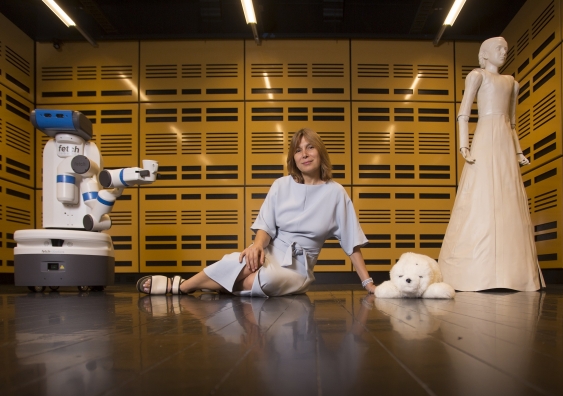
Mari Velonaki has worked as an artist and researcher in the field of interactive installation art since 1997. Mari has created interactive installations that incorporate movement, speech, touch, breath, electrostatic charge, artificial vision and robotics. In 2003 Mari’s practice expanded to robotics, when she initiated and led a major Australian Research Council art/science research project ‘Fish–Bird’ (2004-2007) in collaboration with roboticists at the Australian Centre for Field Robotics (ACFR). In 2006 she co- founded, with David Rye, the Centre for Social Robotics at ACFR, a centre dedicated to inter-disciplinary research into human-robot interaction in spaces that incorporate the general public. In 2007 Mari was awarded an Australia Council for the Arts Visual Arts Fellowship. In 2009 she was awarded an Australia Research Council Fellowship (2009–2013) for the creation of a new robotic form. In 2011 she was appointed as an Associate Professor at the National Institute of Experimental Arts (NIEA) at the College of Fine Arts, The University of New South Wales, where in 2013 she founded the Creative Robotics Lab. Mari’s artworks have been widely exhibited internationally. http://mvstudio.org/
Tatiana Bazzichelli is a researcher, networker and curator, working in the field of hacktivism and net culture. She is part of the transmediale festival team in Berlin, where she develops the reSource for transmedial culture, an ongoing distributed project of networking and research within the transmediale festival. She received a Ph.D. in Information and Media Studies from Aarhus University (DK), conducting research on disruptive art practices in the business of social media (title: Networked Disruption: Rethinking Oppositions in Art, Hacktivism and the Business of Social Networking). Bazzichelli is also a Postdoc Researcher at the Centre for Digital Cultures /Leuphana University of Lüneburg (DE).
In light of absolute domination by market forces over all of our lives, and with the top-down orientated power systems’ bias towards business and the implementation of a consumer class. New ways of thinking around the problem is called for. There has been a dramatic shift of unethical companies such as BP funding art’s and technology projects, and mainstream museums and galleries in the UK. [1] Alongside this, those hoping to receive arts funding are told to be innovative and more entrepreneurial than they already are. What they really mean by ‘innovative and entrepreneurial’ is, get in line with the values of a corporate mentality, and not be contextual or critical in one’s art practice. This wholesale move towards business as it further dominates the content, ideas, societal context, and missions by artists and art collectives – is of deep concern for all who wish to explore freedoms of expression on their own terms and not inline with the state’s or a corporation’s set of diverting agendas.
Art activism in media art and transdiscilpnary arts culture has engaged with political and societal issues while under the gaze of neoliberalism quite successfully. However, what changes have occured that we can draw upon to say we have built real alternative values for others to work with? There are plenty of people from the dark side calling us to join them, like that eirie voice from the original Evil Dead movie.

I’m reminded of Thomas Frank’s insightful words in his article TED talks are lying to you, that those who urge us to “think different” almost never do so themselves. [2] And this is the nub, what will become us if we step over into their world and adapt our minds to their visions?
“To expect or even wish those who rule and those serving them to change, and challenge their own behaviours and seriously critique their own actions is as likely as winning the National Lottery, perhaps even less.” [3] (Garrett 2013)
So, this brings us Tatiana Bazzichelli who has been thinking about this stuff a lot. Her Proposition is that we need climb out of these oppositional loops in order to find different ways of being, and refocus on potential art strategies in relation to a broken economy. In her publication Networked Disruption: Rethinking Oppositions in Art, Hacktivism and the Business of Social Networking, Bazzichelli puts forward the notion of disruptive business and it “becomes a means for describing immanent practices of hackers, artists, networkers and entrepreneurs”, and sheds “light on two different but related critical scenes: that of Californian tech culture and that of European net culture – with a specific focus on their multiple approaches towards business and political antagonism.”
Marc Garrett: In your book you examine a breadth of disruptive practices of networked art and hacking culture in California and Europe. You propose your main objective is to rethink the meaning of critical practices in art, hacktivism and social networking, analyzing them through business instead of being in opposition to it.
Could you explain how this would change situations and what it would bring to artists exploring disruption as part of their practice, networked art culture and the wider community, and what this may look like?
Tatiana Bazzichelli: I will begin answering your question by adding another one: Why do we need to rethink artistic and hacktivist oppositions in the context of social media and after the emergence of Web 2.0? This question is at the core of my book, and also the main link that connects together my previous book, Networking: The Net as Artwork (2006), and the following ones centered on the concept of networked disruption and disrupting business.
The idea of conscious participation in media practices is central to analyse the evolution and transformation of the concept of “networking” in the age of social media. My reflections are the consequence of a process of direct involvement within the activist (or rather “artivist”) scene in Italy since the mid-90s, and furthermore, they are based on the analysis of a more international fieldwork of practices between the Europen tradition of netculture, and the development of cyberculture in California. Practically all my books are to be thought of as subjective, and as consequences of a personal experience which aims to create connections between very diverse fields of action, applying the idea of networking both in theory and practice, and as a methodology of writing.
Between the end of the 1990s and the early 2000s, many actions of media criticism were often very dialectical, and rooted on the idea of antagonism as radical opposition. I am for example thinking about what was (erroneously) called “the anti-globalization movement”, the protests in Seattle, Prague, Goteborg, Genoa, etc.: somehow it was easier to identify an “enemy”, for everyone to unite against the same power. Unfortunately this also meant that it was easier to identify the members of the movement(s) themselves, and many protests faced violent chains of repression by the authorities. In particular in Genoa, the Italian movement and its global counterparts were hit hard. My personal opinion is that the frontal opposition, the idea of assaulting the “red zone” during the protests, did not work at all: we basically played the game of the police. Without dismissing this experience, which was very important in itself and for the start of new activist projects, after Genoa 2001 I started searching for a new way of activism that was not black and white, and which would be harder to appropriate. This was also the reason why I started entering in contact with many projects in the queer, pink, and independent porn culture, which were combining ludic strategies and playful disruption beyond oppositional confrontation. I was trying to connect those to the concept of hacking – mixing the codes to create disturbance, to generate subliminal interventions, to give rise to paradoxes, fakes and pranks, as previous projects based on multiple identities, from Luther Blissett to Neoism and Monty Cantsin, had done before.
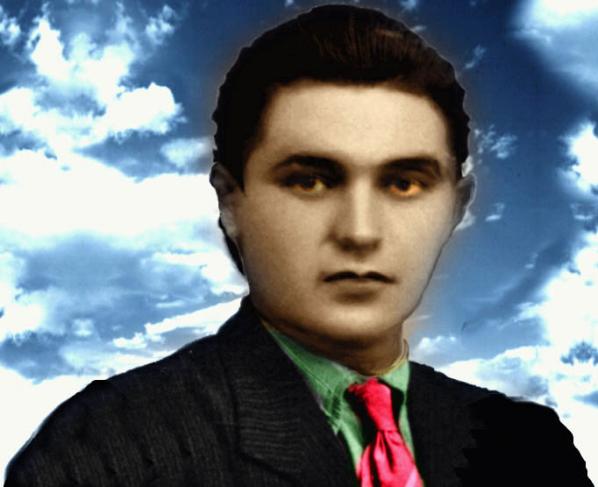
“In 1994, hundreds of European artists, activists and pranksters adopted and shared the same identity. They all called themselves Luther Blissett and set to raising hell in the cultural industry. It was a five year plan. They worked together to tell the world a great story, create a legend, give birth to a new kind of folk hero.” Luther Blissett.
But after 2004, which is also the time of the emergence of Web 2.0, the critical framework of art and hacktivism shifted: networking, a concept which had informed the Avant-garde since the 1960s, became a tool for a wider audience, and a pervasive business strategy. The ideas of openness, do it yourself, sharing, the “mottos” of the hacker culture in the 1990s, became the main rhetoric of the Web 2.0 companies based on the appropriation of “free culture”. This meant to me that also artistic and hacker practices needed to be recontextualised, since the concept of social networking became something completely different from its roots, and the business companies themselves were applying the concept of disruption as main business logic. Is it possible to oppose disruption with disruption?
In the era of immaterial economy and increasing flexibility, the act of responding with radical opposition no longer looks like an effective practice, since the risk is to simply feed the same machine replicating the capitalistic logic of competitiveness and power conflicts. In my opinion, and here I speak through my “artivist” experience, even the concept of the multitude as a model of resistance against the capitalist system – which runs at a theoretical level – is difficult to apply on a pragmatic level without having to recreate the traditional dynamics of the “power-contra power” conflict. The point is to try to figure out how to imagine new forms of participation that go beyond dualistic conflict – and that go beyond the creation of a hegemonic and holistic entity, although presented as a plural (the multitude, indeed). As a result, it is definitely necessary to reformulate the language, which enters the sphere of production and the political, as Paolo Virno states, but most of all, activists practices and critical strategies need to be rethought.
What my book Networked Disruption suggests is the act of performing within the capitalist framework, not against it, keeping the dialectic open through coexisting oppositions. The notion of disruptive business is useful for reflecting on different modalities of generating criticism, shedding light on contradictions and ambiguities both in capitalistic logics and in artistic and hacktivist strategies, while rethinking oppositional practices in the context of social networking. In this book the concept of the Art of Disrupting Business must be interpreted beyond categorical definitions, and as a new input for imagination. “Disruption” implies a multi-angled perspective and it is a two-way process, where business and the antagonism of business intertwine. Adopting a hacker’s strategy, hacktivists and artists take up the challenge of understanding how capitalism works, transforming it into a context for intervention and trying to alter business logics. Rethinking strategies and modalities of opposition implies that new forms of interventions and political awareness should be proposed without antagonising them, but rather by playing with them and disrupting them from the inside of the machine. The vision of a distributed network of practices, participations and relationships can only be fragmented, and based on multiple layers of imagination.
Today there are artists and activists who are inspired by a certain tradition of “disruption”, creating interventions from within, critically appropriating the business logics, stretching its limits, or proposing alternative models to it. Many of them are the case studies of my book, where I propose a constellation of social networking projects that challenge the notion of power and hegemony, and where social networking is not only technologically determined. Projects and experiences such as mail art, Neoism, The Church of the SubGenius, Luther Blissett, Anonymous, Anna Adamolo, Les Liens Invisibles, the Telekommunisten collective, The San Francisco Suicide Club, The Cacophony Society, the early Burning Man Festival, the NoiseBridge hackerspace, and many others. Of course there are many more of these. Holes in the system are everywhere, ready to be performed and disrupted.
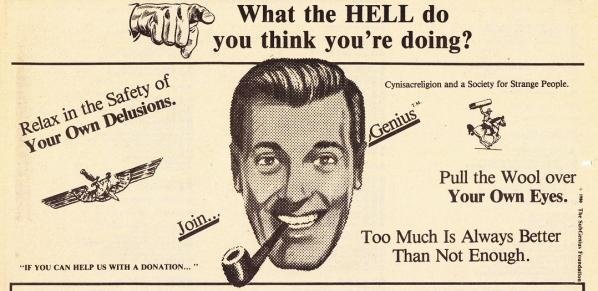
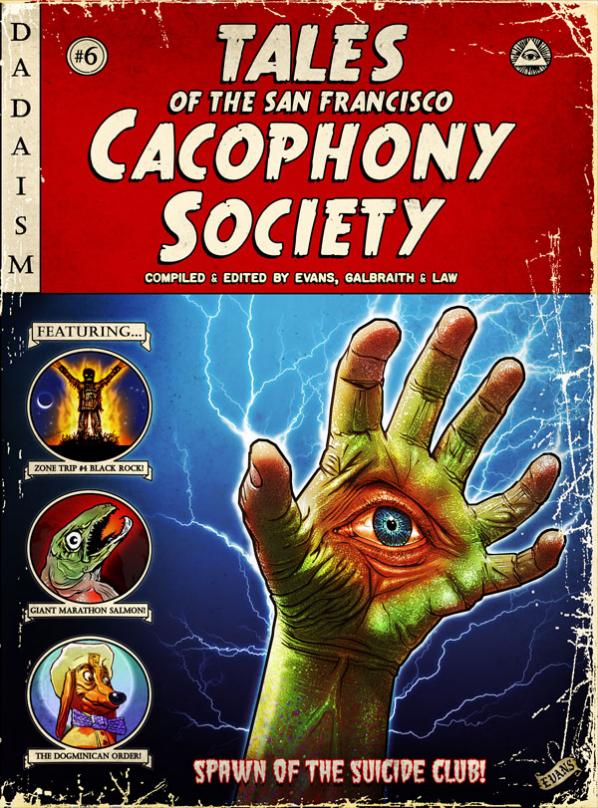
MG: There is a quote in the book that it says, “Innovation is rooted in Desire, not need. Desire is the motivation for behaviour. Desire leads to goals, and goals lead to motivation, the internal condition that gives rise to what we want to do, based on our goals, what can we do – based on the norms of behaviour – and what we will do – the actions that we voluntarily decide to undertake. Motivation is the ethos of goal-oriented behaviour, and a company’s ability to understand motivation directly contributes to the success of their products and services in the marketplace” (Manu, 2010, p. 3).
I’m wondering, coming from an activist background myself where do you think free culture fits into this dialogue, especially in respect as a critique of products and services in the marketplace, as well as social forms of emancipation?
TB: The quote you are referring to comes from a book entitled Disrupting Business: Desire, Innovation and the Re-design of Business (Alexander Manu, 2010). As we can read in the business literature, the concept of disruptive business is rooted in the idea of disruptive innovation. Disruptive innovation, a term coined in 1997 by Clayton Christensen, Professor at the Harvard Business School, is used in business contexts to describe innovations that introduces a product or service in ways that the market does not expect. In the business culture, disruption not only means rupture, but links to the idea of innovation and re-design of behavioural tendencies. Therefore performing disruption shows a process that interferes with business, whilst at the same time generating new forms of business. This mutual feedback loop is at the core of my analysis.
However in my book business is neither analysed through classical business school methodologies, nor seen as positive or negative, but it is a means for working consciously on political practices – and for raising questions on art and media criticism. In 2009 I was a visiting scholar at Stanford University where I was researching the reasons of the progressive commercialisation of networking contexts after the emergence of Web 2.0, through the development of hacker culture in the Silicon Valley. From the interviews that I conducted, and also via the close reading of the book From Counterculture to Cyberculture by Fred Turner, it was evident that since the development of the early cyberculture hackers and members of the so-called “counterculture” have been trying to disrupt business via their practices, and in parallel, business corporations have been trying to do the same through technological innovation. Since the 1960´s, hackers and artists in California have been active agents in business innovation while at the same time also undermining business. This is also very evident today in the business context of Web 2.0 where many hackers are working at the core of business, while disrupting it – the Anonymous entity is one of the most successful examples of this.
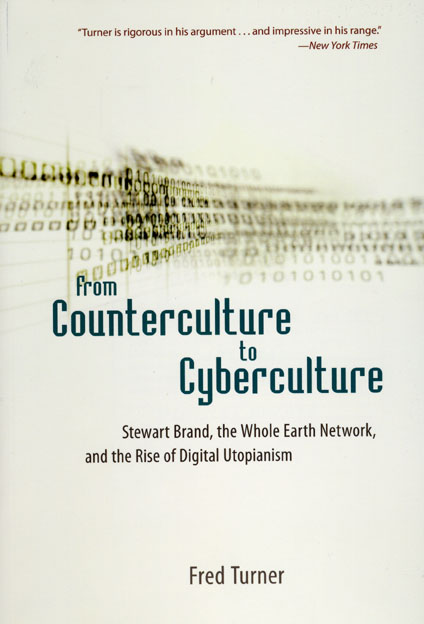
In my book I compare what the concept of business disruption meant in the European context and in the US, especially in Silicon Valley. When I was interviewing computer engineer Lee Felsenstein he told me that in California hackers would refuse hegemony but not business. This is also why many of them have no problem in working for Google, which is actually employing the best hackers of the area. In Italy we always claimed that hacking is politics, and politics is an “attitude”, which informs your everyday life and lifestyle. What I discovered in the Silicon Valley is that libertarian practices are often linked with the refusal of the political, and this is the position of many members of the hacker culture in California. Therefore, what for me was the initial “problem”, the contamination of business and free culture, was not considered as such among the hackers that I met between San Francisco and Palo Alto.

This consideration leads me to create a model of analysis named the “disruptive feedback loop”, based on the idea of layering instead of cooptation – such an idea of “layering” rather than cooptation, was proposed by Fred Turner in the lecture “The Bohemian Factory: Burning Man, Google and the Countercultural Ethos of New Media Manufacturing” (2009), while discussing the social phenomenon of Burning Man. The idea of the “mutual feedback loop” between business and hacker culture is instead the result of a conversation in 2009 with Jacob Appelbaum, who at the time was an active member of NoiseBridge in San Francisco, when we were reflecting on the development of hacker spaces in California. In my disruptive loop model, artists and hackers use disruptive techniques of networking in the framework of social media and web-based services to generate new modalities for using technology, which, in some cases, are unpredictable and critical; business enterprises apply disruption as a form of innovation to create new markets and network values, which are also often unpredictable. Networked disruption is a place where the oppositions coexist, and it is a reconfiguration of practices into a structure of mutual feedback instead of opposition.
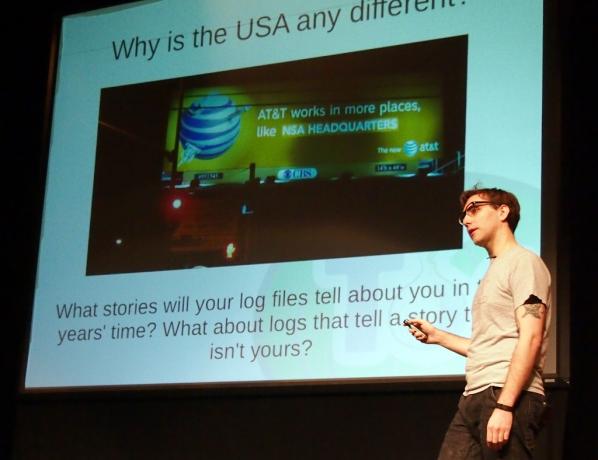
Here I propose disrupting business as an art practice: artists and hackers adopt viral and flexible strategies, as does contemporary networking business, and by provoking contradictions, paradoxes and incongruities, business logic is détourned. This model can be applied both in the analysis of business contexts of social networking and of critical practices generated by hackers and artists. For example, projects such as Anna Adamolo and Seppukoo reflect on the tensions between the open and closed nature of social media, stressing the limits of Facebook’s platform, and working on unpredictable consequences generated by a disruptive use of it. Paradoxically, to be critical of business we should learn from it.
The Telekommunisten collective explains this well, and it is not a coincidence that Dmytri Kleiner comes from a Neoist background: the experiences of Luther Blissett and Neoism made it hard to see any “truth”, they forced us to question and examine our identities. If you claim to have the truth, you will fail – someone else will proclaim the truth, and perhaps with much more strength and power than you. The Miscommunication Technologies by the Telekommunisten show that the enemy can eat you up and that the capitalist system has endlessly more resources to force its “truth” on you. We have to learn from business, understand how to be pervasive. My point is that we should stop looking for the enemy, because who is the enemy today when disruption and its opposition are feeding the same machine? The challenge is to unite where the system can’t get you, and you’re not playing into its hands, exposing contradictions, generating disturbance, to disrupt and perform the feedback loop at once. The challenge facing the art of disruptive business is to dissipate oppositions through a network of multiple, distributed, playful and disruptive practices.
MG: It was licensed under a peer Production License (http://p2pfoundation.net/Copyfarleft), similar to a Copyfarleft License (http://p2pfoundation.net/Peer_Production_License). Very different than a Creative Commons Licence, and drawn up by one of the artists you write about in the book Dmytri Kleiner. It feels relevant to be on the P2P Foundation wiki, however it would be useful know how it relates to the context of your publication?
TB: As it is stated on the P2P Foundation website, based on the text published in The Telekommunist Manifesto, “the Peer Production License is an example of the Copyfarleft type of license, in which only other commoners, cooperatives and nonprofits can share and re-use the material, but not commercial entities intent on making profit through the commons without explicit reciprocity”. The Peer Production License is a hack of the Creative Commons licenses. Where the Creative Commons is mostly used for sharing works non-commercially, the Peer Production License wants to contribute in expanding a non-capitalist economy, generating earnings that are shared equally. Commercial use is therefore encouraged for independent and collective/common-based users only, proposing a business logic that does not lead to a private appropriation of community-created value.
This logic is also at the core of the “Venture Communism” concept coined by Dmytri Kleiner in 2001, which proposes to allocate equally the collectively owned material wealth, and to create a peer-to-peer social commons as an alternative to venture capitalism.
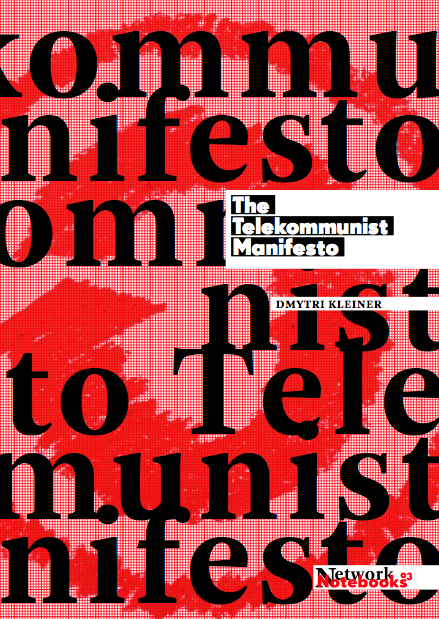
I decided to release the Networked Disruption book under this license because I consider it a coherent intellectual gesture, and also a “business experiment”. From what Dmytri told me this is the first book released under this license after the Telekommunist Manifesto, and hopefully the use of such license, if increased, will be part of poking a small hole in the capitalist economy, generating value which is not going into few owners’ pockets, but is shared equally among the workers and producers. This is also the reason why all my publications exist both online and on paper and are freely downloadable from the web, because it would be contradictory to write about certain topics and then release my toughts under proprietary licenses. In this case, since the book is about disrupting business, I decided to apply a disrupting business license, and to my point of view this is what the Peer Production License is.
Conclusion:
Bazzichelli’s investigation is a timely and necessary critique on how to free up networked forms of freedom of expression and its varied practice. At first, I was suspicious. Indeed, in a later publication on the subject co-edited by Tatiana Bazzichelli & Geoff Cox, called Disrupting Business: Art and Activism in Times of Financial Crisis; “Bifo” Berardi, in his article EMPTINESS says “Business is, in my opinion, the most despicable word in the vocabulary. Well, I will try to express it better: the meaning and implications of the word ‘business’ in contemporary culture and daily life, and the positive emphasis placed on this term, are the most telling symptoms of the abysmal alienation of our time.” On this I agree.
We are all emersed in the sea of neoliberalism and we are struggling to keep our heads above the water at various levels. Some are aware of it and are not dealing with it, most are unconscious of it and are drowning in it, and then there are those actively awake and exploring different and innovative ways to survive and hack ‘around, in between and through’ this deep totalising ocean.
Whether we like it or not, business unfortunately is the dominating regime controlling our interactions, and this includes our cultural, digital interfaces and social contexts. Bazzichelli asks us to stare into the monster’s face – what Bifo sees as a deep emptiness. She pulls out of the slimey depths a glimmer of hope and an advancement for playful and critically aware forms of artistic disruption. It is an academic and cultural hack and reminds me of Donna Haraway’s proposition in the mid 90s for Situated Knowledges. Haraway realised with other collaborators that it was a fantasy to think that the patriarch was going to somehow willingly hand over control and be enlightened to the idea that women scientists should be accepted as equal in history and academia.
“We seek not the knowledges ruled by phallogocentrism (nostalgia for the presence of the one true world) and disembodied vision. We seek those ruled by partial sight and limited voice – not partiality for its own sake but, rather, for the sake of the connections and the unexpected openings situated knowledges make possible. Situated knowledges are about communities, not isolated individuals.” [4] (Haraway 1996)
Her proposition is not suggesting that critical, ethical artists and pranksters give up and put down their tools and become business men and women instead. Using terms such as ‘disrupting business’ is not conforming or giving up the fight. It is a shift in strategy. She has successfully illustrated that there is a continual rise in imaginative experimentation where artistic hacking with the protocols, interfaces, code, data and surveillance is alive and well. It is about infiltration of these ideological defaults and the power systems that rely on them. Resistance is not futile, it is just changing direction from reliance for absolute desire (which lets face it is rarely fullfilled) from momentary tactics and momentary hacks, into informed hacking with socially aware and engaged strategies. She is asking for an intelligent response, a less macho way in dealing with the problem. This means building deeper relations with others through affinities and sharing critical knowledges while disrupting the business of neoliberalism. And most of all, carry on playing…
Featured image: Cardboard Soldier, 2009 exhibition T-Space Gallery Beijing. Joseph DeLappe.
Joseph DeLappe’s art projects have received much interest ranging from the art world, New York Times, Wired magazine, and publications such as Joystick Soldiers The Politics of Play in Military Video Games, the first anthology to examine the reciprocal relationship between militarism and video games. DeLappe is considered a pioneer of online gaming performance art. His art examines the conditions and processes of cultural information to provoke and critique the state of military influences on everyday culture and people’s lives.
DeLappe’s work includes the controversial game based, performance and intervention, Dead in Iraq 2006-2011. This involved him frequently visiting the US Army’s online recruitment game and propaganda tool America’s Army. Using the login name dead-in-iraq, he methodically typed in all of the names of U.S. service personnel killed in Iraq, co-opting the Army’s own technology challenging the official figures as a reminder to its players of the real consequences of war. He also directs the iraqimemorial.org project, an “ongoing web based exhibition and open call for proposed memorials to the many thousand of civilian casualties from the war in Iraq.”
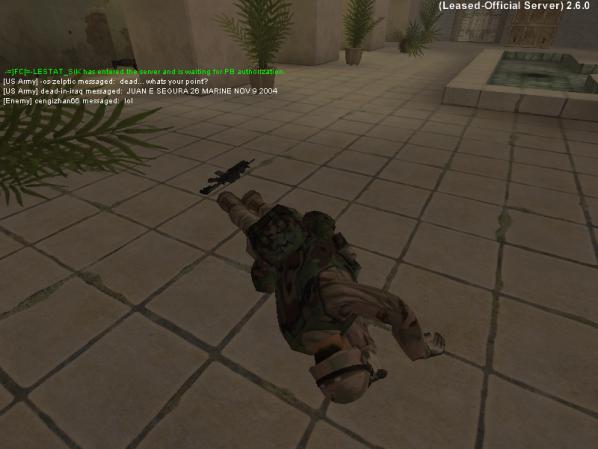
Joseph DeLappe, “dead…whats your point?” dead-in-iraq screenshot 2006-2011.
“The players ask DeLappe to stop what he’s doing, but when he continues they shoot him or simply kick him out of the game. You can see the strong reactions from the other players as a proof that DeLappe’s performance are successful. He succeeds to break the game illusion, in the same way as Brecht “Verfremdungseffekt” breaks the illusion in drama.” [1] (Jansson)
Much of DeLappe’s work is known for challenging his own nation’s involvement with war. However, if we look at The Salt Satyagraha Online: Gandhi’s March to Dandi in Second Life 2008, his work reflects a wider context introducing his concerns on the human condition. Over the course of 26 days, from March 12 – April 6, 2008, using a treadmill customized for cyberspace, DeLappe reenacted Mahatma Gandhi’s famous 1930 Salt March. “The original 240-mile walk was made in protest of the British salt tax; my update of this seminal protest march took place at Eyebeam Art and Technology, NYC and in Second Life, the Internet-based virtual world.” [2]
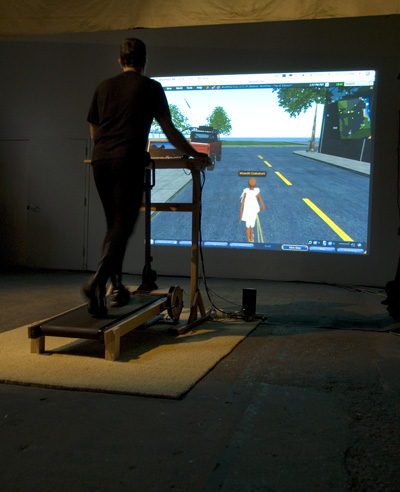
On hearing about DeLappe’s The 1,000 Drones Project – A Participatory Memorial, I was immediately intrigued. I wanted to find out more and discuss his approach as well as how he intends to bring to light the lives lost by these unmanned Arial predators as an art project, and what this would look like.
Marc Garrett: Could you tell us why you felt it was necessary to do this project even though there is already much media attention out there relating to the use of drones in domestic, military and commercial culture?
Joseph DeLappe: There has indeed been much media attention surrounding the use of militarized drones as a part of US foreign policy. Our drone policies have received much attention yet, as with the coverage of civilian casualties from the Iraq war, the actual human costs of our drone strikes remains rather illusive. Through the work I am doing regarding drones that specifically focuses on memorializing civilian deaths I hope to actualize the estimates of civilian deaths and to call into question the moral issues surrounding such remote killings. You might say that drones have struck a nerve with me. There is something different about drones. They seem to perfectly combine aspects of our worst fantasies of digital technologies, interactivity, computer gaming and war. One might consider them a bit of a “gateway” weapon (the drug reference is of course intentional here). I suspect we have indeed opened a Pandora’s box leading to the further utilization of remote and robotized weaponry that will make our current drone usage seem quaint.

The above is “An ongoing series of image interventions downloading images of UAV’s (unmanned arial vehicles) in use by the United States Military, including: General Atomics MQ1-Predator Drone, MQ9 Reaper Drones and Global Hawk Drones from the top results of Google image searches. Each image is slightly adjusted to include the marking “COWARDLY” upon it’s fuselage. The saved images are uploaded to my website with basic titling information “Predator Drone”, “Reaper Drone”, “Global Hawk Drone” – with the intention of having these images begin to appear in searches for information and images on drones occurs online. The works are intended as a subtle intervention into the media stream of US military power.” DeLappe
I am working on several drone projects at the moment, including The “1,000 Drones Project – A Participatory Memorial”, and seek to draw attention to and creatively memorialize those innocents killed by drones. It invites the public to create a small scale, papercraft replica of a General Atomics MQ-1 Predator UAV (Unmanned Arial Vehicle) – a drone. Participants are asked to write the name of a civilian drone casualty upon the wings of the aircraft.
This project is an adaptation of The 1,000 Cranes or “Senbazuru” tradition from Japan. This tradition holds that anyone who folds one thousand cranes will be granted a wish. Since World War II the tradition has been associated with the atomic attacks upon Nagasaki and Hiroshima – the folding of the cranes has become a wish for peace. [3]

MG: You are inviting participants to be a part of the project. In what capacity will they be taking part?
JD: The 1,000 Drones Project has been commissioned by the FSU Art Museum of the exhibition “Making Now – Art in Exchange”. The FSU Department for Art has for the past few months conducted a series of workshop events where the public is invited to make a small, paper drone from a provided template. The form is made directly from MQ1 Predator Drone plans found online. The drone shape is cut out, there are then five dotted lines denoting where to fold the paper – the result is a simple paper facsimile of a drone. Once the drone is created, the participant is invited to write the name of a civilian drone casualty along with their age at the time of death, upon the wings of the drone. The Bureau of Investigative Journalism estimates that between 2004 and 2013, drone strikes in Pakistan killed between 2,536-3,577 people, of these, it is estimated that 411-884 civilians and 168-197 children have been killed. The list of civilian drone casualties comes from The Bureau of Investigative Journalism. We are also using a list of drone casualties from Yemen found here: http://en.alkarama.org/documents/ALK_USA-Yemen_Drones_SRCTwHR_4June2013_Final_EN.pdf
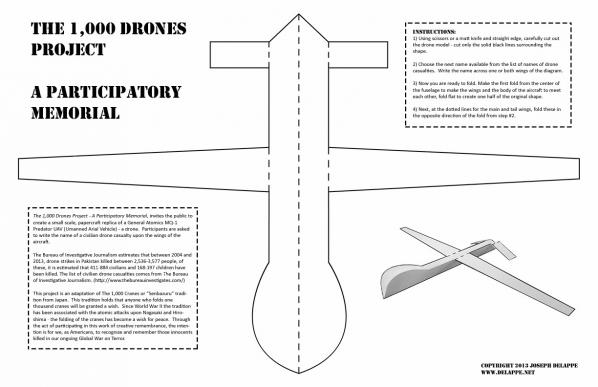
At present we have a total of 464 persons identified as civilian drone casualties from Pakistan and Afghanistan. To complete the 1,000 drones, the remainder will be marked “unknown”.
The paper drones are to be strung together in groups of 18 per string, 55 strands will be hung in the center of the gallery to create an installation that will be triangular in shape. The making of the drones will continue with the opening of the exhibition in February until 1,000 are complete and installed.
MG: What will others learn or gain from this participation?
JD: This is difficult to pin down. My intention is that through the act of making a drone, followed by writing a name or “unknown” upon their creation that individual participants will in some small way actualize the loss of individual lives due to our drone attacks. The intent is to perhaps for some brief moment make real these deaths taking place in our name on the other side of the globe. The actions are decidedly low-tech as well – there is something important in this – the deaths become physical, perhaps drawn from the digital media stream, the digital process of the killings to a direct, physical act of making and remembering. I am very interested as well in the overall effect of the piece – to see 1,000 white paper drones hanging in space as a memorial will likely have a powerful impact. Numbers of civilians killed as reported through our media are all too often numbing and abstract – this piece will hopefully make real this abstract process of digitally remote killings.
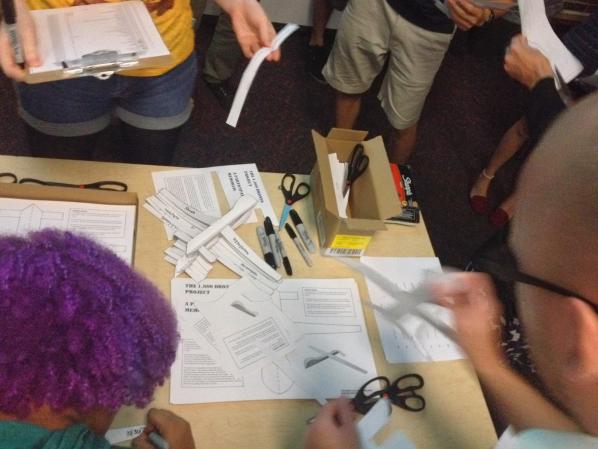
MG: What is the lineage of this project?
JD: I’ve been working intensively over the past decade to creatively shed light on civilian and military casualties as a result of our ongoing “war on terror”. This includes “dead-in-iraq”, my intervention as a memorial and protest taking place within the America’s Army computer game and iraqimemorial.org, a crowd sourced project launched in 2007 inviting anyone to post concepts, imagined memorials to the many thousands of civilian casualties from the Iraq conflict.
Looking at DeLappe’s breadth of work informs us how detailed and complicated the subject is, and it equally reminds us how distant we all are from any quality debate about war and drone technology and the impacts these militarised technologies have on citizen’s lives. Thankfully, on the subject of drones the Internet is supplying us with different view points that mainstream news media fails to seriously investigate. Russia Today, reported that classified documents from the CIA could not “confirm the identity of about a quarter of the people killed by drone strikes in Pakistan during a period spanning from 2010 to 2011.” [4]
Kate Rich and Natalie Jeremijenko in 1997 as part of the then, anonymous Bureau of Inverse Technology were pioneers of the first art drone ‘The BIT Plane’. This work was featured in a group show at Furtherfield’s gallery, Movable Borders: Here Come the Drones! in May 2013. [5] In an article in Mute magazine Rich wrote, “The morally disgusting asymmetry of drones relates not only to their deployment by the powerful against the weak, but also to the radical disparity of risk entailed in exposing the defenceless living to pilotless killing machines.” [6] This brings to mind how vulnerable we all are to the whims of the powerful. This feeling of fear will strike at the heart of any humanist not on the ‘right’ side of those wielding such awsome destruction without challenge, until its too late.
DeLappe’s art not only reflects the militaristic world we are living in he is directly engaged with it. His focus on his nation’s obsession with war echoes what James Hillman wrote in A Terrible Love of War, “Hypocrisy in America is not a sin but a necessity and a way of life. It makes possible armories of mass destruction side by side with the proliferation of churches, cults and charities. Hypocrisy holds the nation together so that it can preach, and practice what it does not preach.” [7] (Hillman 2004)
Many contemporary artists are working with and critiquing Bio-Technology, Nano-technology, engineering, issues on Climate Change, border controls, data-mining, surveillance, economic and political fluctuations, and the military. This is in line with the expansion of the networked society. Controversies and battles are taking place in a time of uncertainty, where the very technology and systems that have supported progress, through its worldwide channels of production and prosperity; are now the very same tools threatening the survival of our species, contributing to climate change and the emergence of the economic, global crisis, as well as a threat to our civil liberties. Art and critical thinking examining this complex and strange territory and its impacts on us and the planet are right up there in pushing forward a new kind of radical investigation as an art practice.
Joseph DeLappe’s next exhibition ‘Social Tactics’ will be from January 24 to April 27, 2014 Fresno State Center for Creativity and the Arts, in the US.
Exhibition Tour and Artists Talk (Magnus Eriksson and Geraldine Juárez)
Saturday 03 May 2014, 2pm
Exhibition tour led by Magnus Eriksson and Geraldine Juárez followed by a live walk-through of the Piratbyrån archive and talk about some overlooked gems from their history at Furtherfield Commons. Expect to learn some Swedish while we are at it!
SEE IMAGES FROM THE PRIVATE VIEW
Contact: info@furtherfield.org
Curated by Rachel Falconer & Furtherfield
EXHIBITION TRAILER – Piracy as Friendship
@Furtherfield “Don’t contact future. Future will contact you!”
“For the last sixty years, capitalism has been running a pretty tight ship in the West. But in increasing numbers, pirates are hacking into the hull and the holes are starting to appear. Privately owned property, ideas, and privileges are leaking into the public domain beyond anyone’s control.” – Matt Mason, The Pirate’s Dilemma
Piratbyrån and Friends traces the stories of cultural sharing and affinity-building among the activities and values of the members of Piratbyrån (The Bureau of Piracy). This Swedish artist/activist group was established in 2003 to promote the free sharing of information, culture and intellectual property. The exhibition presents screenings, installations and artworks by founding and more recent members, keen to tell the story of the group on their own terms. It features newly commissioned work by artists Geraldine Juarez and Evan Roth, and a new networked audio collaboration which mediates their rich archive and foregrounds the role of piracy as an agent of innovative disruption and cultural transmission.

“The specific character of friendship as a form of social relationship is that it does not presume a permanent interaction. Friendships are a type of serial solidarity. The story of friendship is a story of meetings.” Viktor Misiano – The Institutionalization of Friendship.
Piratbyrån have always resisted clear definition. Created on the Internet as a loose friendship group with a shared commitment to media and piracy in the shifting ecologies of digital copyright law, Piratbyrån operated through a number of different identities. From the #discobeddienti IRC chatroom, to the infamous Pirate Bay, to the determinedly analogue SX23 bus trip to Manifesta 7, and their subsequent disbandment in 2010, Piratbyrån consciously cultivated an air of mystery and intrigue around their many activities.
Piratbyrån have always had a particular commitment to the value of friendship as a shelter for culture and a space to understand, imagine and experiment as a community from the edges of the Internet.

The exhibition features newly commissioned sculptures and installations by artists James Cauty, Geraldine Juárez and Evan Roth and a screening programme that includes Steal This Film by Jamie King and Piratbyrån and Friends by Geraldine Juarez.
Tapecasts (2013-2014) – Piratbyrån and Friends
SK23 Suit (2008) – Lina Persdotter Carlsson / Piratbyrån
S23m Manifesta Bus Trip (2008) – Piratbyrån & Simon Klose
S23x Belgrade Bus trip (2008) – Piratbyrån
Polymarchs posters (1980-1990) – Jaime Ruelas
Sharing is Caring Map (2008) – Sara Wolfert / Mathias Tervo / Piratbyrån
Kopimi Totem (2014) – Evan Roth
Torrent Tent (2014) – Geraldine Juárez
Riot Chat (2014) – Palle Thorsson
Smiley Riot Shield 2 (Second Edition) and PB2 (2014) – James Cauty
Piratbyrån (The Bureau for Piracy) was started by a bunch of hacking, coding, reading, listening, philosophising, clubbing, rioting, carding, chatting, loving, slacking people in 2003 as an antidote to Hollywood’s representatives in Sweden – Antipiratbyrån.
In 2007 – after having kickstarted the Swedish debate over file-sharing, which by the time had become a major issue in the previous years national election and after having created The Pirate Bay as a side-project that became the world largest file-sharing system – the people from Piratbyrån had grown tired of the file-sharing debate and its endless repetitions of for-or-against, legal-or-illegal, payment-or-gratis. At the last day of April in a Walpurgis fire on the top of the highest mountain in Stockholm the masked members burned the remaining copies of a book on file-sharing they had published some years earlier and declared the debate dead. The video documentation of this ritual, set to the soundtrack of KLF’s “What Time is Love”, found its way to the Indian Raqs Media Collective group who was just about to curate the next Manifesta biennial in Bolzano, Italy.
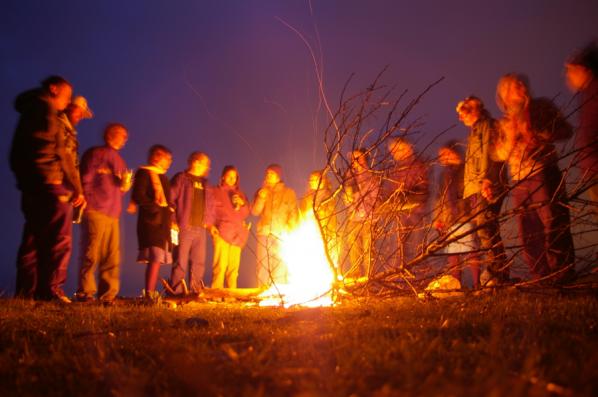
The loose network of Piratbyrån, now loaded with 7000 Euros of art budget and a sizable amount of cash from selling Pirate Bay t-shirts, decided to purchase, renovate and decorate a 1970s city bus, stack it with 23 people, and head down south.

The ongoing relation with the bus – named S23m/x/k respectively for each trip – would later make an exodus from the exhibition in Italy to head across Eastern Europe and end up at the trial against Pirate Bay. It became one of the most significant undertakings of Piratbyrån and shaped their thoughts on the tensions between digital abundance and crowded space, collective decisions and freedom of choice, and that which can be copied and that which can’t. The bus became a line of flight from the collective subject that had been built, a subject which was very associated with The Pirate Bay and also with Swedish politics, including the Pirate Party.
While nothing was really the same after the bus had returned, Piratbyrån formally lasted until 2009, when the tragic death of one of the founding members – Ibi Kopimi Botani – defined the end of an era. The Internet had already transitioned to another phase and it is not until now, and enough time has passed, that we as a culture are ready to reflect on what exactly happened during those years.
Piratbyrån always had an implicit friendship with the KLF. They share the same historical web of connections and share a similar trajectory, but their activities are shifted in time by roughly a decade. The only contact between the two is a response from Bill Drummond when Piratbyrån sent a link to the documentation of the Walpurgis ritual. It read:
> Thank you for your email.
> I have just read the text at the link.
> I enjoyed it and understood it.
It is probably good that they didn’t exist at the same time because the gap in time gives the relation an infinite unresolvable tension of unfulfilled connectivity and unlimited possibilities.
James Cauty
For Piratbyrån, James Cauty’s personal work resonates with the themes of abundance and rarity, presence and absence, functionality and waste, control and chaos, and draws on the same symbolic language that mixes clarity with suggestion. There is also a similar urge to *stir things up* and *stick ones nose where it doesn’t belong*.
Evan Roth
Speaking of stirring things up, FATLAB was for Piratbyrån another one of those instantly recognisable friends that had never met; the art group that Piratbyrån never became, the “the unsolicited viral marketing wing of the open-source movement”, the graffiti crew of the World Wide Web. FATLAB was born when the file-sharing debate was buried and the new web 2.0 era transformed the web.
Evan Roth, co-founder of FATLAB, has made a piece for the exhibition that in a subtle but direct way captures the concept of KOPIMI; how meetings and connections leave traces and makes you a carrier of ideas and information, sometimes without you even recognising it.
Jaime Ruelas & Polymarchs
The soundsystem collective Polymarchs and their illustrator Jaime Ruelas, probably happily unaware of the existence of Piratbyrån, embodies a scene in Mexico where piracy has always been a way of life and a mode of existence. They have materialised, expressed and lived what was only hinted at in glowing screens up in Sweden. Having outlasted all of the above mentioned collectives and managed to stick together for decades, they also highlight both the potential strength and – as a contrast – the fragility of so called “confidential projects”; those moments when friendships turn into expressive units and the borders between the intimate and the public are blurred.
Geraldine Juárez
Last but not least, Geraldine Juárez is the reason this exhibition came together at all. She began to read the Swedish-language blogs of Piratbyrån members through Google translate – whose mistranslations made them sound like they came from the near future instead of the near past, until she finally came into contact with Piratbyrån by translating updates from the trial – or Spectrial, as it was known – into Spanish. Now she returns the favor of time-travelling by re-awakening Piratbyrån one last time, to allow their archive to again live up, their ideas to be carried over to others and perhaps even some sense made from what happened, although these things can only be interpreted, misunderstood and re-appropriated – never explained.
Inside the tent that she has crafted for the exhibition – a torrent for piracy as the last shelter of culture – there will be a collection of tapes prepared and circulated by Piratbyrån and friends, perhaps giving some seed for thoughts and guidance in the process of excavating the archive of Piratbyrån.
About co-curator Rachel Falconer
Rachel Falconer is a curator, writer and producer working at the intersections of technology, the media and contemporary art. She currently holds the position of Head of Art and Technology at SPACE and runs the art and technology programme at The White Building and SPACE MediaLab. She is Co-Editor at Furtherfield and a founding member of the collective Hardcore Software.
Her curatorial practice is hybrid and interdisciplinary in approach and her current activity and research focuses on the pathologies surrounding social spaces and human behaviours engaged with networks and new technologies.
Furtherfield Gallery
McKenzie Pavilion, Finsbury Park
London N4 2NQ
T: +44 (0)20 8802 2827
E: info@furtherfield.org
Furtherfield Gallery is supported by Haringey Council and Arts Council England
The artist and curator Art Clay was born in New York and lives in Basel. He is a specialist in the performance of self created works with the use of intermedia and has appeared at international festivals, on radio and television television in Europe, Asia and North America. His recent output focuses on large media based performative works and spectacles using mobile phone devices. He has received prizes for performance, theatre, new media art, music composition and curation. As an educator, he has taught media and interactive arts at various art schools and universities in Asia, Europe and North America including the University of the Arts in Zurich. He is the initiator and Artistic Director of the ‘Digital Art Weeks International’ and the Virtuale Switzerland.
Eva Kekou: Could you tell us about your work and what inspires you?
Arthur Clay: The question about inspiration has been posed to me before and most often in the moment when people first see the program that the Digital Art Weeks (DAW) is offering. As an artist I am very much inspired by the every day. I think it is important to be aware of the things around you and by so doing, my artwork seems to have more of a present day dialogue and the events I curate more to do what is actually going on in the society around me. So basically, everything and nothing and all the things in between inspire me. There are no rules, but with a lot of effort to try and come closer to things might be the one I apply the most.
On the one hand, I am a practicing artist and most of this work is concerned with sound. On the other hand, I believe that curation is an art in itself and requires a high level of creativity. It is easier for me to make an artwork in comparison to harmonizing a group of artworks. The two meet in the fact that I grounded the DAW projects in order to provide a platform for my own work and that of others, who think in like minded ways.
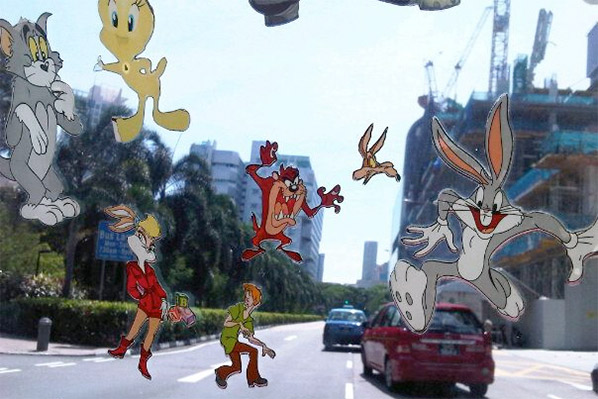
EK: You were the curator for the Augmented Reality exhibit “Window Zoos & Views” in collaboration with the participation of the School of Digital Media and Infocomm Techology from Singapore Polytechnic. On the project site, it mentions that the main element of the project was inspired by an image of a car driving down Singapore’s legendary Orchard Road. Could you tell us a bit more about this and the project?
AC: As DAW Director, I am confronted with the same situation each time we bring the festival: Representation and integration. By representation is meant that we have institutions both public and private that act as stakeholders and in turn expect a high level of visibility; talking about integration is much more complex, because there are many levels of integration that must be addressed. First off, the festival structure demands that we integrate local artists into the program along with the international artists participating. Integration of local artists can also mean or entail a high level of knowledge and skill transfer. We do all this during what we like to call the “Exploratory Phase”, which is basically entails dropping the DAW team into a unfamiliar city and making every effort to make it familiar. This includes becoming aware of the general culture the festival will address, how digital that culture is, the art and non art spaces that will become the stage of the festival, and of course trying to find out who is doing what in terms of arts and technology.
To get back to your question about the image of the car driving down the street, the most important element of integration is becoming aware of what is going on in the world of things in which the festival is to be presented. The car we are talking about was a car whose windshield was plastered with cartoon stickers. So, imagine you’re self-sitting at the wheel of that car driving down Singapore’s Orchard Road. It is a really surreal experience; the stickers take on a kind virtual elelment as it floats down Orchard road. The image sparked my imaginations and the AR Parade project was born, which was a very important part of the “Window Zoos and Views” exhibit. Basically, the AR Parade mimicked the effect of the stickers on the car window, but instead of a car windshield, we used an iPhone app to view the images. It was very cool, popular on the street and got a lot of clicks.
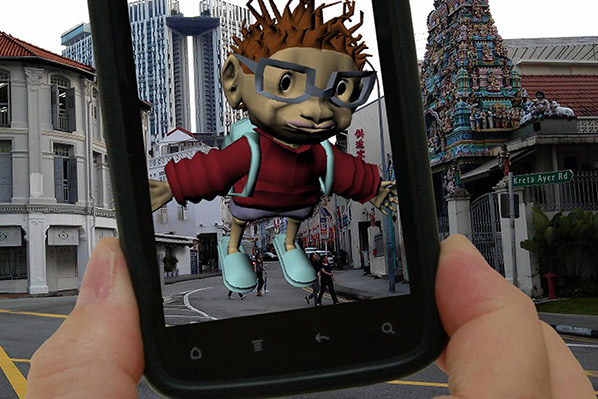

EK: There were various artists in the festival showing Augmented Reality art as installations. This included artists such as Tamiko Thiel (DEU), John Cleater (USA), Will Pappenheimer (USA), Lily & Honglei (CHN), Marc Skwarek (USA), Lalie S. Pascual (CHE), John Craig Freeman (USA), and Curious Minds (CHE). It must of have taken a lot of time and energy to organize this, especially the technological aspects of the project. How difficult was it to set all of this up?
AC: In one word: impossible. It is new area of technology, a new approach to curating art, and above all you are dealing with a non-art public – basically anyone who is on the street. That is a big challenge. Add to it the new type of management skills that such an international project work requires and I think you are close to the impossible that I am referring to. For such exhibitions, “Management 2.0” skills are a necessity. The artists, the tech people, and the curators and admins meet and work solely in virtual space. So there are no walls, no tables, and there is no going for coffee together after the meeting. It is a different world from all sides.

Another interesting aspect of this work is that you have to develop a feel for the city and develop a dialogue with it. For the Hong Kong show we did for SIGGRAPH Asia, Monika Rut and I spent about a week working on site, visiting the different areas of the city to check things out and to get a feeling for which works should go where and why. We travel with a lot of special equipment so that we can make tests on site and produce a mock up of the exhibition and test how the experience of viewing the exhibit will be. It is very inspiring but exhausting work and the dialog between Monika and I helped greatly in making all the decisions. Basically, we get to know the cities we are working in quite well and the kick back is, you get to know where the best coffee houses and local restaurants are.
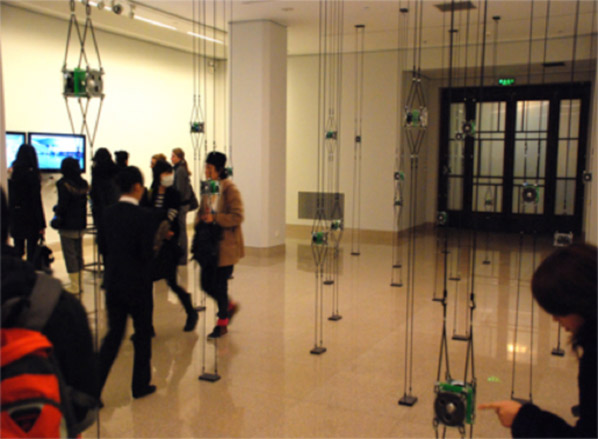
EK: Why hold the DAW in Asia, and what kind of differences do you experience culturally when working in Asia compared to working in Europe?
AC: The DAW is at home in Asia and much of our curating has to do with having visitors get pro-active. This means that it is not just about looking at an artwork, it also entails actually touching the artworks in many cases. In Asia, the museum visitors are not that schooled in museum etiquette. They like to touch things and this is great for the kind of work we like to do. Things break, but it is kind of a “I Like” thing for us.
The other aspect to consider is that you have a language barrier, because no one is going to understand anything if it is not translated. Here, it is also important to know that the approach Europeans take in terms of explaining artworks, does not really come over so well in Asia. Things are often inspired by poetics of nature in Asia and are much less conceptual than works coming from Europa.
Last but not least, the role of size also plays a large part in Asian arts. When a dynasty was at its peek, it produced very large artworks, monuments etc. So size is historically a sign of wealth and prosperity in Asia. When a dynasty fell, they produced much smaller works. So the bigger the better, so to say. For a European artist this is completely meaningless, however, bigger artworks have more visibility. So when you are curating group exhibits in Asia that artists from diverse countries, it is a challenge to keep balance in terms of impact of the works.
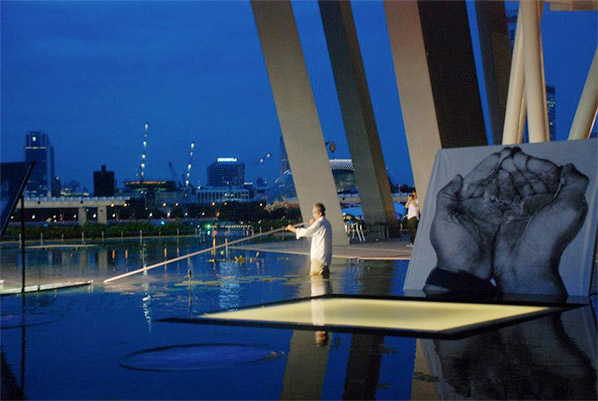
EK: Getting back to There DAW AR Float Parade, which was the first of its kind and celebrated as the coming age for Augmented Reality art. Could you tell us more about this aspect of the festival’s project and how it turned out?
AC: Knowledge transfer plays a major role in getting a project like the AR Parade to work. The DAW has an “OutReach Program”. This is a program that invites creative leaders from around the world to hold workshops before or during the festival. The contents of the AR Parade in Singapore were the results of a workshop with the AR artist John Craig Freeman and the Curious Minds group. John Craig dealt with the technical details and the bootstrapping a group of twenty-five creative industry students from the Singapore Polytechnic. The members of the Curious Minds art group hung around, integrated the group into the DAW, taught the students about public interaction, and came up with how to go about actually making the AR Parade happen and come to life.
The proof of a good project for me is when it takes on its own life on after its initial presentation. After the Singapore DAW, the AR parade went to Hong Kong and in 2015 it will be shown marching down the Bahnhofstrasse in Zurich as part of the Virtuale Switzerland festival – the world’s first festival “virtual biennale” that focuses solely on virtual artwork. For this we want to go a bit deeper into the creative industry world and see if we can act as modern alchemists and pick up on the float parade from New York and turn Miss Kitty into an artwork by shifting context from the real to the virtual.

Live- Performance “Beads are the Breath of the Landbridge “ with 1st Nations artists, Peter Morin. (DAW Singapore 2013)
EK: What is your view regarding the social contexts of the DAW?
AC: Basically, we are concerned about things and we make an effort to improve things that are within our reach to improve. For the festival in Taipei that will take place in 2015, we are really trying to make people aware of the role of creativity in general. Artists are highly creative people and the world really needs good ideas as well as a more social approach. We try to provide an answer to the question: “How is what we do of benefit to the society in which we are operating?” We think this should be more a question that businesses should be asking themselves. The future needs fewer companies who are “profit first, prosperity second” and more social entrepreneurships that embrace social needs as part of their business model.
EK: Could you tell us what themes and aims we can expect from of the DAW project in the future?
AC: We are off to Seoul, South Korea in 2014 and the theme there is “Creativity and Convergence”, which is a hot topic in Asia, because the government feels that innovation is intimately connected to being creative and thinking out of the box. I think they’re thinking of what makes the West tick and in an odd and ironic way to imitate – which is not exactly creative, but then again I have lot of respect for Asia and admire the work ethic of Asian people. So I think they will do well by addressing these themes. In 2015, we are off to Taipei and the theme (working title) there is “ImagiNation” and here we are trying to run a kind of “Skills-Festival” and platform creative businesses and the approaches that they have taken. It is a new approach and if you think about what Beuys said, “Everyone is an artists”, we might stretch it a bit and also say “everything is art.” At least this is the start and interestingly enough we are working with groups from the labor department in Taiwan, with knowledge transfer departments of universities, and with spin off and start up companies from Switzerland. It is very exciting and really what the DAW is about: creating a platform for research and experiments in social-cultural context.
Digital Art Weeks International
The DAW INTERNATIONAL’s is concerned in general with the bridge between the arts and sciences in cultural context with the application of digital technology in specific. Consisting of symposia, workshops and cultural events, the DAW program offers insight into current research and innovations in art and technology as well as illustrating resulting synergies, making artists aware of impulses in technology and scientists aware of the possibilities of application of technology in the arts.
The Virtuale Switzerland
The Virtuale Switzerland is a biennale for virtual arts. It focuses on the use of public space and mobile communication technologies, inventing “playful” new strategies to coax the public into the festival as “real” visitors with a unique experience of the virtual. The Virtuale Switzerland encompasses Artworks using Augmented Reality, Urban or Location Based Gaming, and Digital Heritage applications. It is interdisciplinary in nature, bridging areas such as art and technology, digital heritage and tourism, as well as digital culture and art mediation.
The end of boom and bust ended with the credit crunch. Following the global financial crisis of 2008, the Eurozone crisis has produced technocracy and poverty rather than democracy and wealth. Reactions to these failures of monetary policy are informed by technology as never before, from austerity being imposed thanks to an Excel spreadsheet bug to the rise of the anti-statist cryptographic currency of Bitcoin.
Against this backdrop of monetary failure and technological critique, _MON3Y AS AN 3RRROR | MON3Y.US is an ambitious online survey of net art depictions and critiques of money and its institutions curated by the pseudonymous curator “Vasily Zaitsev”. As well as the work from 70 or so artists invited to participate an open call for work increased the number of pieces in the show in total to around 200. I only consider the invited artists here, but the work in the open call section is well worth looking at as well.
The show web site has a simple HTML interface, starting with a single image and a pull-down menu of other works. Disable your pop-up blocker and you’re ready to start.
Miron Tee’s “Shame” is the image that fronts the show, an image of a dollar modified to show George Washington peering out nervously from behind the oval frame in the center.
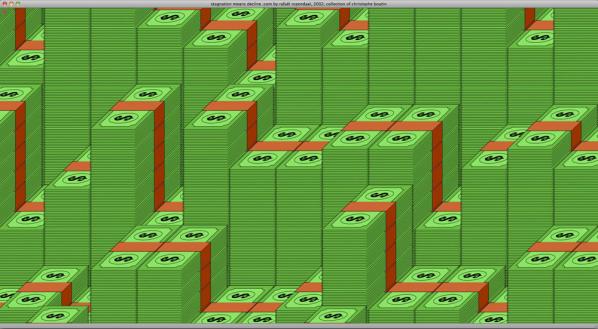
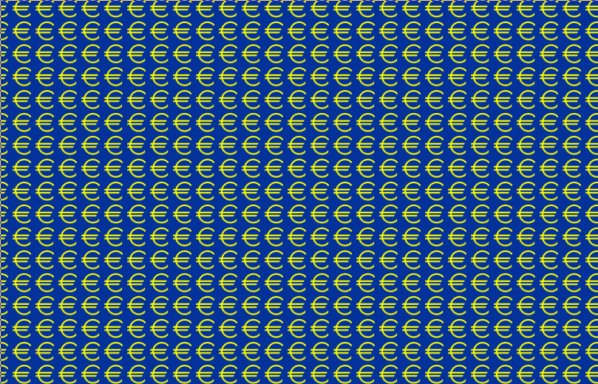
Dominik Podsiadly’s “Joy to ide” starts the pull-down menu with a flowing grid of Euro signs on a blue background to the sound of “Ode To Joy” playing backwards. It’s an all-over, closed temporal loop of the kind that animated GIFs exemplify and encourage, the Euro falling forever.
Nuria Güell’s “How to expropriate money from the banks” is a more direct action based work of culture jamming explaining presented in a well laid out document in the style of HSBC’s First Direct brand.
Paolo Cirio’s “Loophole for All” makes offshore tax havens, those loopholes in taxation regimes that allow corporations and the super-rich to avoid repaying society, available to everyone through a web site interface.
Rafaël Rozendaal’s “Stagnation Means Decline” is a screenful of geometric pixel-art dollar bill stacks that fill the screen with their edges only to be obscured by new columns like an economic game of Life.
Filipe Matos’s “Crash” is an undulating animated monochrome concrete poetry American flag with the stars made from the letters of “me” and the stripes as “you”.
Adam Ferriss’s “paper$hredder” is a Vimeo video clip of American dollar bills speeding by faster and faster until they dissolve into a blur.
Aaron Koblin + Takashi Kawashima’s “Ten Thousand Cents” is a composite image of a hundred dollar bill crowdsourced by paying people a cent to paint each piece through Amazon’s Mechanical Turk service.
Maximilian Roganov’s “When the Mao was small, he worked for CIA” is a looped animated GIF colour 3D scan of a dollar bill, polygonally glitched or possibly crumpled over time.
Dave Greber’s “Self Portrait With Dog” video is aptly titled, apparently taking place as the custom graphic on a Visa Mastercard.

Agente Doble | UAFC’s “Watermark will not appear on purchased artwork” is a million dollar blank artwork if you email them and purchase it, otherwise it’s just a url on a blank web page.
JUST DO IT’s “Fifty Euros Inside/Fifty Euros Outside” are animated GIF loops of fifty Euro notes pulsating as if to sound waves on an oscilloscope.
Mitch Posada’s “$$$” is a Flash video of Silicon Graphics-era-style VR models of skeletons exploding and morphing into their constituent polygons while texture mapped with Deutschmarks.
Emilio Vavarella’s “Money Complex” is a tube map-style world map with banknote-collage continents and a key for numeric labels that can be zoomed in on by moving the mouse to reveal their often incongruous labels. It’s one of the more complex works in the show art historically and conceptually.
Lorna Mills & Yoshi Sodeoka’s “Money2” is a Vimeo video loop collage of roughly extracted elements from videos of commodity fetishism, fire and death.
Fabien Zocco’s “Cloud” is a generative composition of black dollar signs scattered up over a yellow background over time like a plume of smoke.
Jasper Elings’s “Territory” is an animated GIF loop of a dollar bill flag blowing in the roughly simulated wind on a white background. It’s not the only such piece in the show.
Robert B. Lisek’s “FuckinGooglExperiment” is online statistical analysis code that tries to correlate the change in Google’s stock price with changes in their PR strategy. It also uses the excellent Fluxus livecoding environment.
Alfredo Salazar Caro | TMVRTX’s “How to make money on internet remix” is a tightly tiled video loop of a rotating stack of dollar bills in a lava-lite-like flow of colour psychedelia.
Anthony Antonellis’s “How to make money on the internet” is simply that rendered block of spinning virtual hundred dollar bills, plucked from the era of RenderWare and VRML.
Gustavo Romano’s “Pieza Privada #1” is another piece of net art for sale at a specific price, with a carefully described contract and application form.
Tom Galle’s “One Million Dollars For iPhone” is an app available on the iTunes Store that allows you to count a virtual million dollar wad on your iPhone.
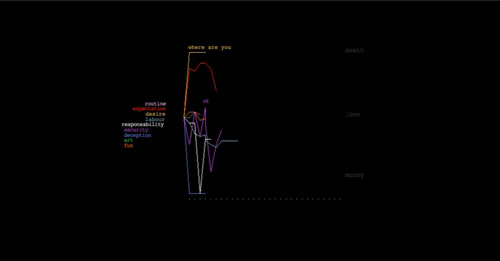
Geraldine Juarez’s “Love Not Money” tracks the associations of various words with “death”, “love” and “money”. I had to Google this one: it’s a Processing visualisation of a personal stock market tracking the artist’s conceptual assets over six weeks. I love it.
Nick Kegeyan’s “C.R.E.A.M. (Cash Romney Eat A Lot of Money)” is simple, direct and effective video burst of an American news interview subject morphing into a cloud of falling texture mapped dollar bills.
Dafna Ganani’s “Apple Dollar Explosion” is another descriptively titled piece, a Maya-looking apple texture mapped with a dollar bill spinning against a grey background then exploding into its constituent polygons.
Haydi Roket’s “$” takes a dollar bill portrait and literally deconstructs it by pixelating it in increasingly primitive ways, first as 4-bit grey patterns, then in monochrome ANSI characters, alternating to inverse video and changing the contrast to give a flickering effect.
Jennifer Chan’s “Infinite Debt” is a video of a twenty Euro not being dipped in batter and fried mixed in with a collage of clipart images and video on the cynical economics of contemporary art and consumerism.
Frère Reinert’s “Money as a waste of time” is a deliberate excercise in futility; a blurred, zoomed in silent video of the MacOS X SBOD on a white backdrop.
Cesar Escudero’s “Captura de pantalla 2013-03-08 a las 21.46.23” is a Mac OS X desktop image of a gas masked protester who appears to be reaching for a folder named “$$$$$$$”.
Jefta Hoekendijk’s “Money Is Data” is an animated GIF loop of a glitchily texture mapped virtual fifty Euro note in artificial colours.
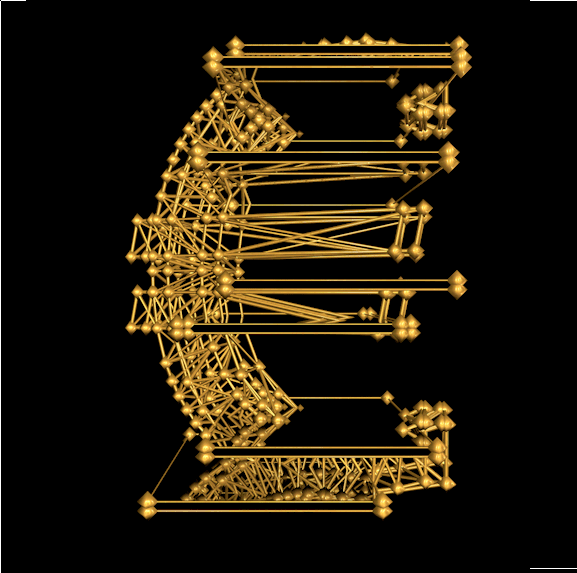
V5MT’s “¥€$ or N0T” is a rap video or Designers republic album cover-style animation of monumental metal morphing currency symbols made from struts and spheres like newton’s cradles or molecular diagrams.
Addie Wagenknecht’s “How To Make $$$$$” is a grid of money counterfeiting video tutorials, which are apparently a genre. Playing all at the same time they become an all-over aesthetic rather than incitement to a crime.
Gusti Fink’s “infinite loop of money drowning in water oil” is a slow, monumental simulation of a platinum visa card sliding into dark liquid that the camera pans over as if it were a sinking ship.
Marco Cadioli’s “You are here” shows globe and landscape maps constructed of dollar bills, with a pin or map icon to show your place in the economy.
Keigo Hara’s “Making Of Fake Bills” is more halftoned (or possibly shape grammared) dollar bills.
Jan Robert Leegte’s “Currency Graph” shows European flag yellow bars over a European flag blue gradient background. It’s a mutated and abstracted evocation of news information graphics aesthetics in CSS and JavaScript.
Ellectra Radikal’s “Disolved €uro” is a flickering autotraced, find edged and glitched animated zoom into a hundred Euro note that renders it spatial and architectural.
Paul Hertz’s “5,000,000$” it the purest glitch art piece in the show, rows of corrupted and miscoloured banknote imagery that looks like nothing so much as classic street art.
Aoto Oouchi’s “It’s all good” is an uncanny New Aesthetic 3d rendering of liquid or possibly mirrored texture mapped banknotes pouring from a wall.
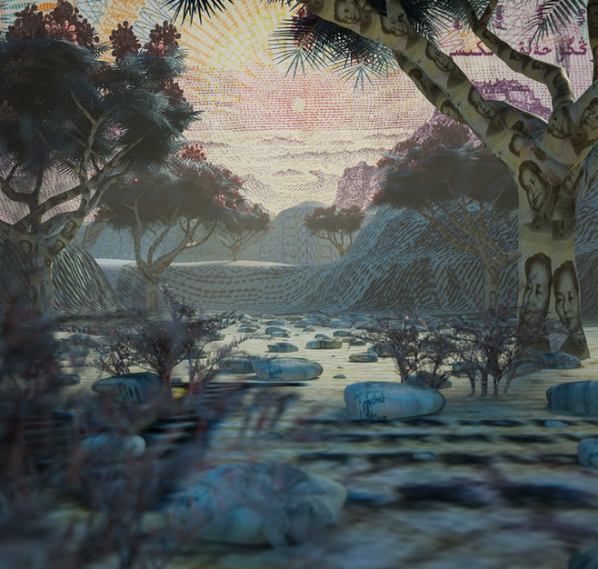
Kim Laughton’s “Landscape” is a rendered and collaged landscape of banknotes, resembling nineteenth century engravings of dramatic landscapes thanks to the inconography and texture of its source material.
Andrey Keske’s “Tell Me What You Want” is a search engine-style text box prompt that shows the economic coercion inherent in neoliberal use of technology by only allowing you to finish one word beginning with “M”.
A Bill Miller’s “3xpl0d3m0n3y” combines a grainy analogue glitch aesthetic explosion of a dollar bill into waveform stripes into a black space of drifting Matrix-green dollar signs.
Martin Kohout’s “Watching $100 Note Unveiling Video” has a ChatRoulette look, with the unseen unveiling causing a small smile to break out on the depicted viewer’s otherwise affectless face.
Marc Stumpel’s “pH0r 7|-|3 L0\/3 0Ph /\/\0|\|3’/” is a glitched and colourised monochrome television popular music performance from the age of mass media. Again I had to Google it but the song is ‘For the love of money’ by The O’Jays.
Benjamin Berg’s “$(0x24)” (the hexadecimal number that represents the dollar sign in ASCII) is a colourful and stripy glitch animation that resembles test cards, 8 and 16 bit graphics, and even woodcut as it breaks down.
LaTurbo Avedon’s “$$$$$$$$$$$$$$$$$$$$$” is an ambient modern html5 animtion of the avatar-artist reclining on money texture-mapped couches floating up and down a Google image search page for the word “millions”.
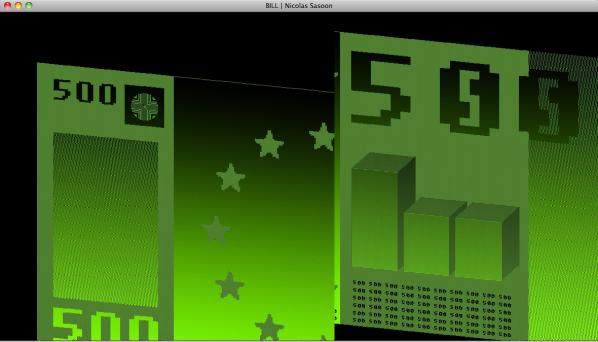
Nicolas Sassoon’s “BILL” is a flickering green screen terminal or slow scan TV-style rendering of a 500 Euro note that plays with the visual language of digital images: the letters and stars are highly pixellated but the backdrop to them is a smooth gradient.
Curt Cloninger’s “i want KANDY” loops images of a dancing sniper camouflaged figure montaged with dollar bills and fruit over a more slowly changing background collage of the american flag, a dollar bill, and fruit making a post MTV-styleguide image of the military-economic-entertainment complex.
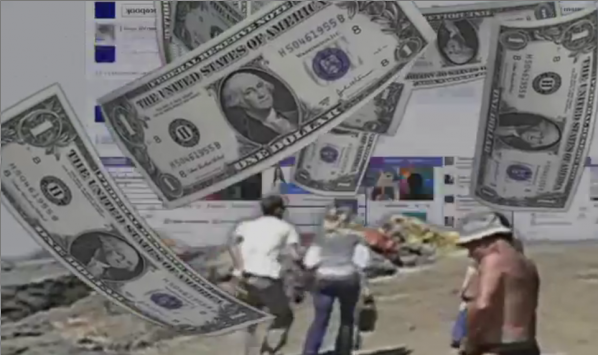
Systaime’s “ʞooqǝɔɐɟ Dollars” video portrays a world where curvily rendered dollar bills rain over an amateur video of tourists at a beach with a sky of quickly cycling Facebook pages.
Erica Lapadat-Janzen’s “Money Troubles” is a PhotoShop Pop Dada montage of exploitatively normative female beauty and monetary and drug excess that subverts the imagery of the fashion pages.
Milos Rajkovic’s “Mind Wheel” is a wonderfully Gilliamesque collaged animation depicting a mental wage labourer.
Émilie Brout & Maxime Marion’s “Cutting Grass” depicts the pointless and trivial labour that video games such as “The Legend Of Zelda force players to engage in for unrealistic rewards such as gold coins and rubies so they can get on with their quest.
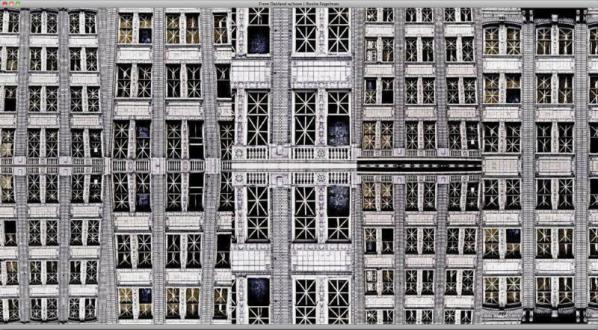
Rozita Fogelman’s “From Oakland w/Love” is a point-and-click kaleidoscopic archtitectural portrait of gentrified Bay Area architecture.
Georges Jacotey’s “am I enough political now” is a Chatroulettish video selfie of an augmented reality Euro flag and symbol drawing and dancing session.
Δεριζαματζορ Προμπλεμ Ιναυστραλια’s “Major Problem” is a rendering of a stack of dollar bills as seen through heat haze or under water, rippling and undulating against a white background.
Lars Hulst’s “0 €uro” is a rendering of a zero Euro note.
Nick Briz’s “a return to secularism” is a video documentary of twenty dollar bills being printed with the words “a return to secularism” flashing over it, framed by a repeated loop of the words “in God we trust” being crossed out on a dollar bill where they were added in the 1950s.
Jon Cates’s “MØN3¥-Δ$-3ɌɌɌØɌ” is a Classic Mac monochrome bitmap or fax aesthetic PDF essay for the show and an exposure of the print on demand economics of that essay in the same style.
León David Cobo’s “Conversation With Machine” has a 1990s broadcast graphic feel, showing the soundwaves of the feedback of a conversation with Siri asking it for money in Euro blue and yellow.
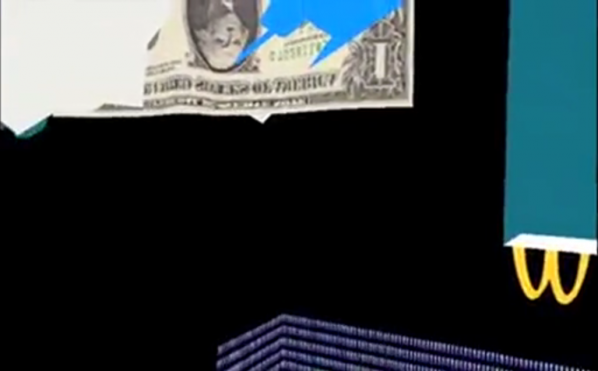
Guayayo Coco’s “Money | GLıɫcʜ ᴬᴺᴰ GLıɫɫɛʀ” is a video of a journey through a VRML-style virtual environment of discrete polygonal objects texture mapped with dollar bills, corporate logos and more abstract patterns with a radio channel-surfing soundtrack.
Vince Mckelvie’s “MONEY” is a reactive interactive deconstruction of a hundred dollar bill into a grid that reacts to the viewers’ mouse movement, revealing pulsating colours behind. It’s a good example of how suitable html5 is for this kind of thing.
Ciro Múseres’s “YOU HAVE WON” is a classic net.art style HTML bomb of overlaid text and links with content from financial web sites such as Barclays, Halifax and Santander that continuously adds and removes layers in different shades red, black, blue and green text to make new compositions.
Adam Braffman’s “Money Loading” is an animated GIF of the frame of a 100 dollar bill with a “Loading…” speech bubble in the centre. It makes the show’s themes of absent and delayed wealth more obviously explicit.
Rollin Leonard’s “Portrait of a NetArtist” is an two-frame animated GIF of the artist naked in the bath with bundles of fake hundred dollar bills with which they are lighting their cigar.
Thomas Cheneseau’s “100€ sequence” is a grid of glitched sections of a hundred Euro note that moires with colour as you scroll it. There’s a link to the facebook album that constitutes the actual work, and it works much better as a clickable album than as a static single image.
Yemima Fink’s “This is not money” is an abstract postmodernist collage of graphical quotations from the counterfeit-resisting elements of banknotes that is both witty and a very effective defamiliarisation of the iconography of banknotes and the power that they represent.
Mathieu St-Pierre’s “Untitiled” is a glitched jpeg of a dollar bill that in its straightforward application of glitch aesthetics makes the most direct link between them and the economic “glitch” of 2008.

Kamilia Kard’s “Amazon VIP girls” is the lone tumblr in the show, with an aesthetic that is either post-internet or pre-Google depending on how old you are applied to the supposedly perfect clothing models used by web sites.
José Irion Neto’s “Untitled” is a glitched banknote that turns JPEG artefacts into Klimt patterns.
There are definite historical trends and formal themes within the included work. Polygonal, texture-mapped, 90s-style VR-style objects that spin or explode. Net art and functional web sites that track or create financial and legal entities and transactions. Looped animations of textures, rendered flags, or video detournements. The imagery of accumulation, consumption, and destruction, always ironically. Imagery and symbols presented in simple loops fast or slow for contemplation. Graphs and maps of real and imagined economic signifiers.
In terms of genre, _MON3Y AS AN 3RRROR | MON3Y.US includes classic VR and video art, more modern GIF loops, textual and institutional net.art, glitch art, even some New Aesthetic. The language of computer graphics, texture mapping and polygons, allows the imagery of banknotes to be defamiliarised and deconstructed. Less often, personal experience and iconography displace the cultural imagery of wealth, consumption and debt.
This historical, formal and genre coverage of the variety of artworks included in the show comprehensively illustrates the chosen theme of “money and error”. This creates its own genre and lineage for the included artworks, which gain by comparison to their newly identified peers. They also contribute to the social and economic critique of the show. It’s a very successful balancing act, which the simple interface and presentational strategy of the show’s curation are key to achieving.
_MON3Y AS AN 3RRROR | MON3Y.US is an almost overwhelmingly successful in its comprehensive review of net art’s critical depiction of and engagement with money. By taking a technologically simple but historically, conceptually and logistically ambitious approach to net.curation for net.art it demonstrates the effectiveness and lasting value of net art’s contributions in this area and the power of online thematic curation to draw together and contextualise this value without giving in to the often perceived need for offline institutional underwriting.
Featured image: Sam Meech, Punchcard Economy, 2013. Photo courtesy of FACT.
The new exhibition “Time & Motion” at FACT in Liverpool, UK, takes the pulse of punchcard protocol and creative capital in our own “Modern Times”.
The exhibition Time & Motion: Redefining Working Life at FACT Liverpool is a collaboration between FACT and the Creative Exchange at the Royal College of Art – an initiative which looks at how arts and humanities researchers can work with industry to effect digital innovation. Rachel Falconer reviews the exhibition in the context of the paradoxical dynamics of cognitive capital and the changing landscape of the labour market.
Now self-employed,
Concerned (but powerless),
An empowered and informed member of society
(Pragmatism not idealism),
Will not cry in public,
Less chance of illness,
Tires that grip in the wet
(Shot of baby strapped in back seat),
A good memory,
Still cries at a good film,
Still kisses with saliva,
No longer empty and frantic like a cat tied to a stick,
That’s driven into frozen winter shit
(The ability to laugh at weakness),
Calm,
Fitter,
Healthier and more productive
A pig in a cage on antibiotics.
Fitter Happier, Radiohead.
The frantic quest for the elusive Shangri-La of work/life balance is a neurotic luxury afforded only to the always-on, hyper-connected generation of precariously unstable home office workers[1] in our hypercapitalist society. The working rhythms of this emergent class of “precariat” [2] are far removed from the forensically prescribed scientific management resulting from the time and motion studies associated with Taylorism at the beginning of the last century. This shift in working patterns generated by the digital revolution is the primary focus of the exhibition Time and Motion, Redefining Working Life currently at FACT, Liverpool. From an archival, filmic view of the automated, (Western) industrial factory labourer to contemporary portraits of the global information worker’s state of perpetual imbalance and non-stop, hyper-connectedness [3] the participating artists expose the – often contradictory – ecologies of labour, consumption, and the conditions in which they operate. The exhibition also marks the collaboration between FACT and Creative Exchange at the Royal College of Art – an initiative which looks at how arts and humanities researchers can work with industry to effect digital innovation and confront contemporary modes of production.
Taking the archival stimulus of time and motion measurement as its title and industrial work patterns as a starting point, the exhibition Time & Motion is the latest in a series of exhibitions and symposia addressing immaterial labour and new working patterns in the age of globalisation and creative capital.[4] Rather than following the well-trodden path of casting the figure of the artist as digital labourer, or attempting to portray an expansive, post-colonial view of nomadic, labouring diasporas, Time and Motion reflects a more subversive and fragmented approach to the politics of work, rest and play in the global information economy.
Sam Meech’s Punchcard Economy is at once a homage to the textile industry and a recognition of the contemporary precariat. With more than a symbolic nod to northern England’s textile heritage, Punchcard Economy consists of a machine-knitted reinterpretation of the Robert Owen’s 8-8-8 ideal work/life balance.[5] The piece was produced on a domestic knitting machine using a combination of digital imaging tools and traditional punchcard systems. During a residency at FACT last year, Meech collected punchcards from visitors detailing their working hours. This data was then translated into a knitting pattern which was used to generate the final work – a banner depicting the contemporary working day. Any hours worked outside the eight-hour day appear as a glitch within the fabric. This banner – historically a symbol of the working class and trade unions – also denotes the fragmentation and blurring of national class structures in the era of globalisation.
The move towards a flexible, open labour market has not eroded the class system completely, but a more fragmented global class struggle has emerged. The “working class”, “workers”, “proletariat” are terms that have been embedded in our (Western) culture for centuries, and used as badges of honour by some, and terms of derision by others. By incorporating a large cross-section of working society under one banner, Meech has literally – in stitching different socio-economic groups together into the very fabric of the working day – rendered the once potent archaic class signifiers as little more than evocative labels.[6]

“75 Watt” by artist Cohen Van Balen and choreographer Alexander Whitley also riffs on the trope of the long fought for 8 hour working day. Deriving its title from a quote from Marks’ Standard Handbook for Mechanical Engineers: “A labourer over the course of an 8-hour day can sustain an average output of about 75 watts”, the film is a subversive ballet of the complex and often skewed relationships between production, consumption and distribution in the post-industrial age. The film features a group of Chinese labourers working an assembly line, (playing on the stereotypical “Made in China” trope). The object they produce, however, has no logical use. The purpose of the exercise is simply to choreograph the combined movements performed by the labourers in the manufacturing process. The work examines the nature of mass-manufacturing on differnt levels; from the geo-political context of hyper-fragmented labour to the bio-political condition of the human body on the assembly line. Echoing the Taylorist ideal, here we see engineering logic taken to its conceptual extreme; through the scientific management of every single movement we witness the passage of factory labourer to a man-machine.
By shifting the purpose of the labourer’s actions from the efficient production of objects to the performance of choreographed acts, mechanical movement is reinterpreted into dance. The artists ask: “What is the value of this artefact that only exists to support the performance of its own creation? And as the product dictates the movement, does it become the subject, rendering the worker the object”?
This operatic construction line also points towards the ultimate failure of scientific management. Taylorism was always dictated by the needs of capitalist exploitation, but in its pure form it proved to be inefficient in drawing on workers’ talent and potential. In time the bourgeoisie recognised the inadequacies in Taylorism, and Taylorist methodology was mostly withdrawn by the 1930s. However, this was not the end of time and motion measurement. More recent management theories include Theory X and Theory Y introduced by Douglas McGregor in the 1960s.[7] Contemporary Taylorism takes the form of the Lean practices introduced into major departments of the British civil service (including HMRC, DWP, MOJ, and MOD). Workers incorporate “efficiency savings” as an integral part of their job, and work priorities are monitored by the soft panoptic gaze of non-hierarchical “collaborative practice”. Here,workers time their work processes, identify forms of waste, and propose changes in work practices. This “bottom-up” approach goes hand in hand with the new language of management – as managers morph into “leaders”. As efficiency savings are made from workers’ suggestions, the “leaders” try to enforce impossible targets, and decide whose post is next to be eliminated – hence the creation of the precariat. As part of the precariousness of employment, workers not only worry about losing their jobs, but also have to propose measures which, in the name of efficiency, might put them out of work. Added to this the increasing automation of work and the burgeoning AI scene, where does human cognition stand in all of this?
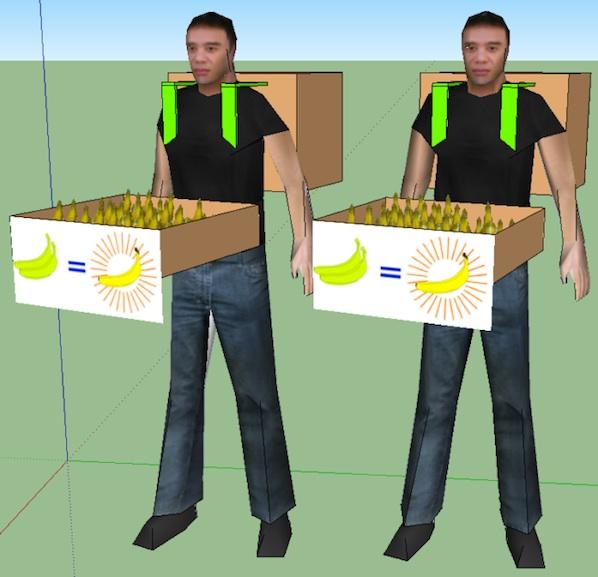

Inari Wishiki’s set of ludicrious alternative employment models (such as Banana Multiplier), are in reminiscent of the subversive, performative models of the Fluxus movement. Inari’s online work Recruit Agency for People Who Don’t Want To Work dramatizes this staging of an alternative labour market. The website includes documentation of a series of performances by the artist exploring the premise that with the proliferation and development of technology, we as humans have lost our place in the world of work, and yet still need to appear to be “useful” in order to earn a living.
Recruit Agency For People Who Don’t Want To Work is a set of systems which allow people to engage in the act of commerce while abandoning “all the meaningless rituals of having to be useful in order to earn money”. In INARI TRADING CARD, the artist documents the way in which “essential” workers function as a social infrastructure. He observes that “money was naturally following those workers according to their essential motions, unlike that of workers who seek after money”. These set of performances are an ironic counterpoint to the hyper-efficiency promoted by neo-Taylorism, and point towards the informal norms that are in tension with the industrial time norms still permeating social analysis, legislation and policymaking in the globalization era.
In his text “The Value of Time Spent” in the accompanying catalogue to the exhibition, Mike Stubbs supports this strategy of “design for disassembly” and novel values of exchange. Stubbs maintains that these alternative ecologies of exchange are necessary in order to allow us to question how we spend our time, and for us to lay bare the new patterns of professional fulfilment and social relations inherent to our hyper-mediated society.
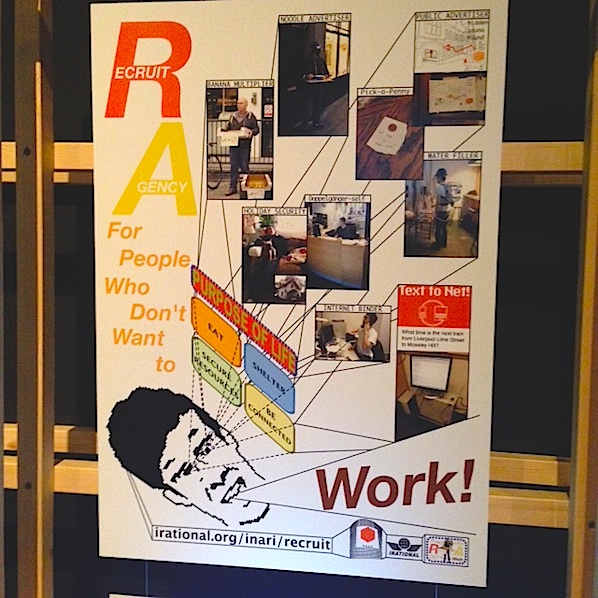
The classic distinction between the workplace and the home was forged in the industrial age, and when today’s labour market regulations, labour law and social security systems were constructed, the norm was a fixed workplace. This model has now fragmented and crumbled and the term social factory, popularized by Tiziana Terranova and others, is applied to describe this shift “from a society where production takes place predominantly in the closed site of the factory to one where it is the whole of society that it is turned into a factory – a productive site”.[8] The production is one of value, where the collective efforts of intelligence and creativity are networked, controlled and exploited. Labour takes place everywhere, and the discipline or control over labour is universally exercised. But policies are still based on a presumption that it makes sense to draw sharp distinctions between the workplace and home – and between workplace and public space. In a tertiary market society, this model is obsolete, leaving the information worker increasingly pressurized and isolated.

One of the recurring themes in Time & Motion is this hybrid and compromised locus and infrastructure of the work place. Harun Faroki’s moving image work A New Product presents an insider’s view of the paradoxical construction of so called “fluid” working environments. He describes his new film as: “Scenes from meetings within a company which advises corporations how to design their offices — and the work done there. The film shows that words are not just tools, they have become an object of speculation.” In this work, he stages the brainstorming sessions of a business consultancy specialising in the design of workspaces, offices and new concepts for mobile work hubs. The resulting seductive imagery of the ideal workspace is an exercise in brand development pastiche rendered as pseudo video game.
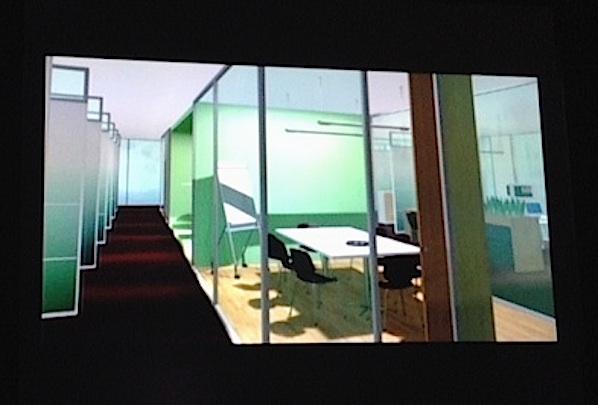
Time & Motion also stages a co-working space, developed by the RCA CX team, which weaves together venue, audience, workspace and digital space – presenting the entrance space of the gallery space into a live research ‘lab’. Visitors are encouraged to participate in the research, interaction and interventions, and workshops, salon discussions, and hacking and making sessions are woven into the experimental fabric of the exhibition.
The ‘CX Co-Working Space’ features three design interventions. The first, Hybrid Lives, features video work by Karen Ingham and an interactive installation responding to data traffic, dressed with ‘co-working furniture’. Where Do You Go To? is a wall-mounted moving freize showing the output from an app, co-designed with a group from the BBC, with the mission to connect remote workers through exchanging, Snap-chat-like (pre-hack) images of desks and workspaces. According to Ben Dalton, one of the main developers, this sharing of ‘desk context’ helps form a synergy of ‘headspace’ between remote workers.

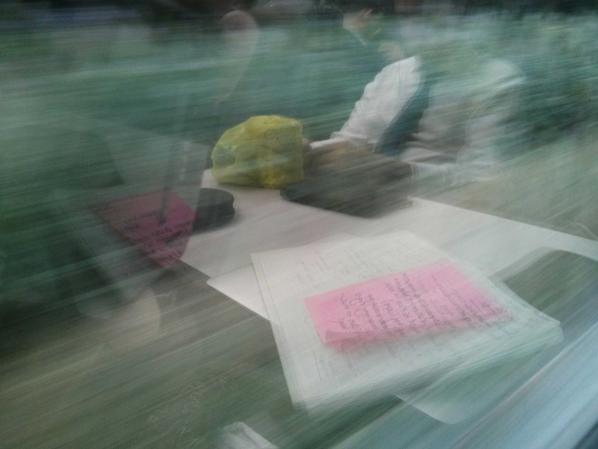
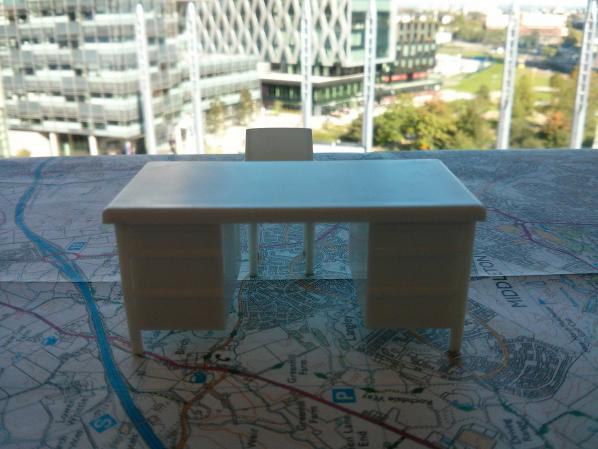
Taking its cue from Frances Cairncross’s 1995 “The Death of Distance”, where the compelling vision that, over time, the communications revolution would release us from geographic locations, the project illustrates how digital space has redefined our working lives. However, for all its good intentions, this gesture towards remote solidarity seems to be muddying the new principles and rhythms of work with Taylorist and later Fordist ideals of panoptic surveillance and somehow stands in direct opposition to the emancipatory rhetoric of convergence culture.
Time and Motion focuses primarily on a particular demographic of labourer (generally the global information worker), and paints the picture of a tertiary lifestyle which involves multitasking without control over a narrative of time use, and habitual fractured thinking – where non-stop interactivity (a digital version of Taylorist motion) is crack cocaine for the drones. For this category of workers, the workplace is everyplace – diffuse, unfamiliar, a zone of insecurity. We are left with a “thin democracy” in which people are disengaged from political activity except when jolted into consciousness by a shocking event or celebrity meltdown witnessed virally on Youtube during office hours. As more work and labour takes place outside the pre-determined workplace – in the hybrid environments of cafes, trains and across the domestic landscape – the very idea of a work/life balance seems like an alien ideal to aspire to.In an open tertiary society, the industrial model of time, and the bureaucratic time management of factories and office blocks, breaks down. There is no stable time structure and we are increasingly losing our grip on our own time. Time and Motion at FACT interrogates the impact of this fragmentation on the aesthetic forms of contemporary art, and contemplates how artists might offer a critique of our neo-Taylorist predicament.
Read and learn how to solve a Rubiks Cube with the layer-by-layer method. It can be learned in an hour.